Francesca and Henk-Jan's Backpacking Trip!
Friday, April 30, 2010
Hanoi - Always On The Move
On the 27th of April Francesca and I arrived in Hanoi. We checked-in at a suggested hotel and relaxed for a little while. It is rough taking sleeper buses all the time! Francesca checked the Lonely Planet and found a good pizza place, Pepperoni’s Pizza, to go to for dinner. Anyways, the 28th was our first day out in the city. And our first destination was to visit Uncle Ho! Around 9:00 AM we got in line for entrance to the memorial. We quietly walked through, taking a look at the embalmed body of the North Vietnamese leader. Strange! He looked almost like a dried-out wax figure. Francesca had the following to say about Ho Chi Minh’s remains: “I looked at the skin on his fingers – it was tight, dry, and appeared to be almost melted onto his bones.” Ho Chi Minh had not wanted to be embalmed, however, he actually specified in his will to be cremated and have his ashes scattered in all three (North, Central, and South) Vietnam areas.
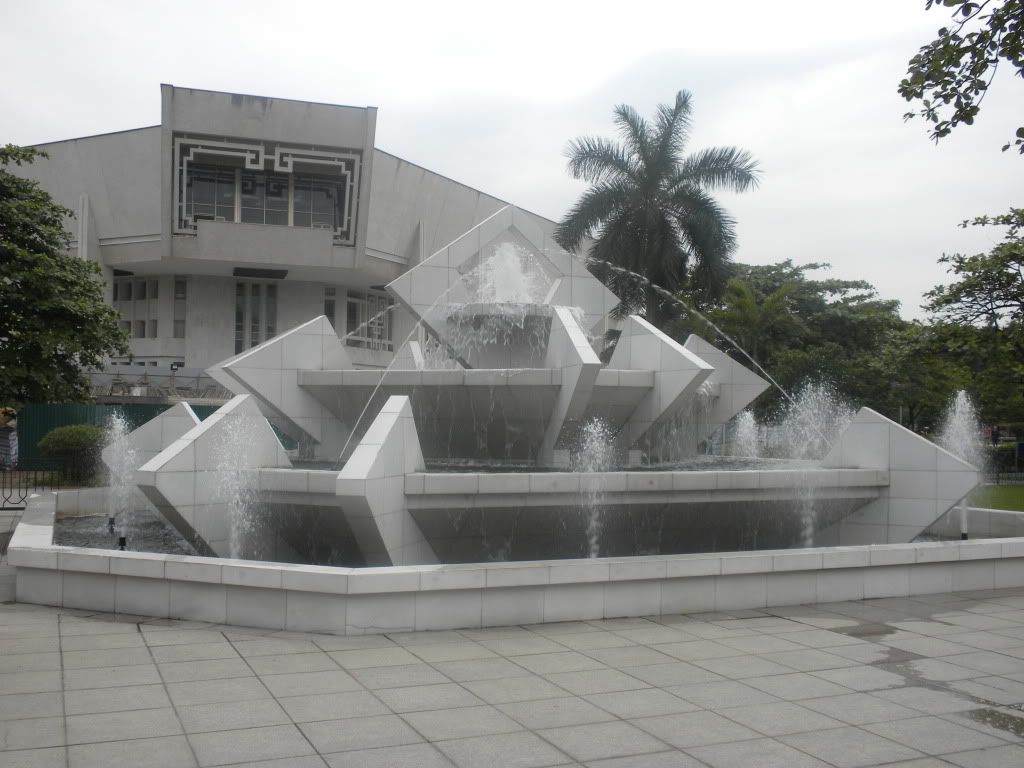
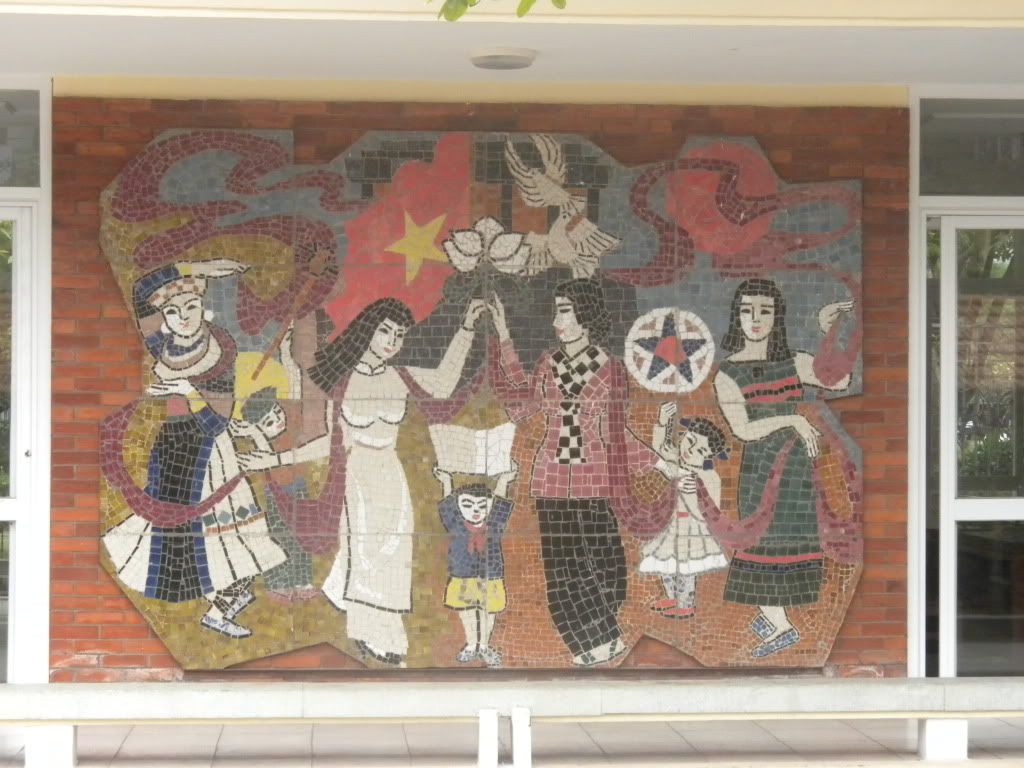
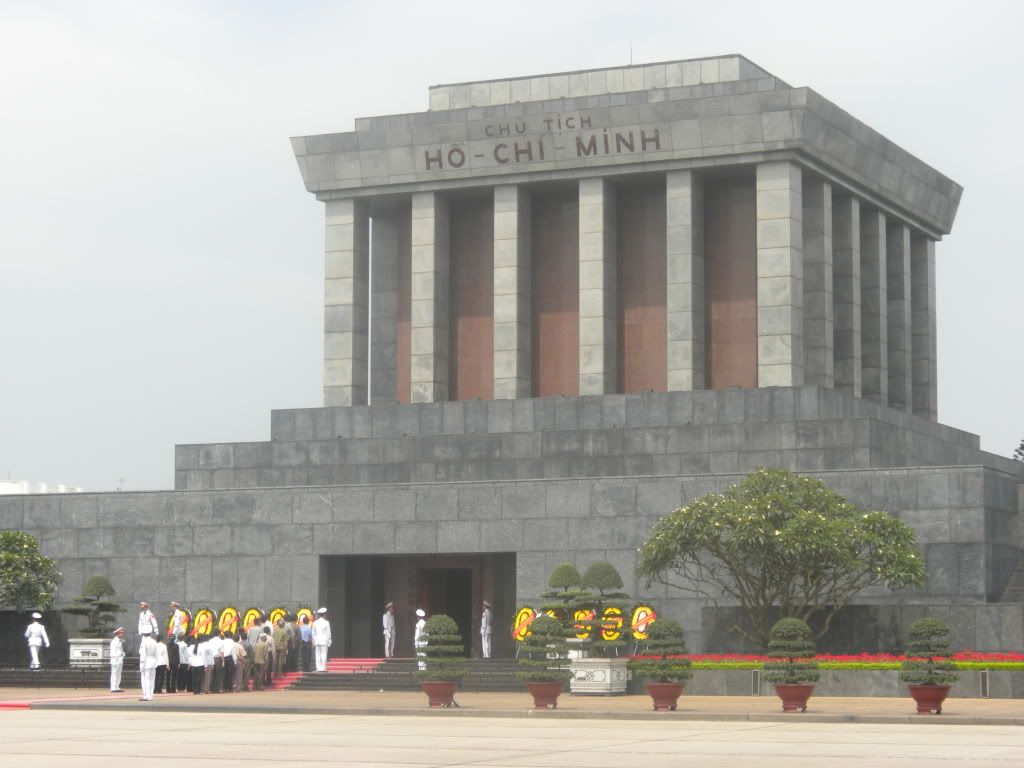
After walking through his ‘tomb’ we passed by the Presidential Palace. We couldn’t go inside, but we did get a few pictures of the building. Next we headed towards the Stilt House of Ho Chi Minh, passing through the cases which contained his old cars on our left hand side. The stilt house was actually pretty simple with just a writing desk, a small bed and some basic furniture standing around. We followed the crowds and ended up at the Ho Chi Minh Museum. The name gives the impression it’s all about Ho Chi Minh, but in fact that’s only partially true. A large bronze Uncle Ho greeted us when we entered. We saw some pictures of him and his family life, but then ended up in an artsy glass maze with paintings and drawings from all different eras. Another section was dedicated to Guernica. It definitely gave us an eerie feel. Perhaps this is the aim of the museum as it doesn’t so much as tell the story of Ho Chi Minh’s life per se; instead it tries to mimic the feeling of the time. A final section was reserved for the Communist Party and told its story.
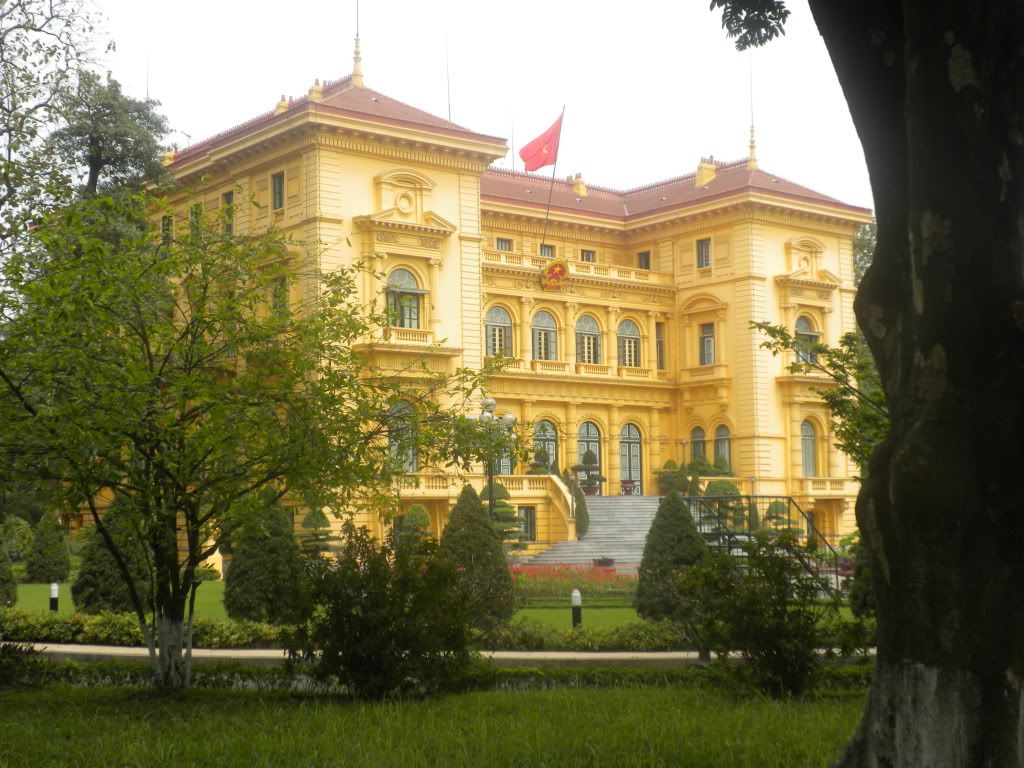
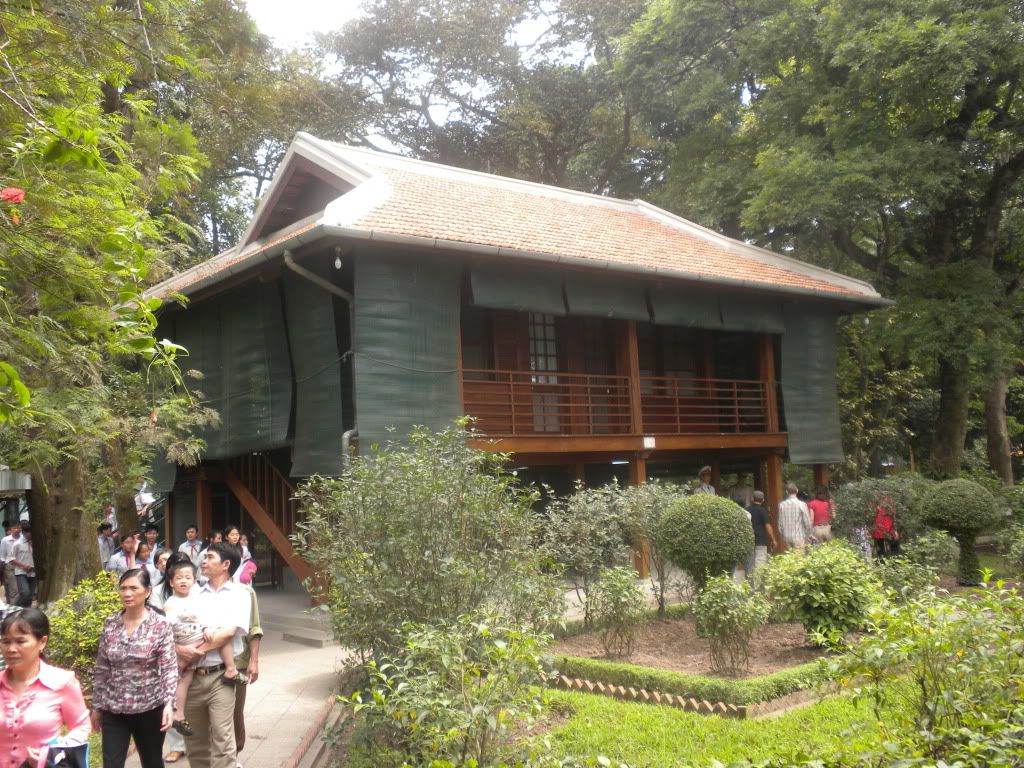
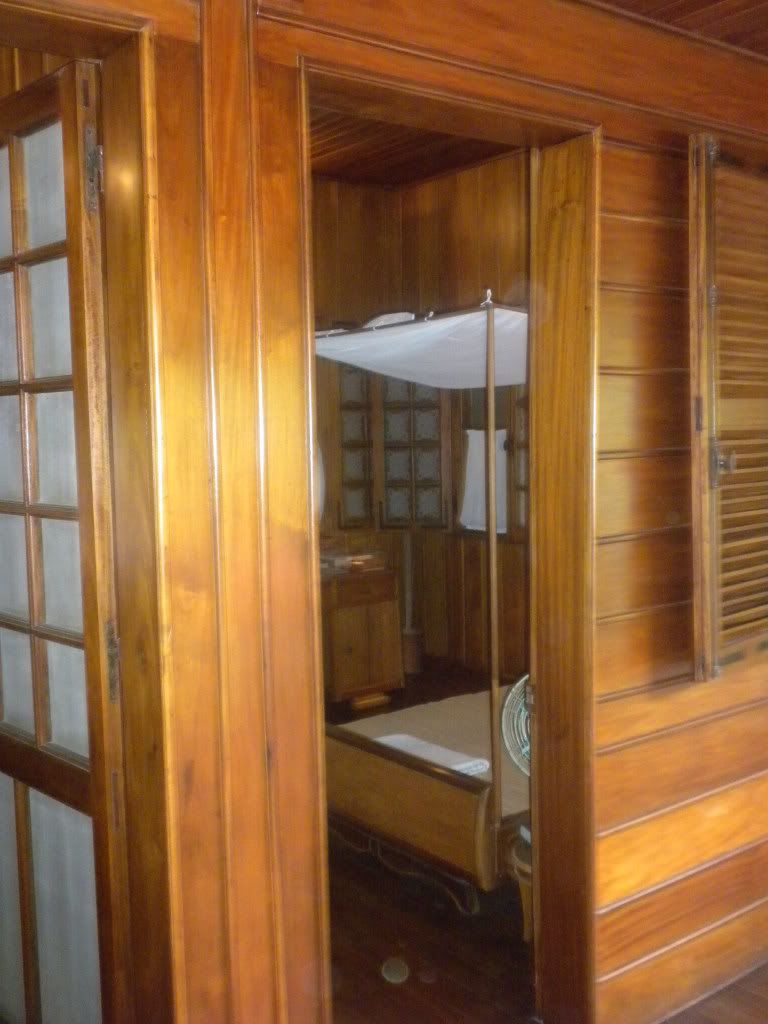
Since the Museum only broadly covered Ho Chi Minh, here’s a little excerpt from the Wiki on the man:
“Ho Chi Minh was born Nguyen Sinh Cung and also known as Nguyen Ai Quoc (19 May 1890 – 3 September 1969) was a Vietnamese Communist revolutionary and statesman who was prime minister (1946–1955) and president (1945–1969) of the Democratic Republic of Vietnam (North Vietnam). Ho led the Viet Minh independence movement from 1941 onward, establishing the communist-governed Democratic Republic of Vietnam in 1945 and defeating the French Union in 1954 at Dien Bien Phu. He lost political power inside North Vietnam in the late 1950s, but remained as the highly visible figurehead president until his death. The former capital of South Vietnam, Saigon, after the Fall of Saigon, was renamed Ho Chi Minh City in his honor.”
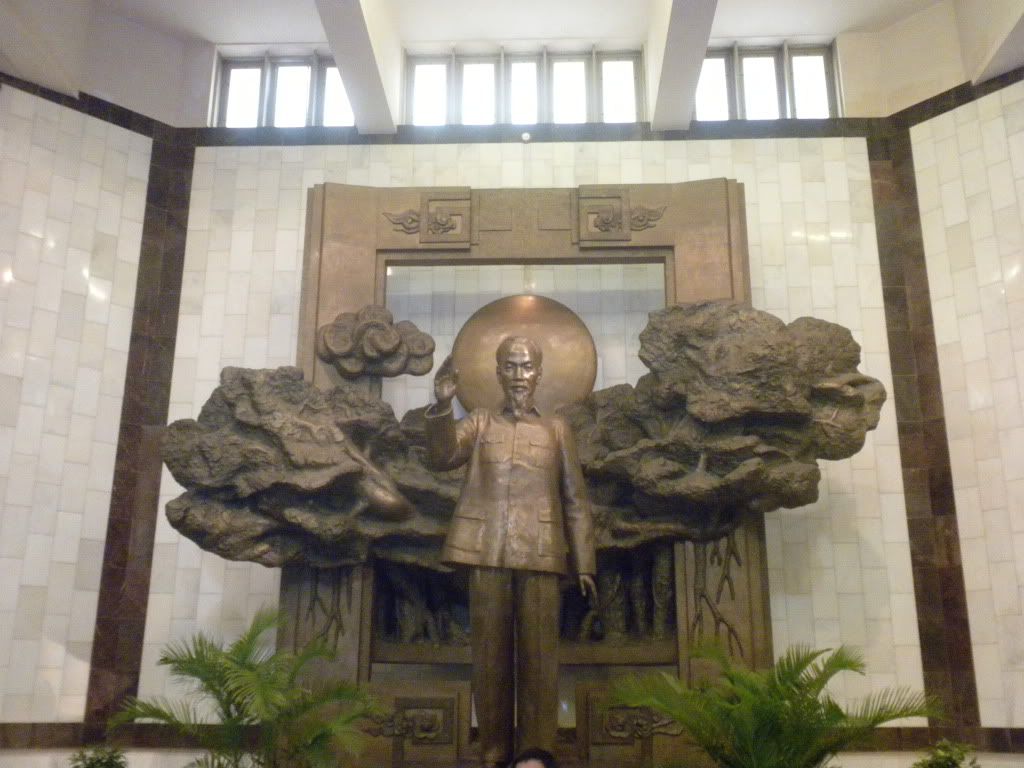
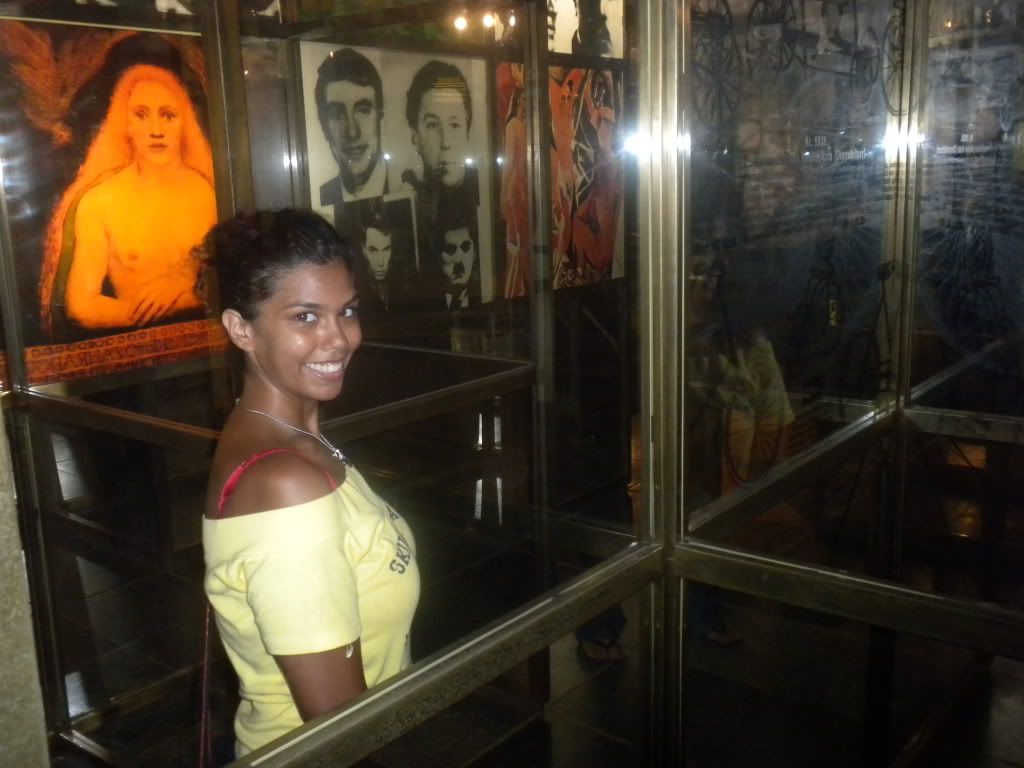
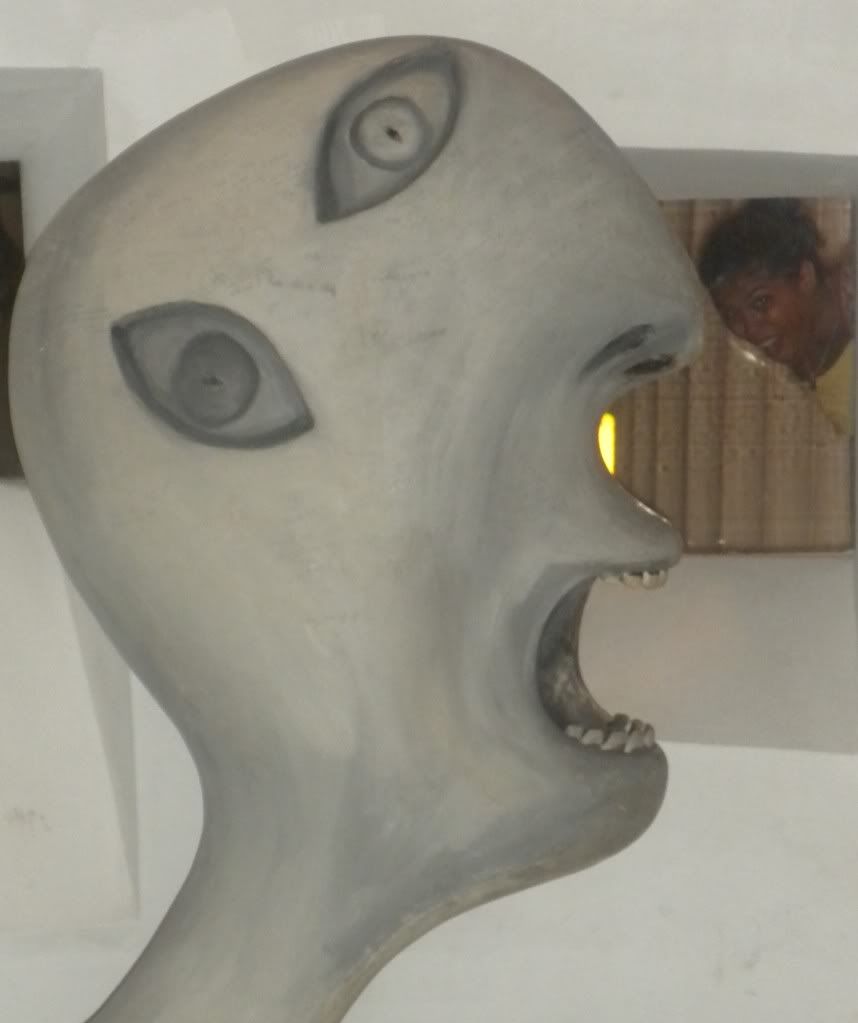
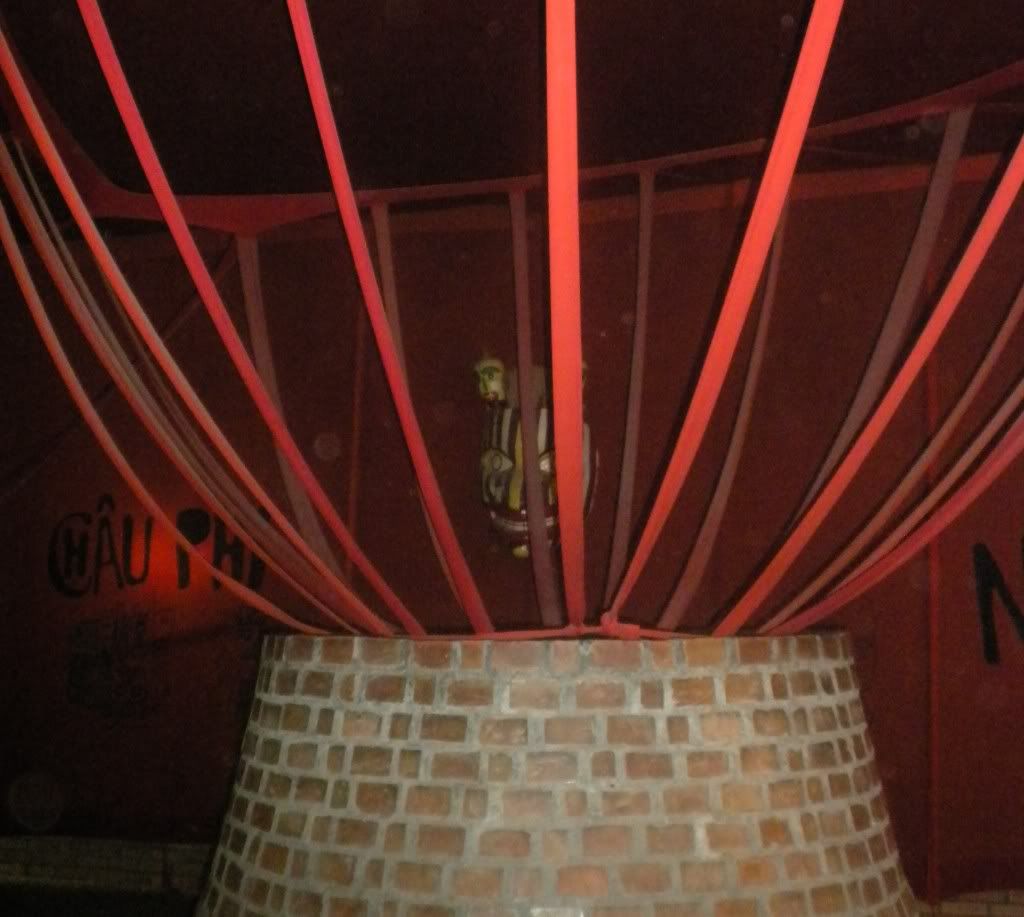
We exited the Museum after having a hot dog and a drink and headed for the One-Pillar Pagoda. Or rather, a miniature replica of said pagoda. The original was first built in 1049 under the Ly dynasty in the likeness of a blooming lotus on its stem. I took a few pictures before leading Francesca on to our next destination.
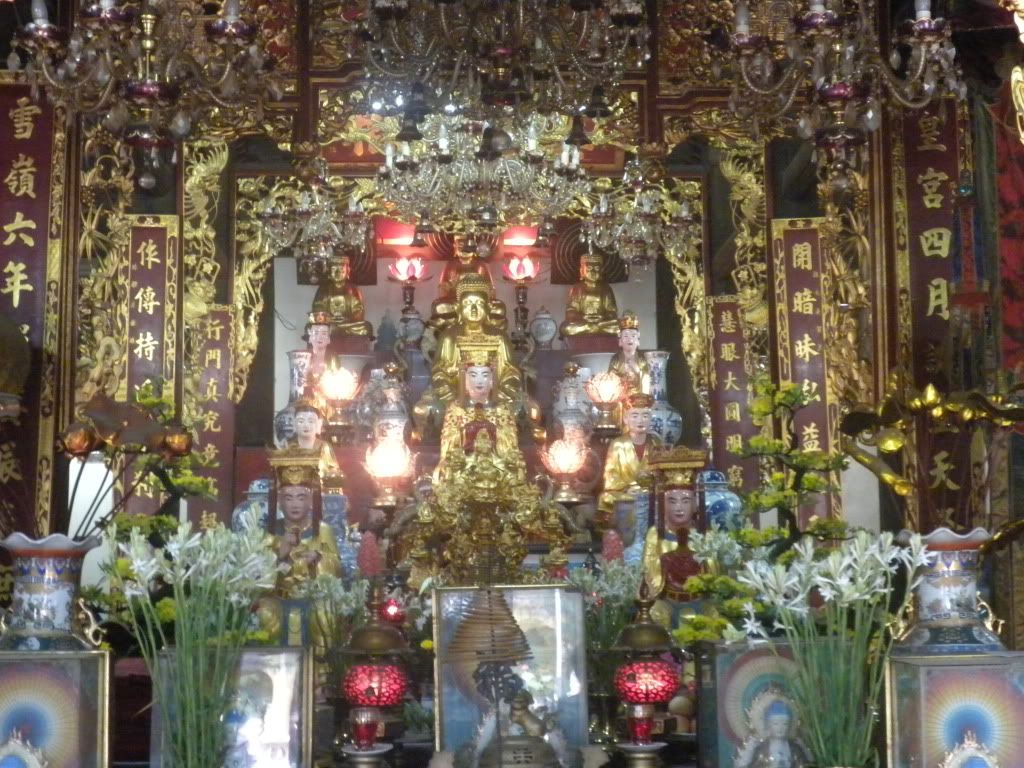
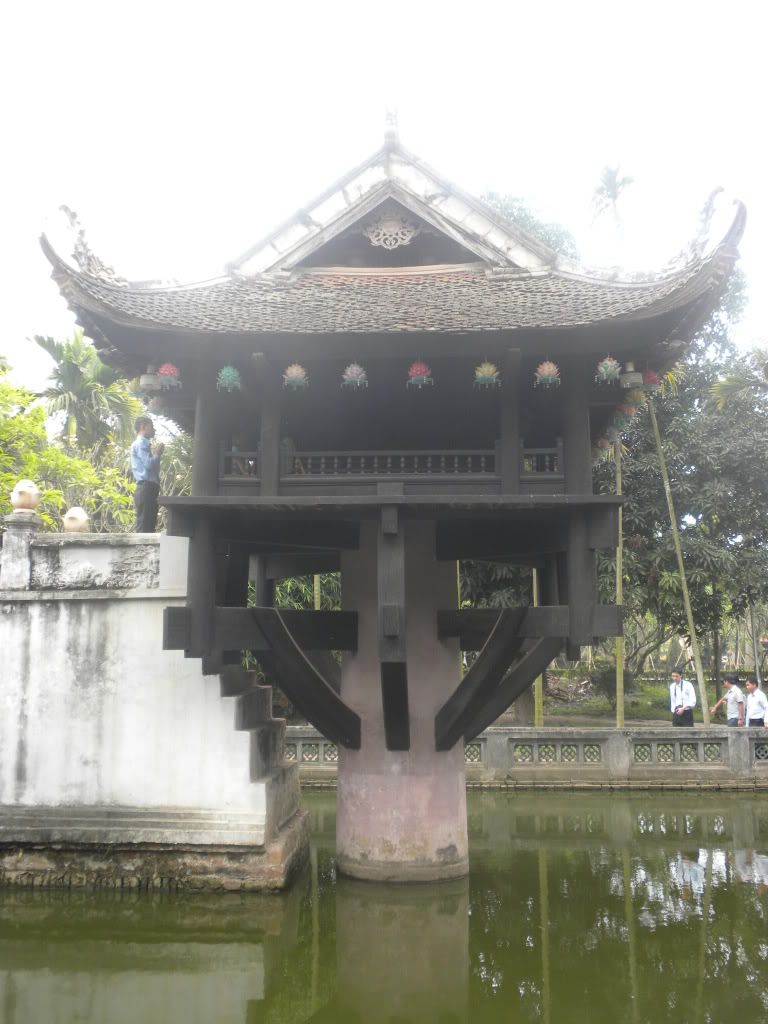
The Van Mieu-Quoc Tu Giam (Temple of Literature of the National University) was built in 1070 by King Ly Nhan Nong for the training of educated men of his kingdom. After nearly 1000 years it still stands and we got to enter the grounds. We learned how the students had to spend 3 to 7 years at the university, with tests each month. They all studied Confucius’ texts, as well as specializations. For graduation they were examined by the King himself. Sounds like a good way to up the stress levels! The inner courtyard was home to the Doctor’s Stelae: large stone pedestals which recorded the names and native places of the graduates at the university. A total of 1307 graduates and 82 Royal exams are listed on the stelae. The stelae were held up by the ancient Vietnamese and Confucian symbol for longevity and education, the turtle.
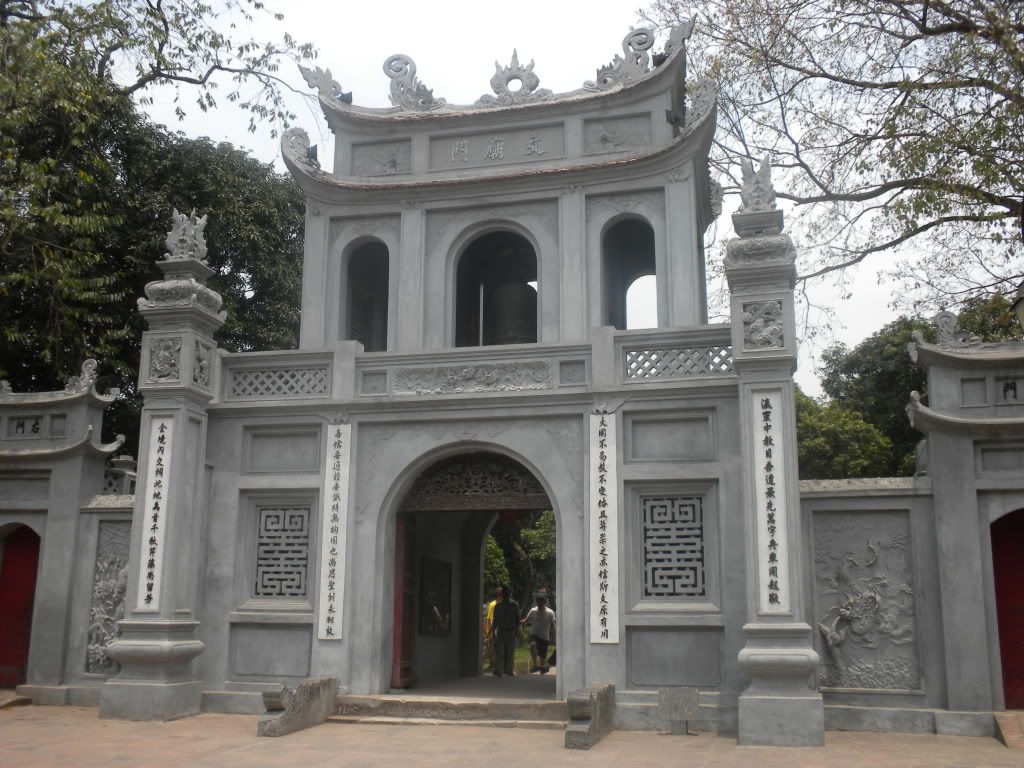
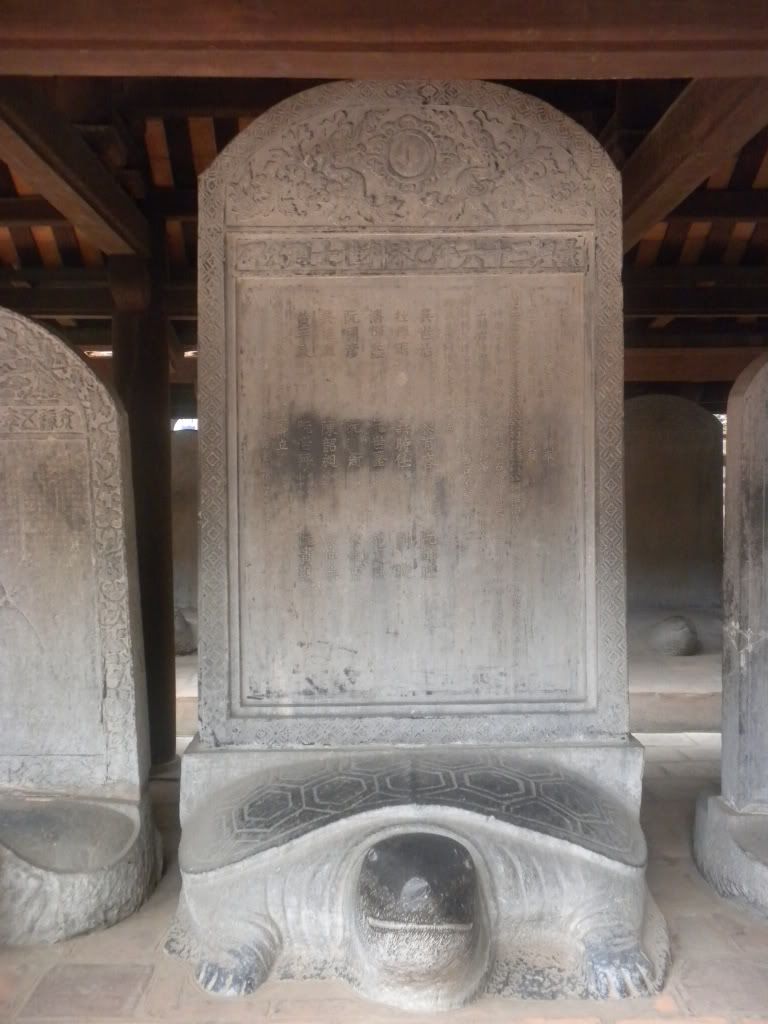
More walking was to be had after we realized the rest of the compound had been sealed off for renovation. Luckily the Vietnam Fine Arts Museum wasn’t too far away. We weren’t sure what to expect of this museum exactly, but gave it a go anyway. It turned out we had to follow a little map which led us from fine arts from prehistoric times to the 21st century. We weren’t allowed to take any pictures, but I snuck a few in to give you an impression of the pieces we encountered. It took us well over an hour to make it back to present-day art, but we were fairly impressed by the museum.
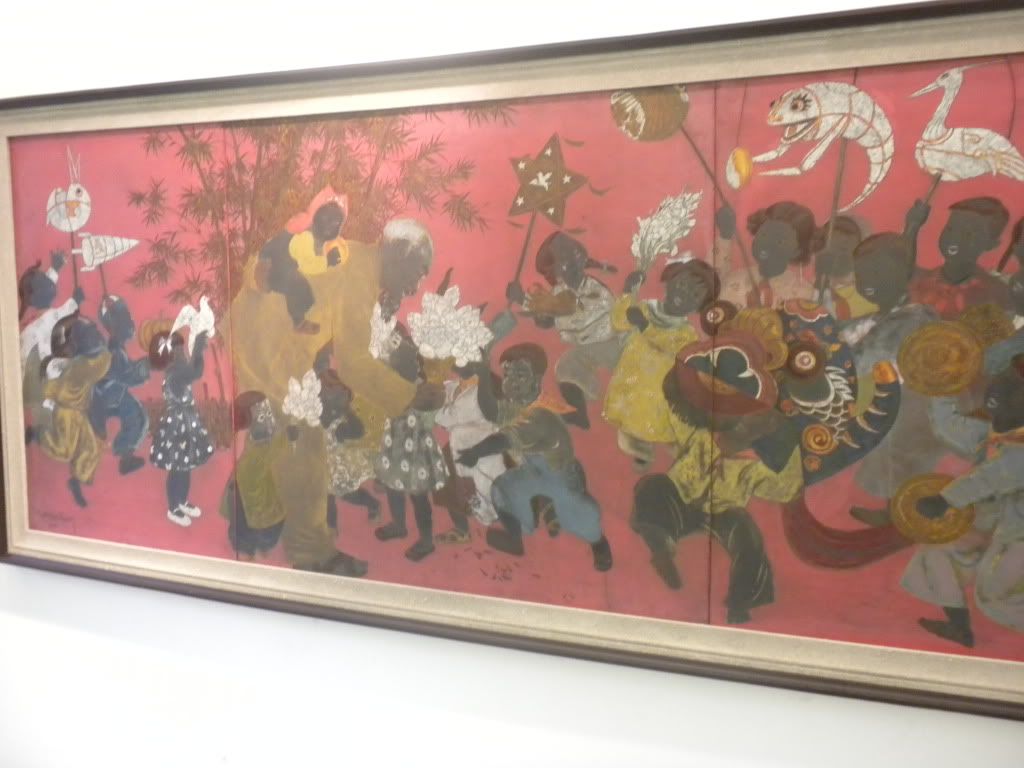
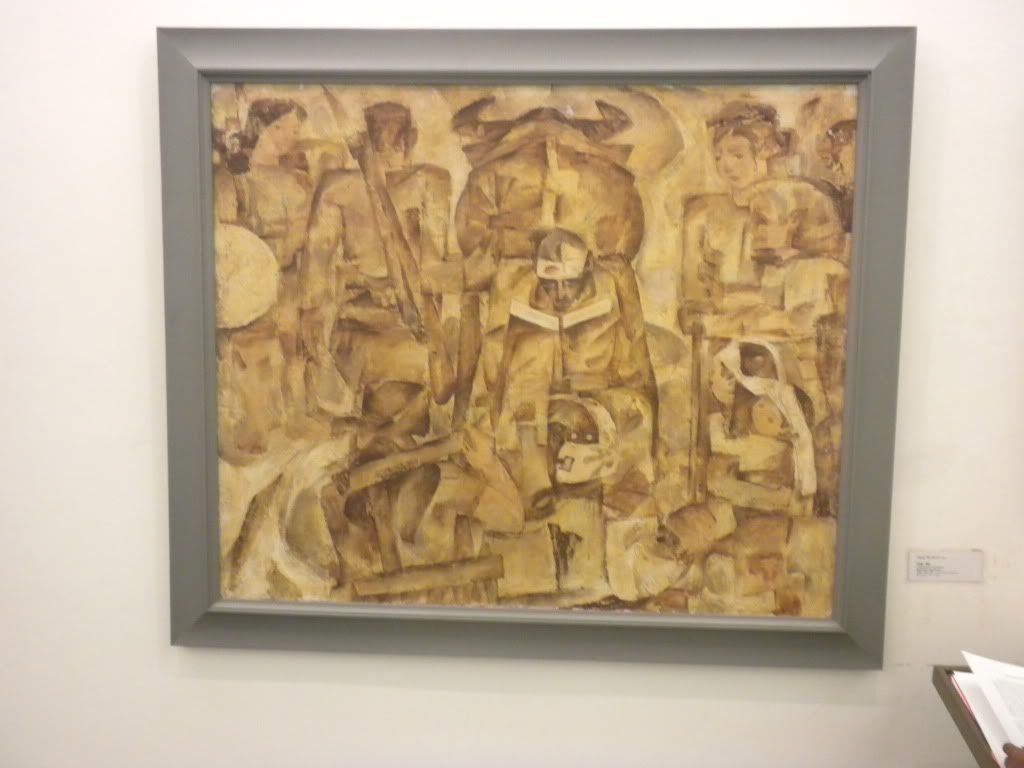
Museum-day was far from over, and Uncle Ho greeted us once again at the Vietnam Military History Museum. A relatively compact white building loomed ahead as we walked past an old T54B Tank to go inside. The museum quickly covered a few ancient battles before serving the main dish: cool dioramas of Vietnam War scenes, pictures of the war, guns used during the war, helmets with many bullet holes, and even a crossbow used to kill enemies (to prove the Vietnamese inventiveness!).
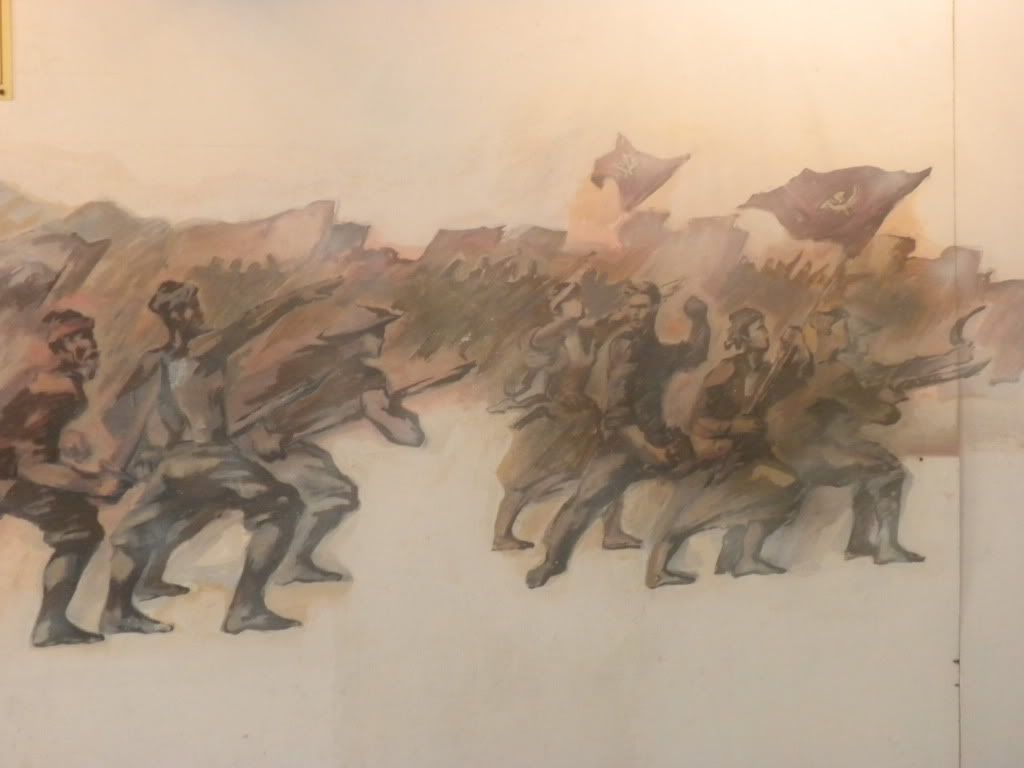

Since the museum was pretty small we continued with the Hanoi Flag Tribune right next to the museum. The large stone watchtower had been built from 1805 to 1812 under King Gia Long of the Nguyen Dynasty, but in 1954 the Communist Party decided to use it for propaganda purposes, planting a national flag on top. We climbed all the way to the top via the tiny spiral staircase; once there we realized the view was not that fantastic. A piece of art made of scrap from fallen planes and tanks, surrounded by more planes and tanks (still in one piece) was the highlight. We also saw that the museum stretched out for a few more buildings. More to explore!
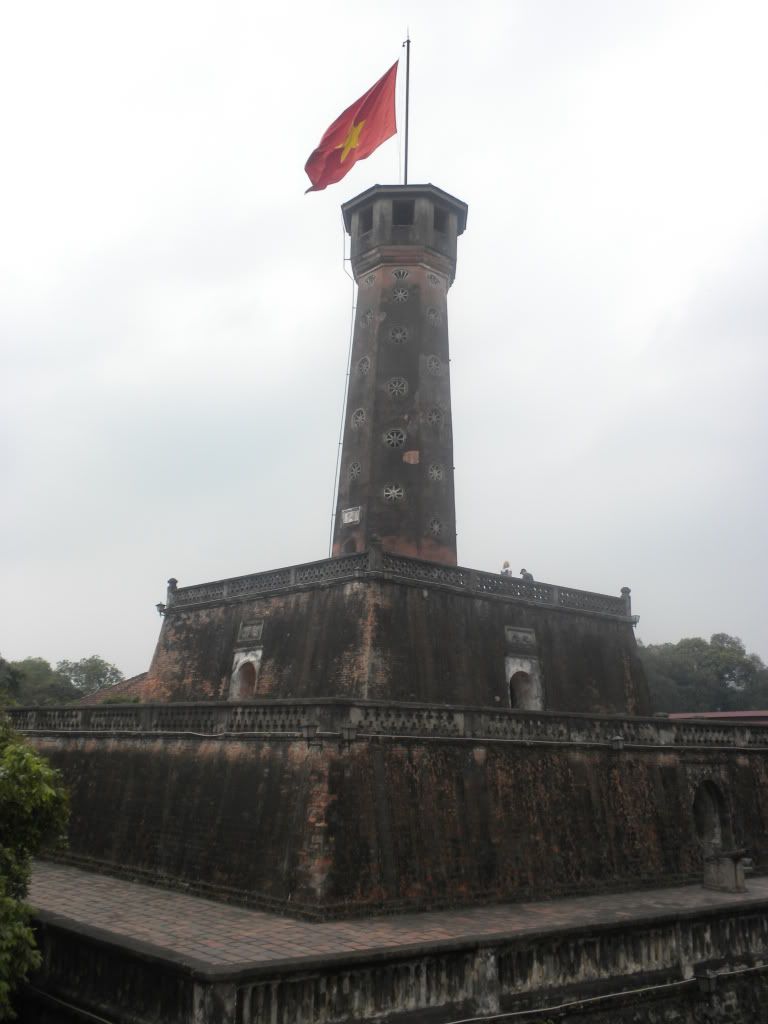
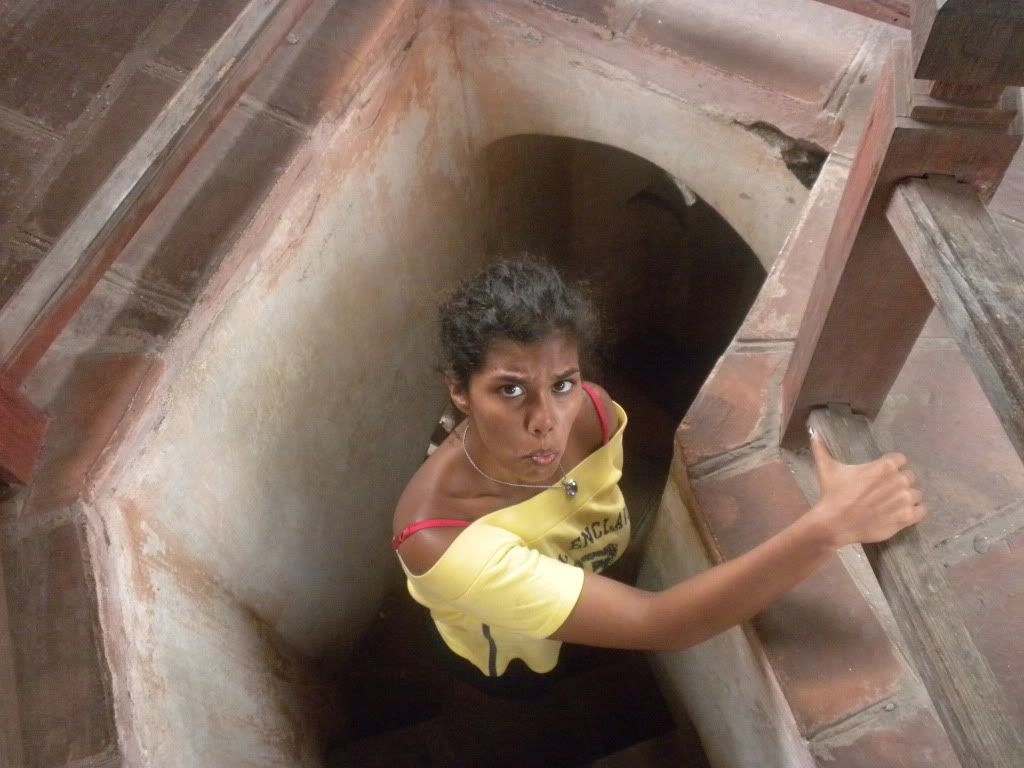
Even though the other 2 buildings were filled to the brim with pictures and artifacts we could make our way through pretty quickly. Translations were missing for most of the museum, so all we could do is take in the things we observed. The pictures did speak for themselves, as we saw more images of valiant VC and cowardly Americans, more VC heroics and American war crimes. We acknowledged the obvious one-sidedness, but were still left impressed.
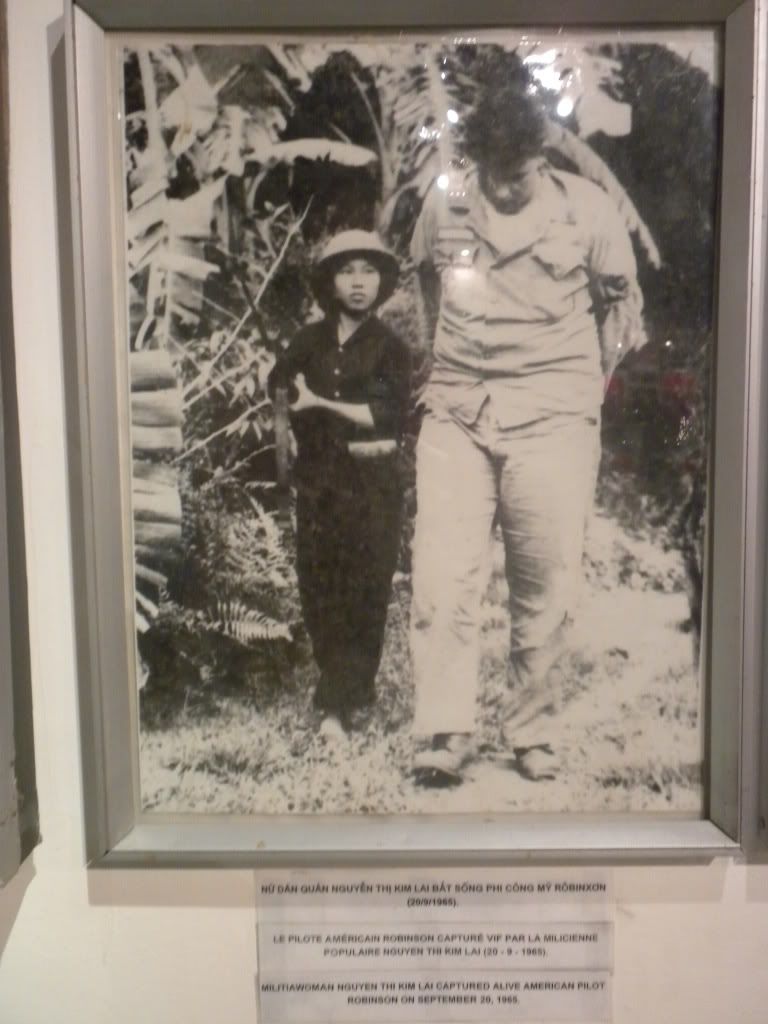
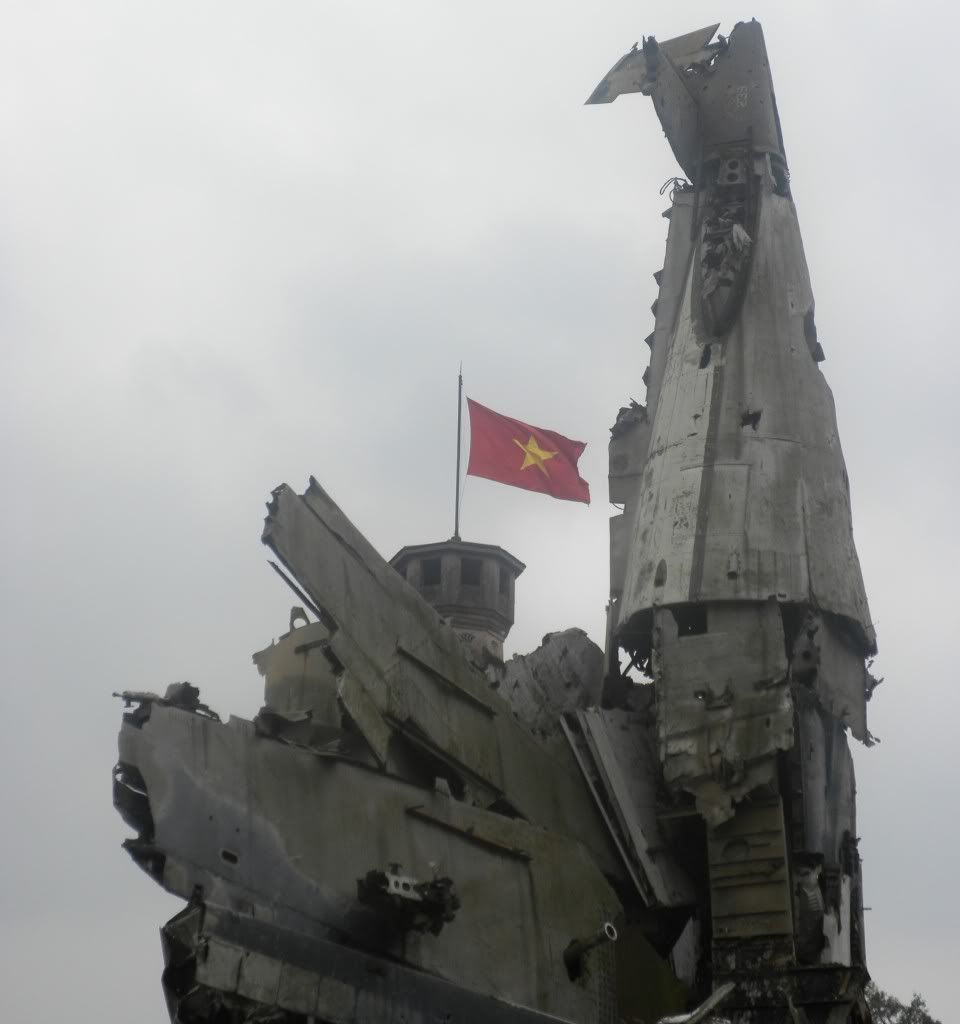
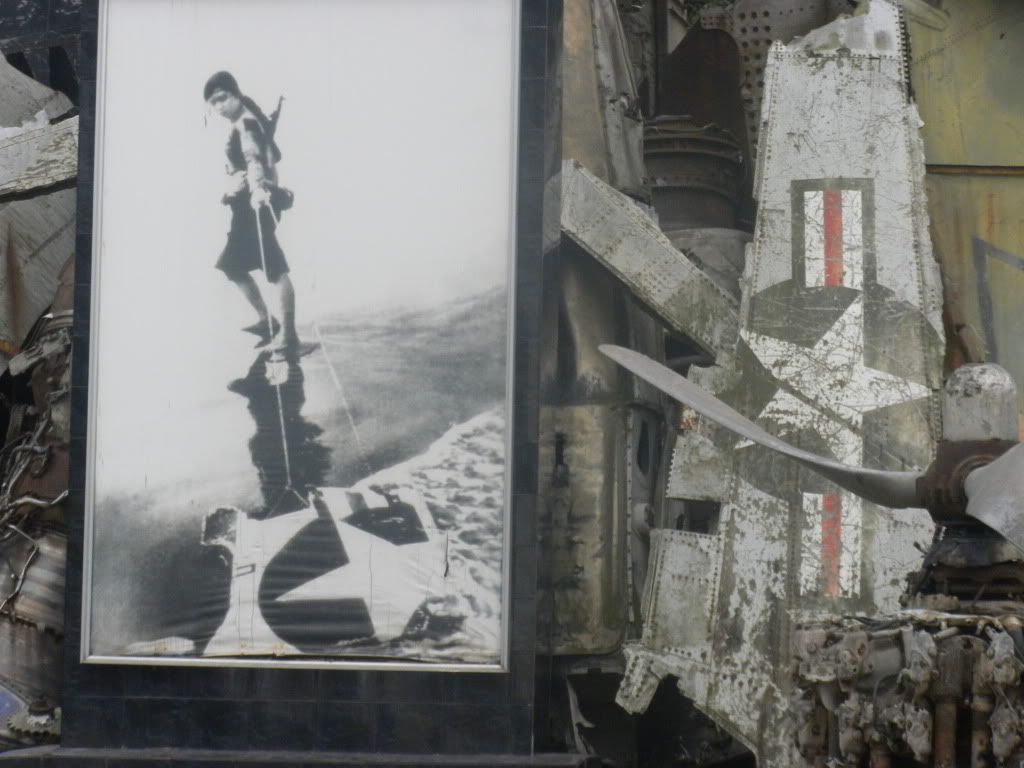
We stumbled across a random temple on a busy street, found the Hanoi Towers and finally the Hoa Lo Prison. Hoa Lo Prison, or the Hanoi Hilton as the Americans mockingly called it, was the home of most of the Americans Prisoners of War during the Vietnam War. Its most famous inhabitant was John McCain, who lost the American presidential election to Obama not too long ago.
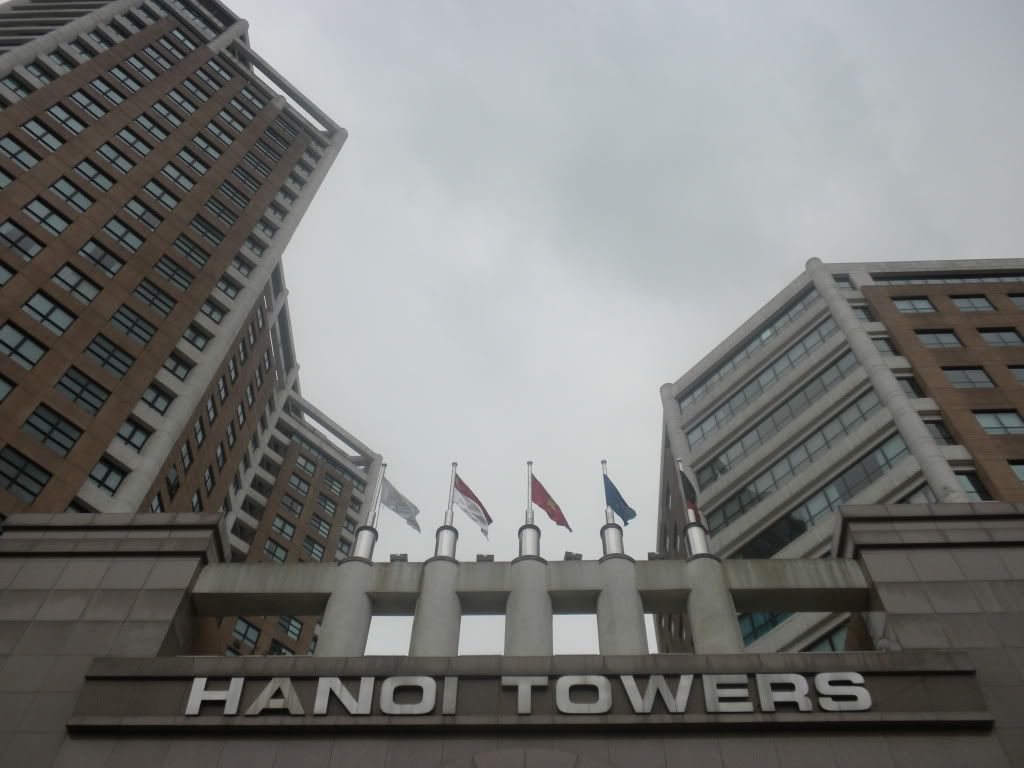
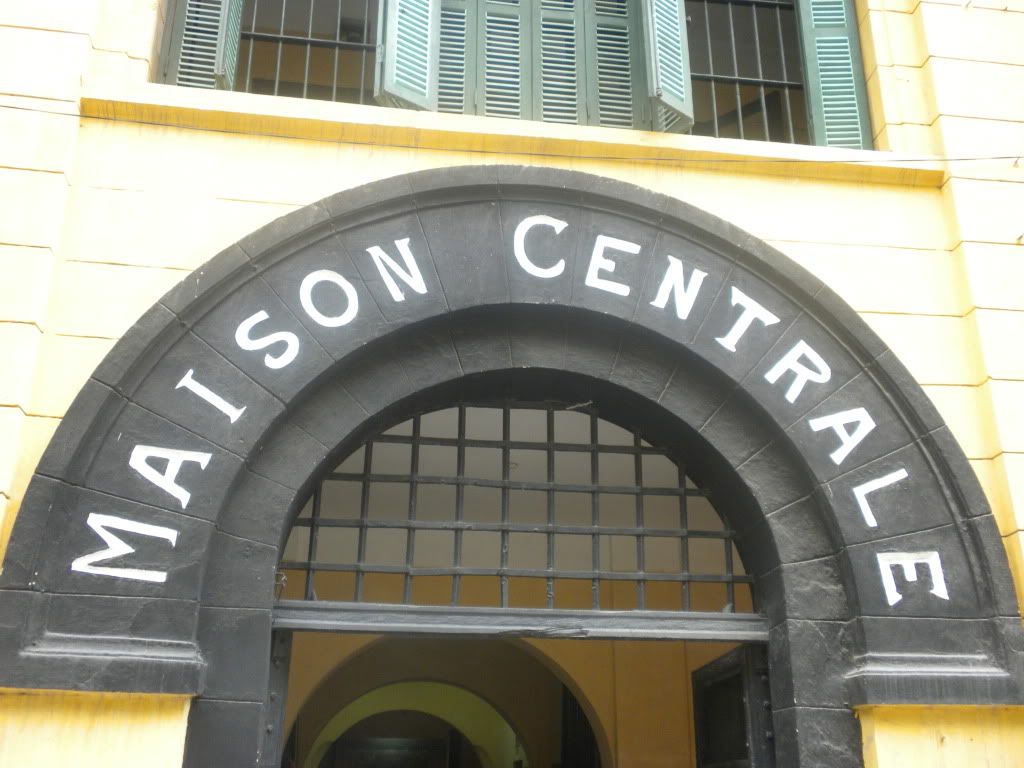
However, before McCain made his way to Hoa Lo the building had been taken over by the French in 1896. Formerly used for ceramics-making the French turned it into a prison for wayward Communists and Government members. Therefore the first section of the museum was dedicated to the hardships these Vietnamese endured. Malnutrition, torture and diseases were the leading causes of death during the following 40 years. We saw the cells where the real bad boys (and girls, as Francesca shows) were kept. Outside we learned the prison didn’t isolate the inmates all that well. An almond tree was the meeting place for the prisoners to discuss measures on fighting their captors. We learned that there were at least 2 successful escapes: 2 sewer doors with sawed-out stiles were proof of the escape route taken over half a century ago.
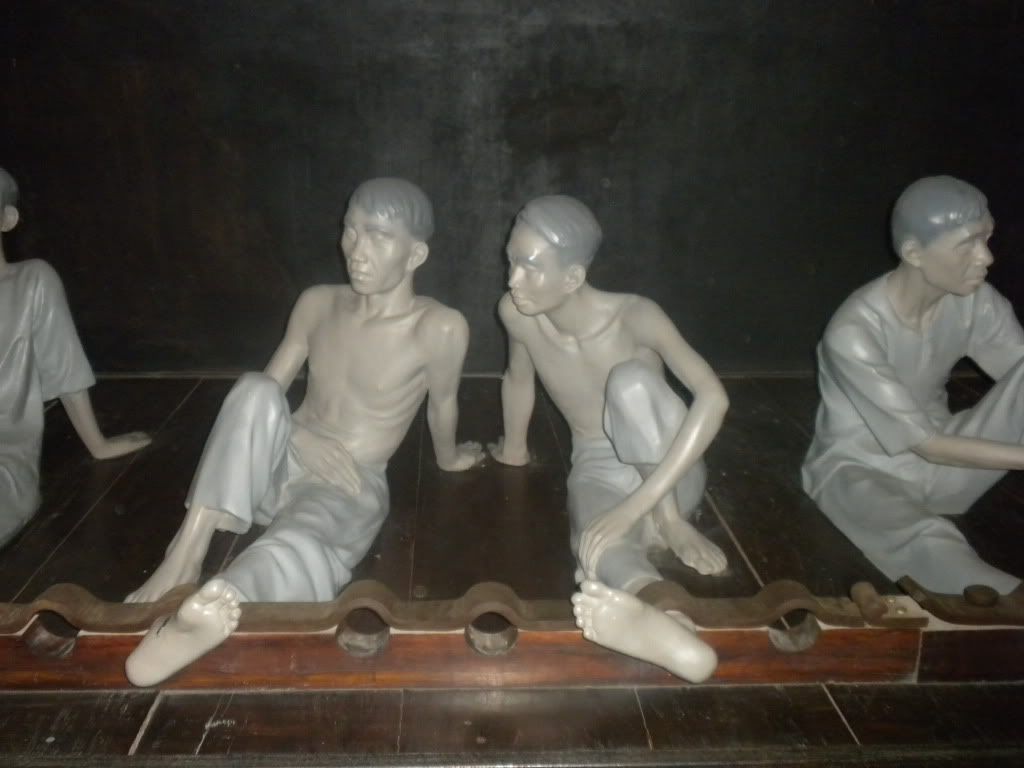
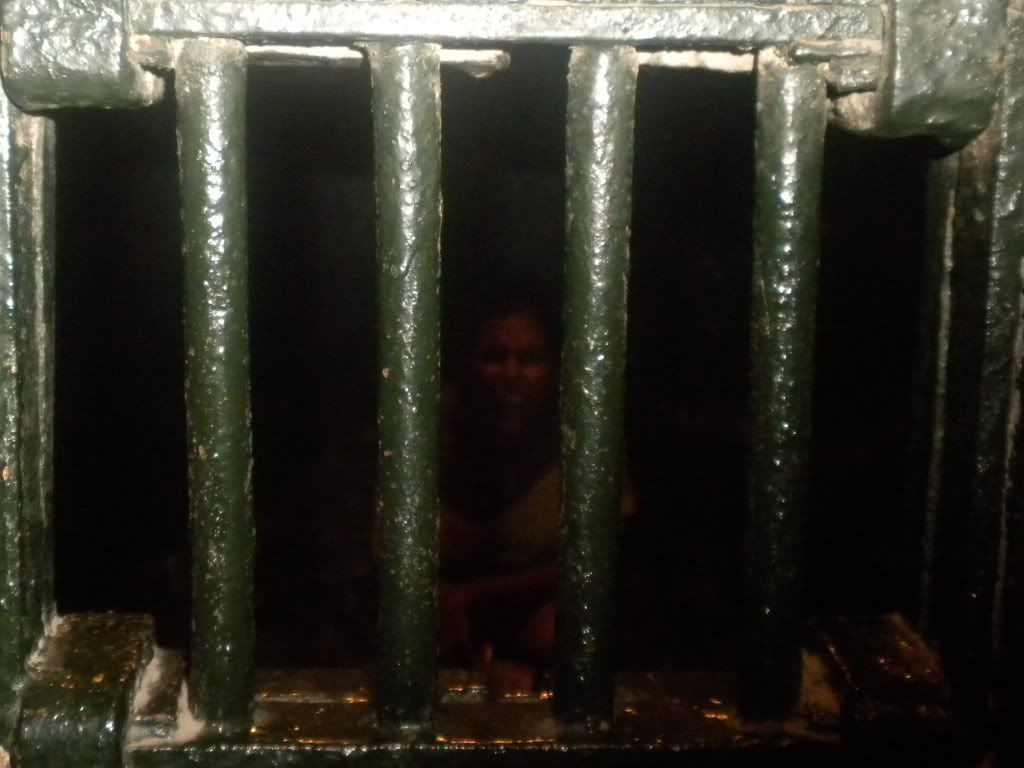

In the next section the prison female inmates were locked up. We saw torture materials in the form of bottles, barbed wire and sharpened bamboo; we could only imagine how they were used. Eeek! Right past the women’s cells were smaller cells, some of which had contained American PoWs. From French occupation we went to Vietnamese rule, checking out a memorial for the fallen during the French period.
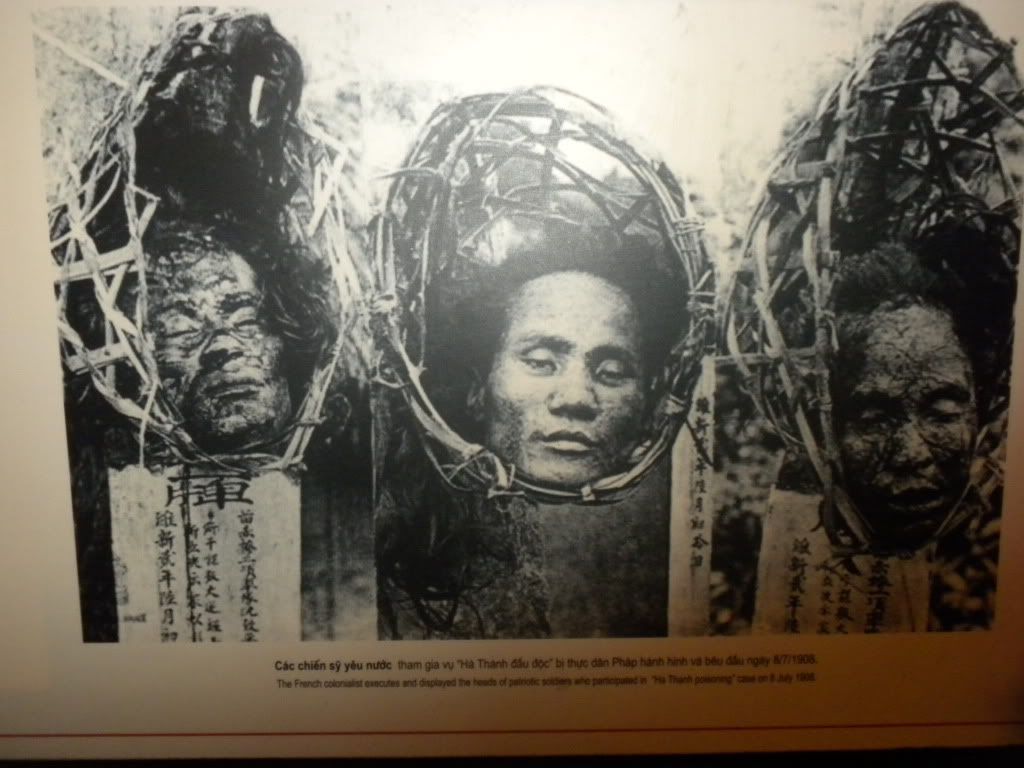
The texts on the wall claimed that the “national economy was difficult but the Vietnamese government had created the best living conditions to U.S. pilots for they had a stable life during the temporary detention period.” There were pictures of rescued American pilots, amongst which we found a shot of McCain being dragged from his plane in a lake. There were happy Americans playing basketball and chess, receiving presents and letters from back home, and enjoying a filling Christmas dinner. Of course, the reality was a little different as we watched ‘Hanoi Hilton’ and read some stories by survivors of Hoa Lo. The truth is never black or white.
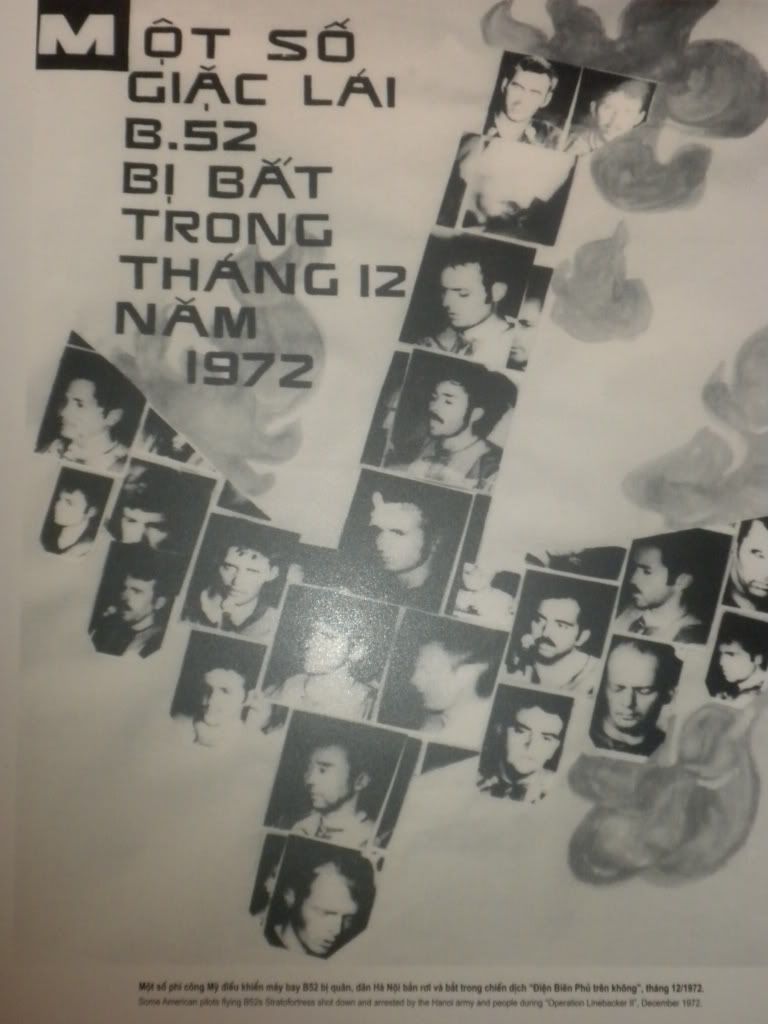

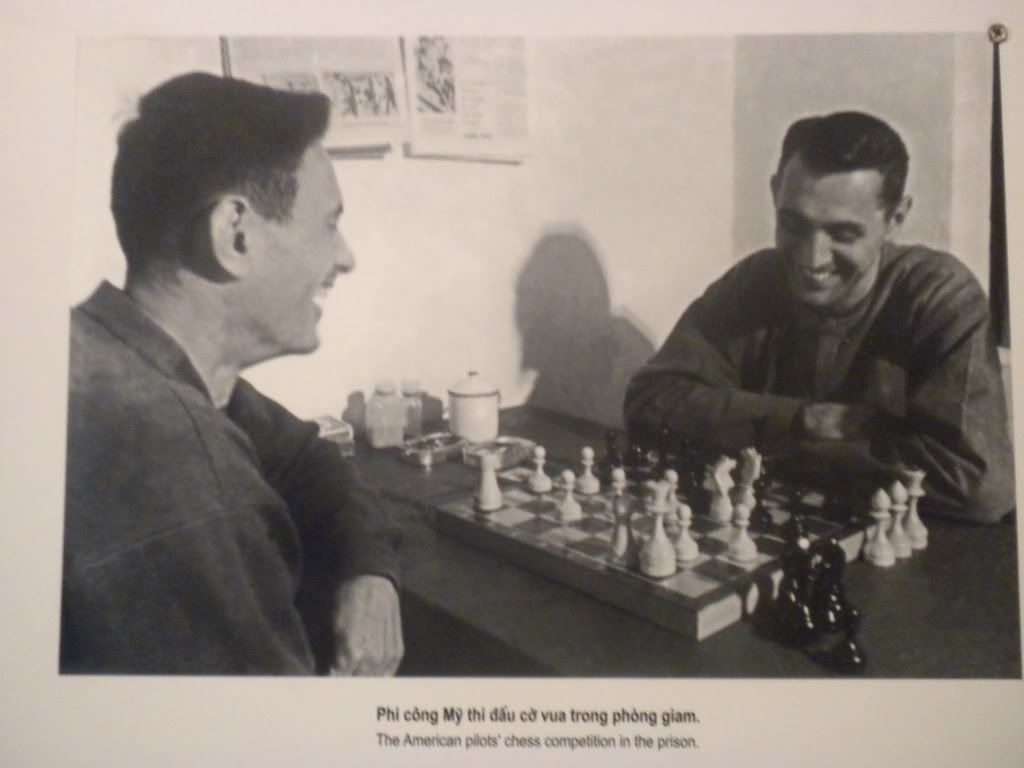
Closing time for the museums had come and Francesca and I were tired of walking. We hadn’t made use of the tricycle drivers in the city yet, but decided to do the tourist-thing and jumped in one to bike us back to our guesthouse. The poor old man looked like he was having a hard time biking us around, but he made it there eventually and he was happy with the tip I gave him.
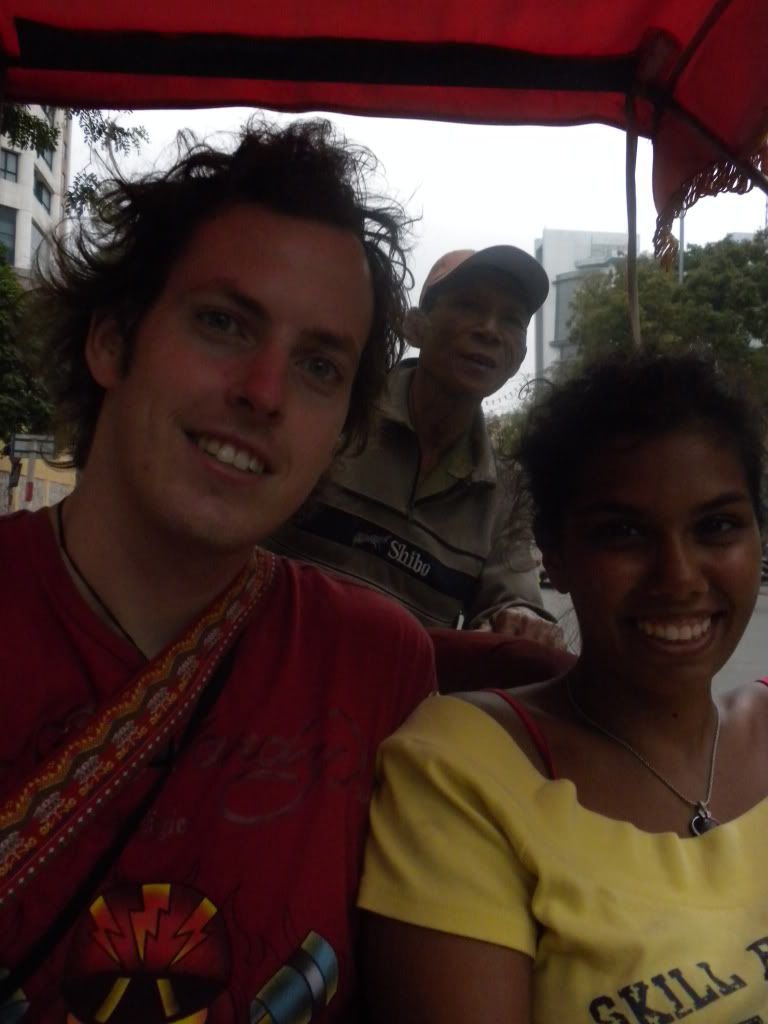
The next morning we got up early once again to visit more educational and historical sites. Francesca got very excited to see the Vietnamese Women Museum, which focused solely on (surprise, surprise) Vietnamese women. However, it was closed. And was going to be closed for a few more months. Saddened by this news went on our way to the National Museum of Vietnamese History, passing by the Hanoi Opera House and the actual Hilton in Hanoi. We got our tickets and entered to look at the prehistoric period in Vietnam. There were some artistic impressions of what the area might have looked like at the time. There were sculptures of Neanderthals and other steps of the human evolution. We jumped forward in time to about 500 B.C. when the locals had entered the Bronze Age and were making giant bronze drums with intricate decorations. The drums reflected life at the time, pictures of houses, people dancing or making rice, the nature around them have all been preserved through the skill of these artists.
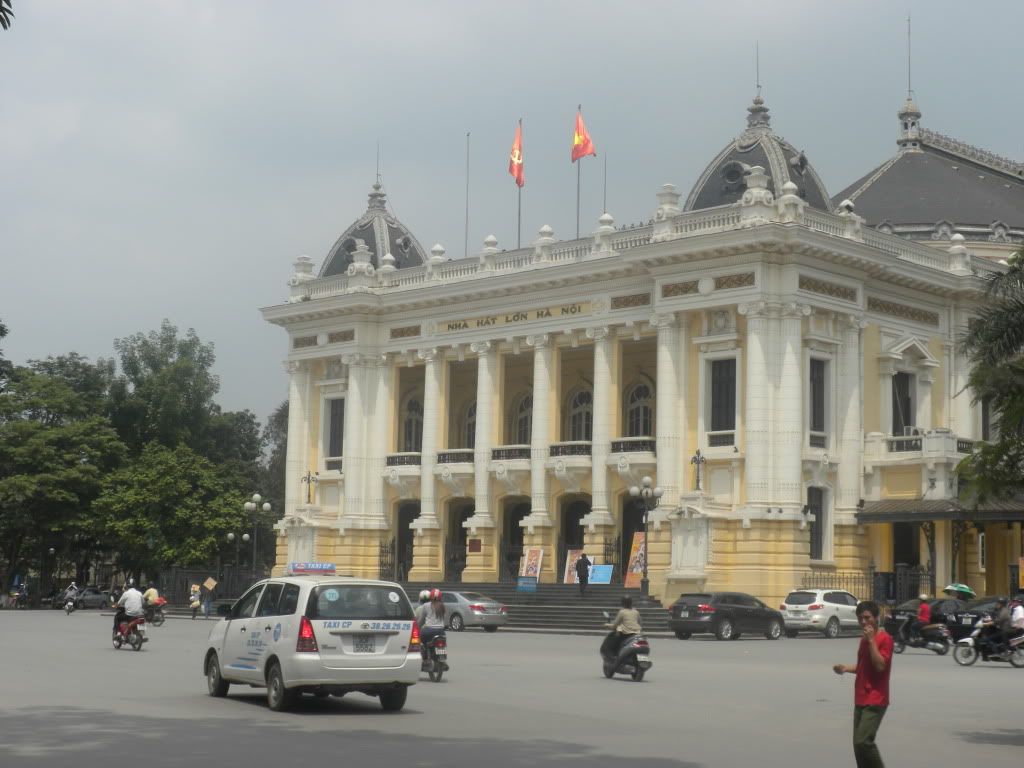
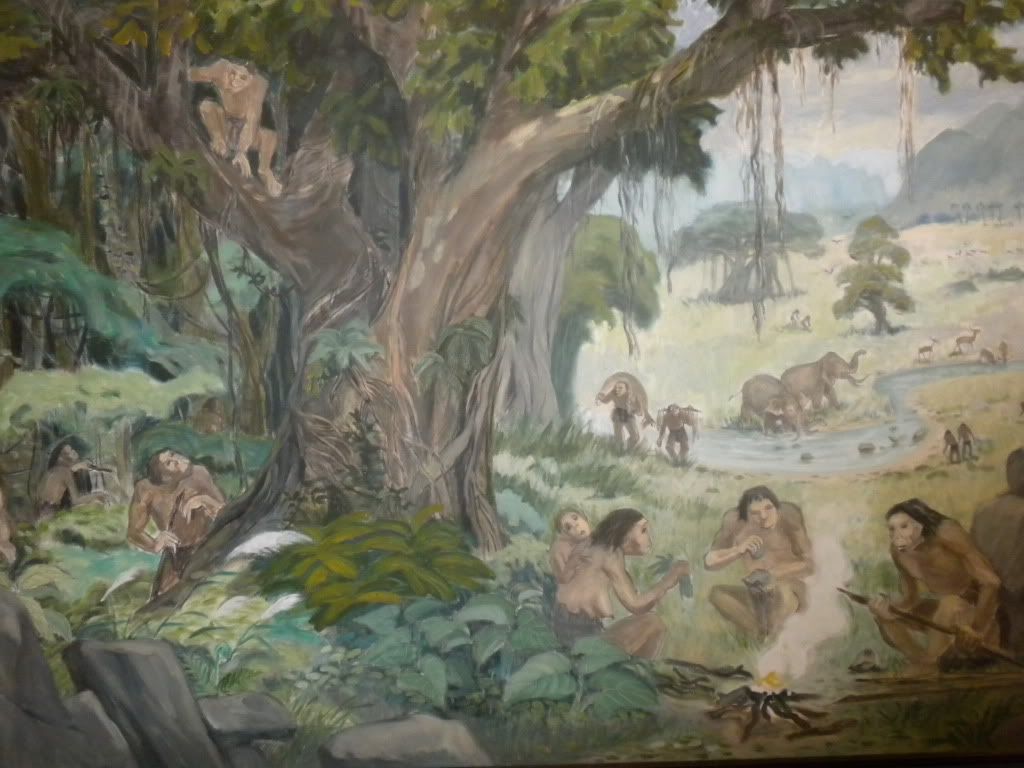
We followed the timeline and learned that around the same time people buried their dead in large stone jars. (Remember the Plain of Jars!) Several jars with bones and other artifacts had been found, supporting the theory that the Plain of Jars was in fact a burial site. We don’t know anymore… Next up were cool ancient earrings, old-school currency and little clay faces. We exited the Bronze Age, learning that the Viet people reached the height of their Bronze Age civilization with advanced agriculture, animal husbandry, fishing, pottery and weaving.
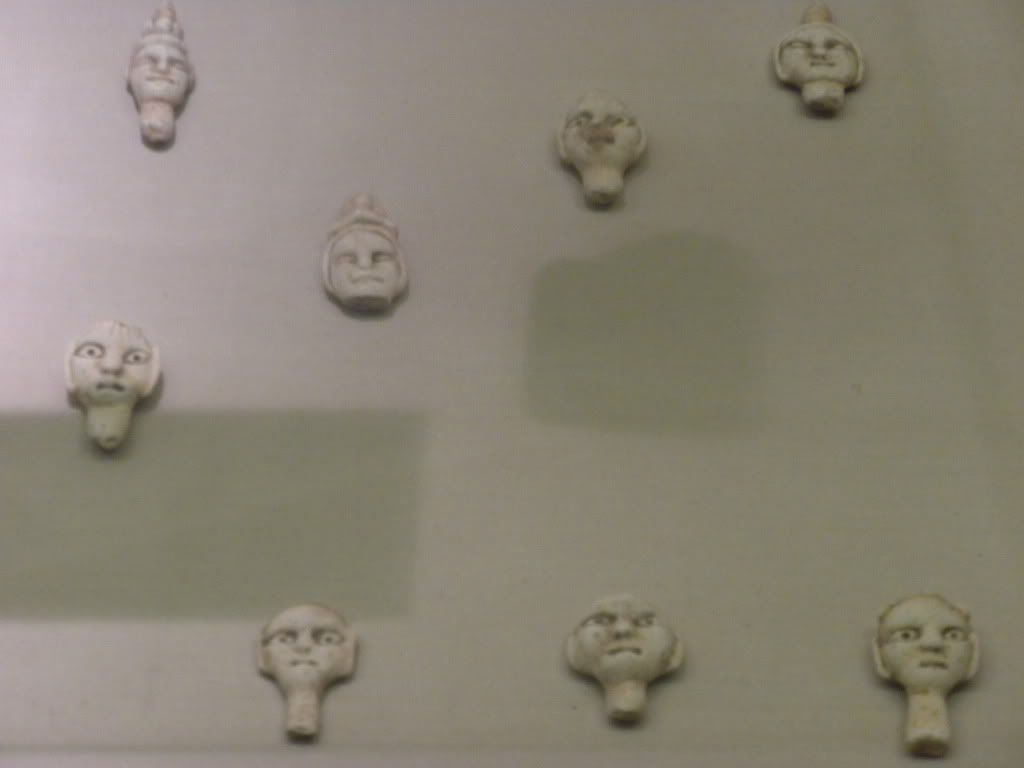
Francesca and I skipped a few centuries of Chinese rule and ended up checking out the several Dynasties that controlled the country. Here’s a short rundown of their progress from the Vietnam Wiki: “In 938 CE, a Vietnamese lord named Ngo Quyen defeated Chinese forces at the Bach Dang River and regained independence after a millennium under Chinese control. Renamed as Dai Viet (Great Viet), the nation went through a golden era during the Ly and Tran Dynasties. During the rule of the Tran Dynasty, Dai Viet repelled three Mongol invasions. Buddhism flourished and became the state religion.” We saw some examples of fine Buddhist art.
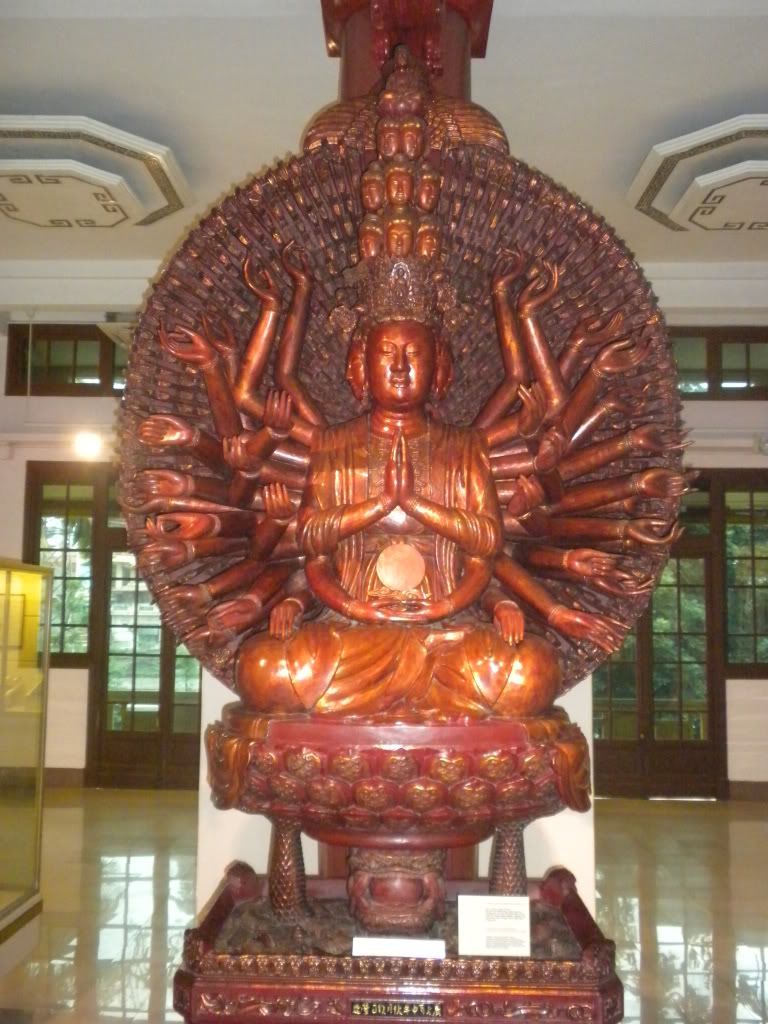
“Between the 11th and 18th centuries, Vietnam expanded southward in a process known as nam tien (southward expansion), and it eventually conquered the kingdom of Champa and part of the Khmer Empire. From the 1500s onwards, civil strife and frequent infighting engulfed much of Vietnam. First, the Chinese-supported Mac Dynasty challenged the Le Dynasty's power. After the Mac Dynasty was defeated, the Le Dynasty was reinstalled, but with no actual power. Power was divided between the Trinh Lords in the North and the Nguyen Lords in the South, who engaged in a civil war for more than four decades before a truce was called in the 1670s. During this time, the Nguyen expanded southern Vietnam into the Mekong Delta, annexing the Champa in the central highlands and the Khmer land in the Mekong.”
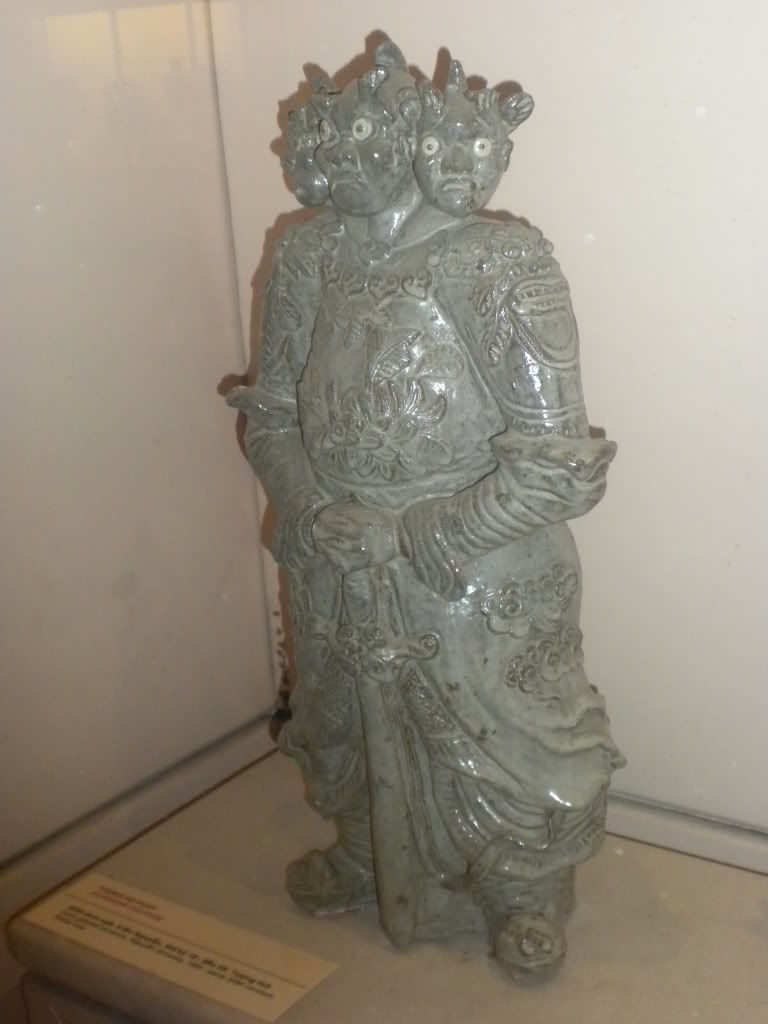
“The division of the country ended a century later when the Tay Son brothers defeated both and established their new dynasty. However, their rule did not last long and they were defeated by the remnants of the Nguyen Lords led by Nguyen Anh with the help of the French. Nguyen Anh unified Vietnam, and established the Nguyen Dynasty, ruling under the name Gia Long.”
History lessons now over, Francesca and I exited the museum and looked for the Geology Museum as well as the Vietnam Revolution Museum. Both appeared closed until 1:00 PM, so we had some time to kill. We walked around for an hour trying to find an old house that our map said should be nearby. The problem was that we couldn’t locate it and had to ask in a tour office if they could help us. When even the locals had no idea and we asked them if we could check Google we finally figured out it wasn’t where our map had shown us at all… Hour wasted, but time killed.
We headed back to the slick Vietnam Revolution Museum. This museum had a mildly interesting collection of paintings with the Vietnamese revolution from the early 30s as its backbone. Most pictures glorified Ho Chi Minh in one way or another. There were more pictures of French and American atrocities during the periods of oppression. By now we’d seen so much of this material that it started to leave far less of an impression. The paintings and the sculptures were a little more interesting. It still took us about an hour to go through the whole building.
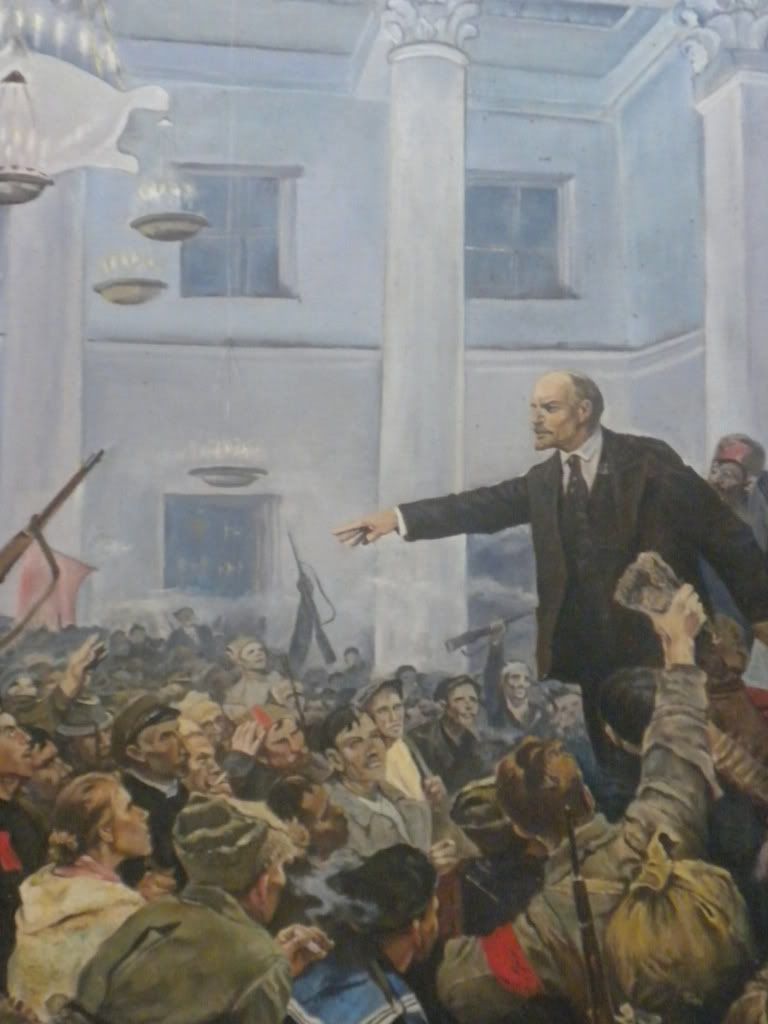
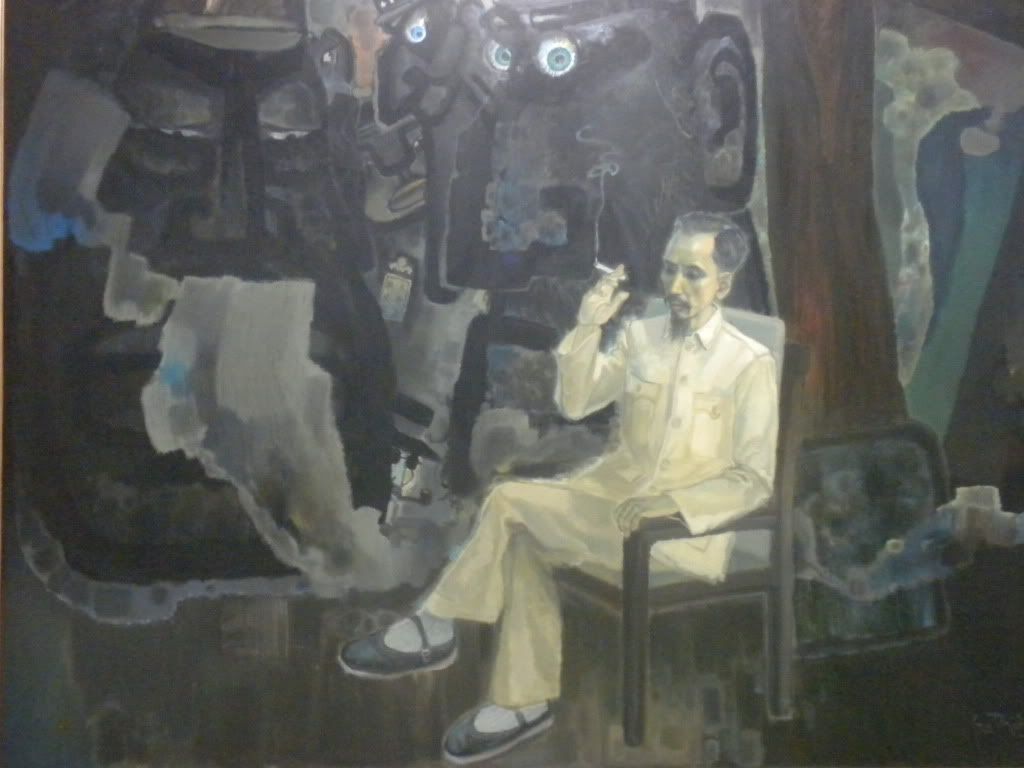
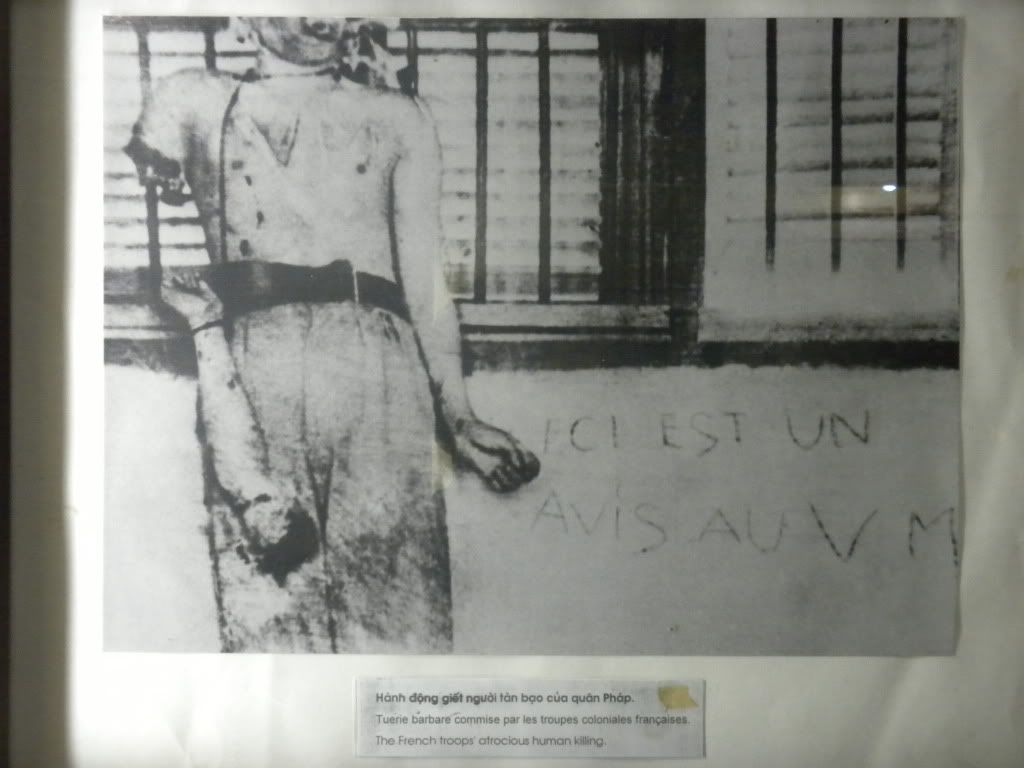
The Geology Museum was a bit of a mystery on our list. Entrance was free, which, in a city where museums cost less than a dollar to enter seemed a sure sign of disappointment ahead. And indeed, for inside we found a large collection of rocks. Rocks, rocks, rocks, whole cabinets filled with rocks. Paintings of dinosaurs lined the walls and were much more spectacular than the contents of the glass cages. We did take the trouble to walk through all 3 (!!!) floors, but it didn’t take long and wasn’t worth it. Skip it unless you love rocks!
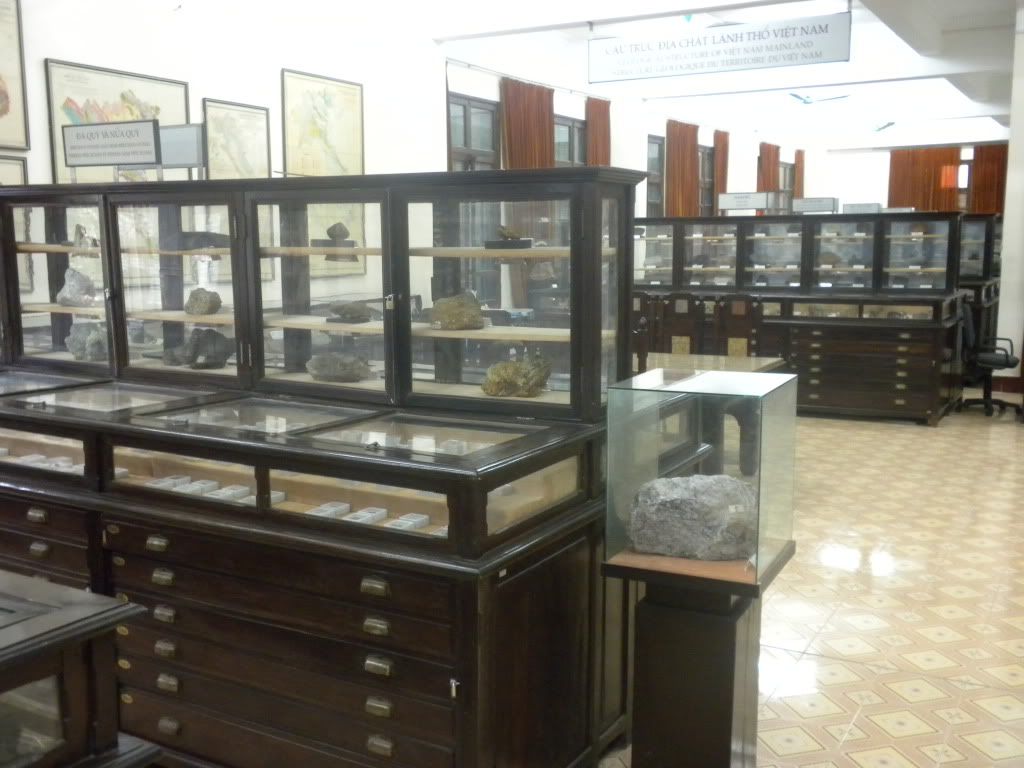
It was now almost 3:00 PM and we headed to the heart of the old city: the Hoan Kiem Lake. In the lake lies a small islet with the so-called Ngoc Son Temple, which is dedicated to Confucian and Taoist philosophers. Researchers are not sure when it was built exactly, but they found it was expanded in 1865 to its present state. We crossed the small bridge to the islet and learned about the legend of the lake. A King of old, King Le returned a magical sword to the tortoise genius that resided in the lake. People still believe the sword is there and from time to time tortoises are found in the water.
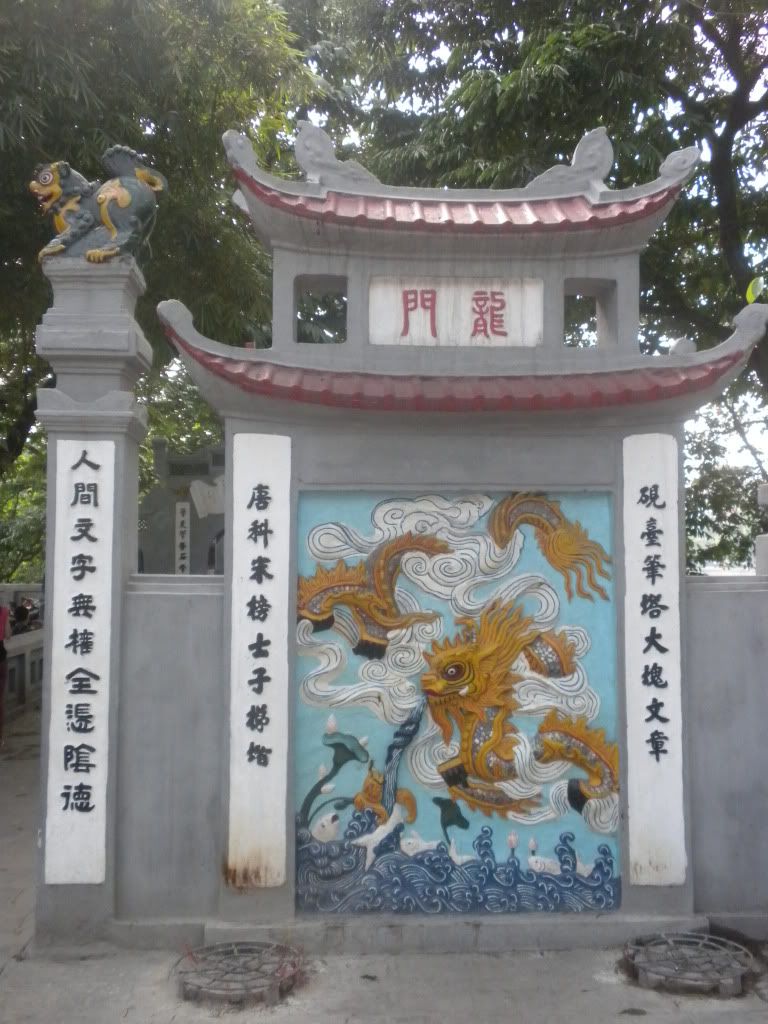
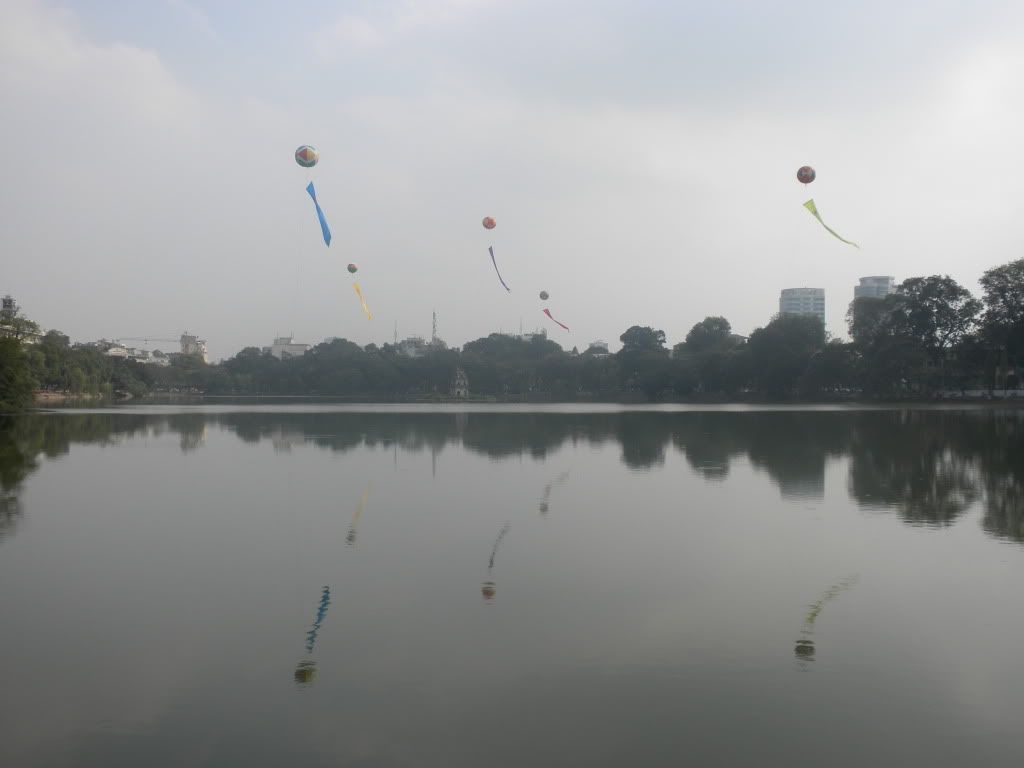
Francesca and I continued our walk in the Old Quarter of Hanoi and continued our search of the old house. We passed all the street vendors, made some inquiries about the water puppetry in Hanoi and discovered the traditional Viet house at 88 Ma May Street. We got some brochures and walked around the impressive two-story building. A bridal photo shoot was taking place and Francesca and I had a quick look at that scene as well. The little inner courtyard was a nice escape from all the hustle-bustle of ever-moving Hanoi. The family altar or altar of ancestors was something we’d seen before in the South.
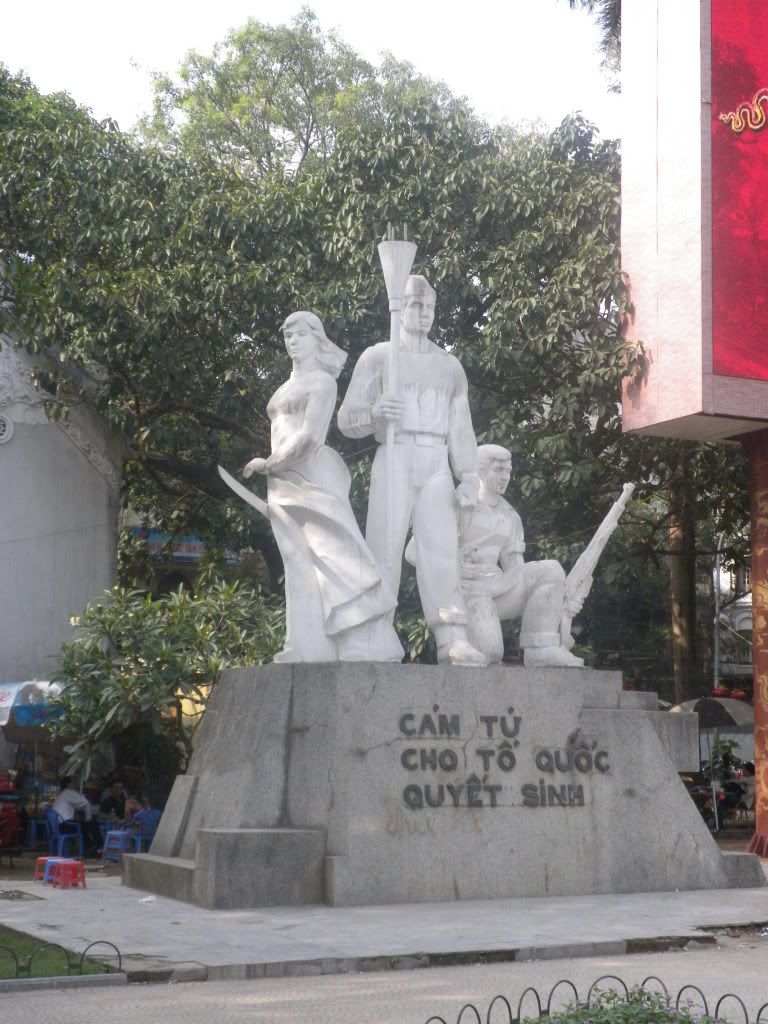
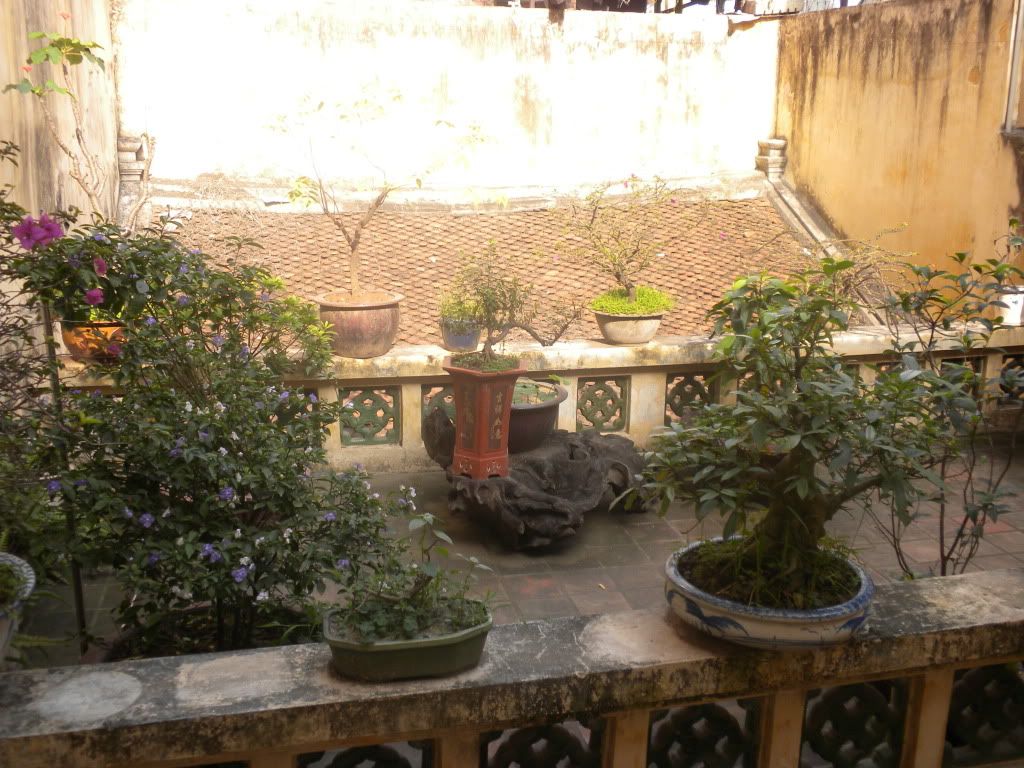
Our final stop before heading back to the guesthouse was Bach Ma Temple. The map had listed this as a must-see as well, but to us it looked similar to any other temple we’d seen in Vietnam. In fact, in Hanoi alone there are over 600 temples and pagodas. Since they’d just scrubbed the floors we made our way across the slip-and-slide floor, where we had a quick look around before finally being able to rest our legs for the a while.
Our night wasn’t entirely over, since we’d bought tickets for the Water Puppetry, a famous tourist attraction in Hanoi. The tickets were cheap, so we ended up with some pretty good seats. As the little theatre filled up with foreigners Francesca and I read a little about this fine art:
“Water puppetry is a unique performing art created by the Viet people around the 10th century and is continued until today. The puppets are carved from light-weight, durable wood like the fig tree and painted with appropriate colors. The puppets portray lively and humorous characters. The performing stage is a roofed manipulation room called Thuy Dinh, which is built on the surface of the water and conceals the puppet artists. Standing in the water, the puppeteers manipulate the puppets using either an ensemble of supports or a system of strings to control a group of characters attached to a common support.
The presentation of the performance by the character Chu Teu is followed by scenes illustrating agricultural work, fishing, catching frogs, fox chasing a duck, fire-spitting snakes, wrestling, boxing, buffalo fighting, dragon and lion dancing, and old stories such as Thach Sanh and Tam Cam.”
And indeed, for an hour the puppeteers played out about 15 different scenes, whilst accompanied by a little orchestra and some voice-actors that only spoke Vietnamese. Not that we needed that; the brochure along with the pretty straightforward scenes didn’t make it very hard to understand what was being acted out. Francesca and I watched the show intently as the hour flew past and before we knew it it was all over again. We contemplated buying a puppet as a souvenir but realized it’d probably get squashed along the way so we kept the money in the pocket. Tired after a long day of walking we headed back to the guesthouse and slept soundly.
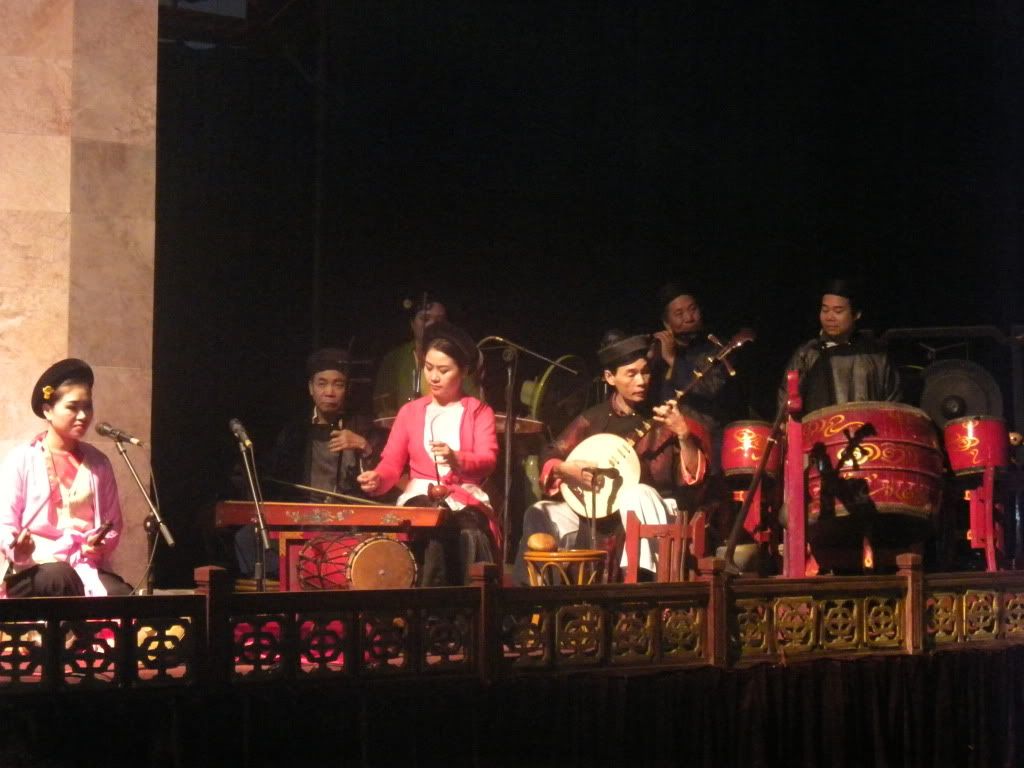
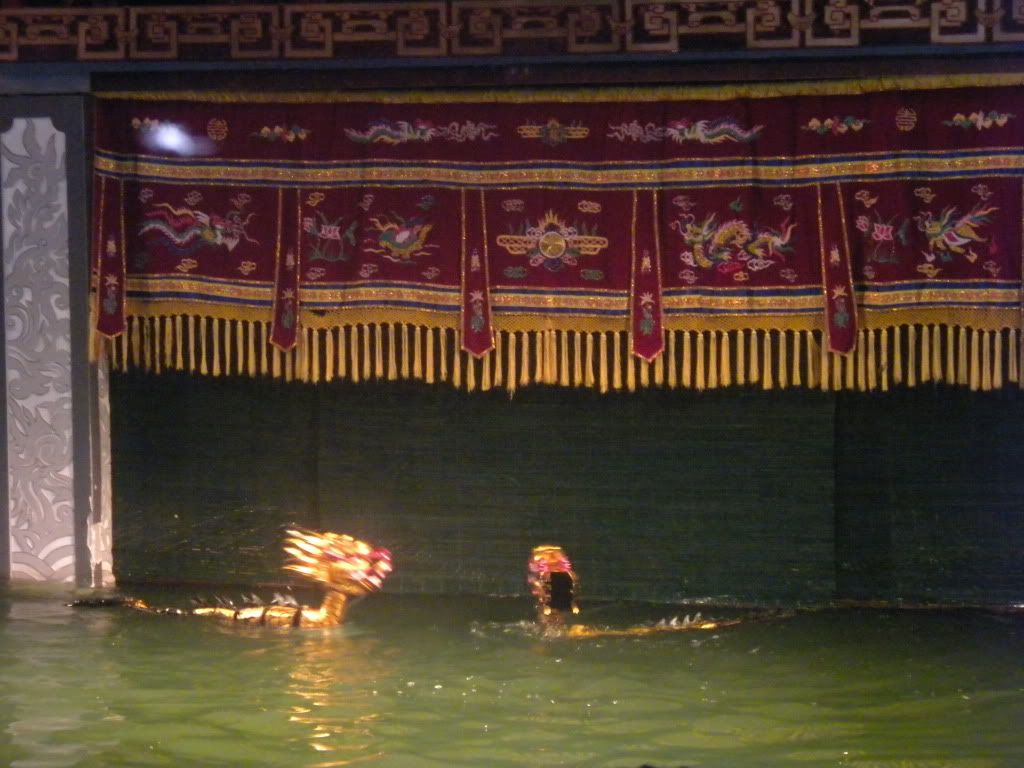
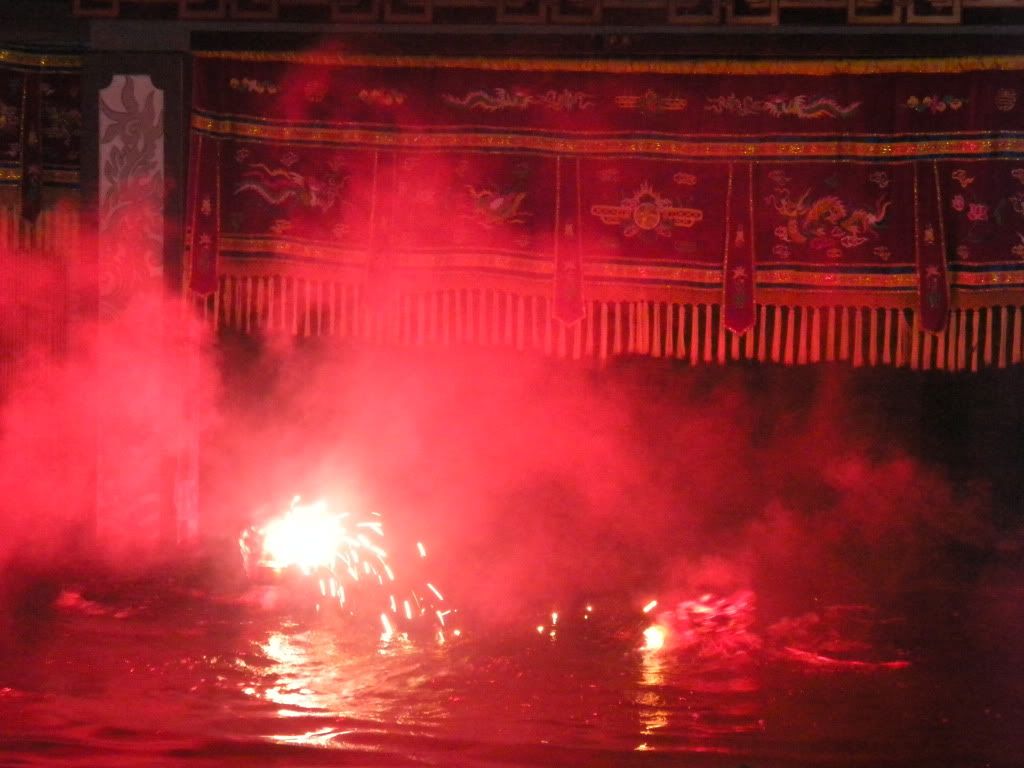
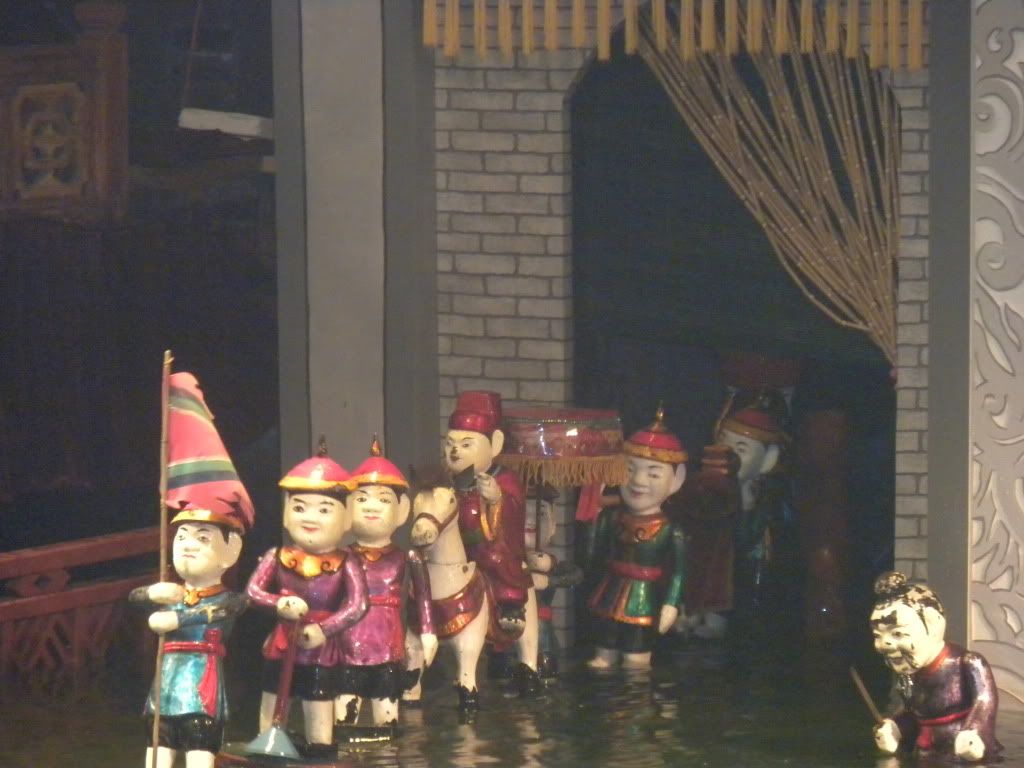
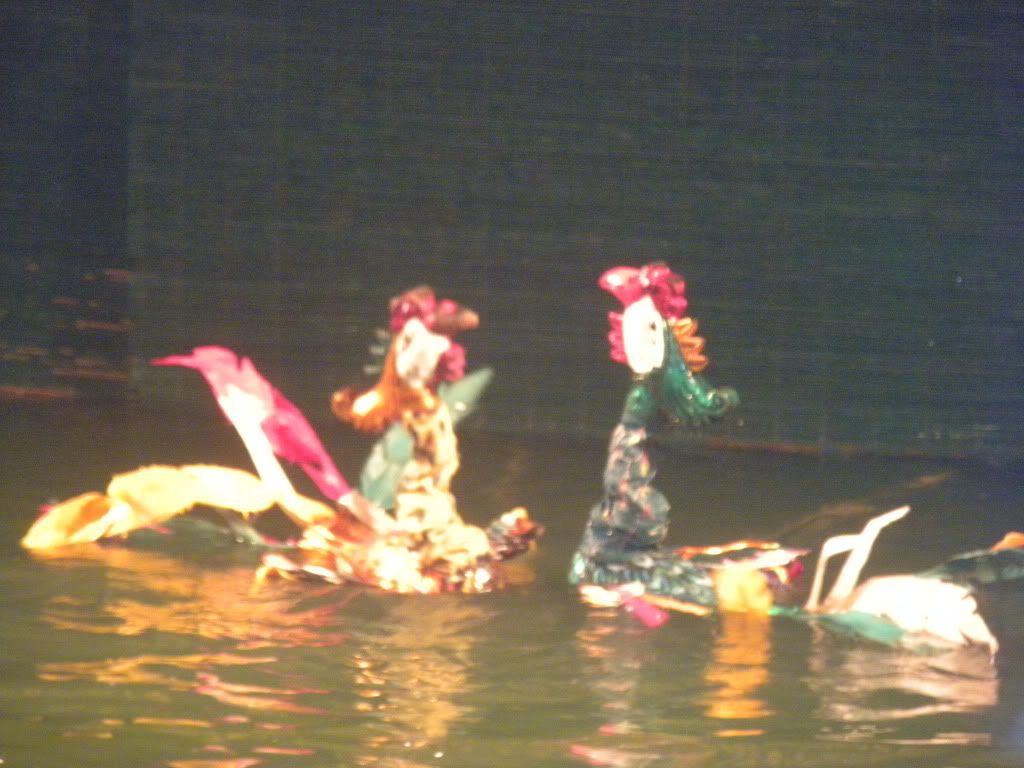
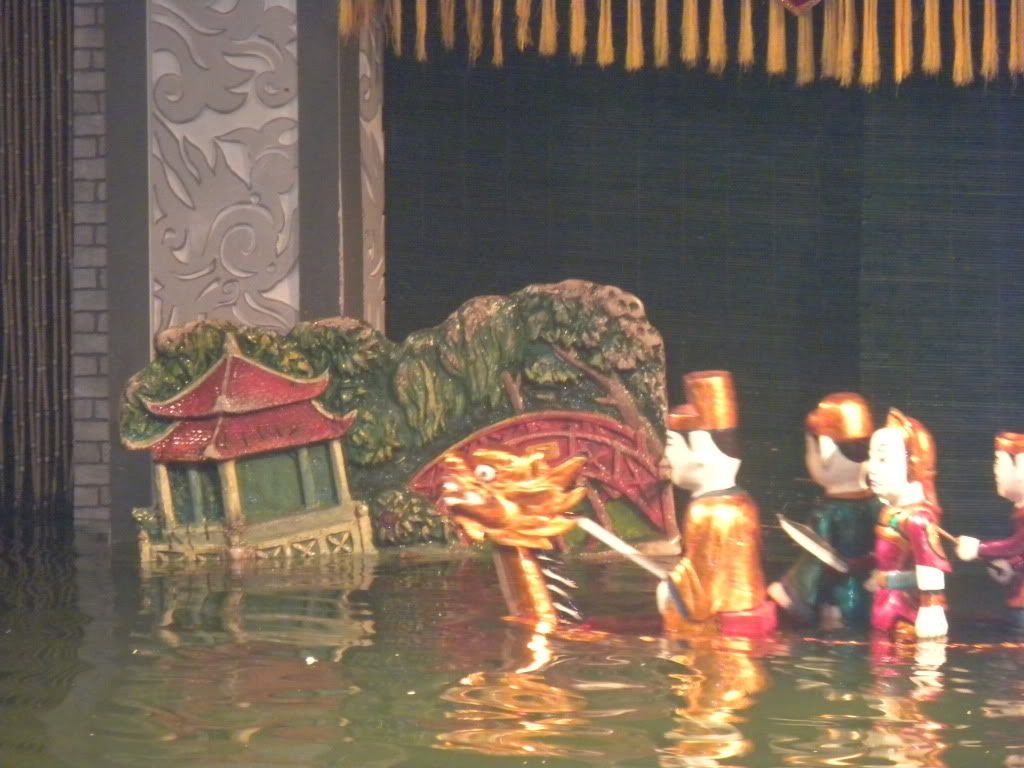

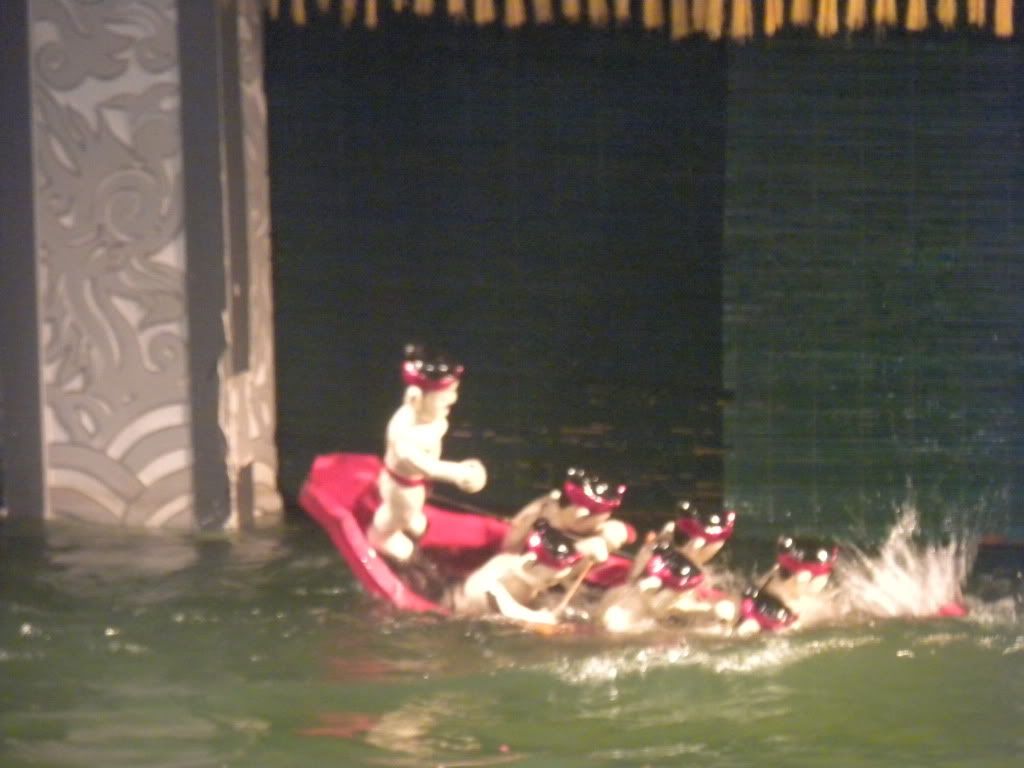

On the 30th we finally managed to treat ourselves to a little rest. We got up little later, ordered sandwiches a little later, and grabbed a taxi to the Vietnam Museum of Ethnology in the afternoon. The Museum of Ethnology consisted of two sections: an outdoor section with remakes of traditional tribes’ houses and huts, and an indoor section with further information about these tribes and others. We decided to spend our time outside first. The first house we came across was the Cham House. The Cham construct their dwellings out of wood, straw and mud. Depending on the wealth of the occupying family the house can consist of up to 5 different semi-detached buildings. Inside the house we found a lot of animist symbolism: fans representing the 4 seasons, turtles for longevity and the wish of many children, and representations of the 5 elements. We walked through the very basic sleeping quarters, wondering how comfortable it is to sleep without a mattress under your behind.
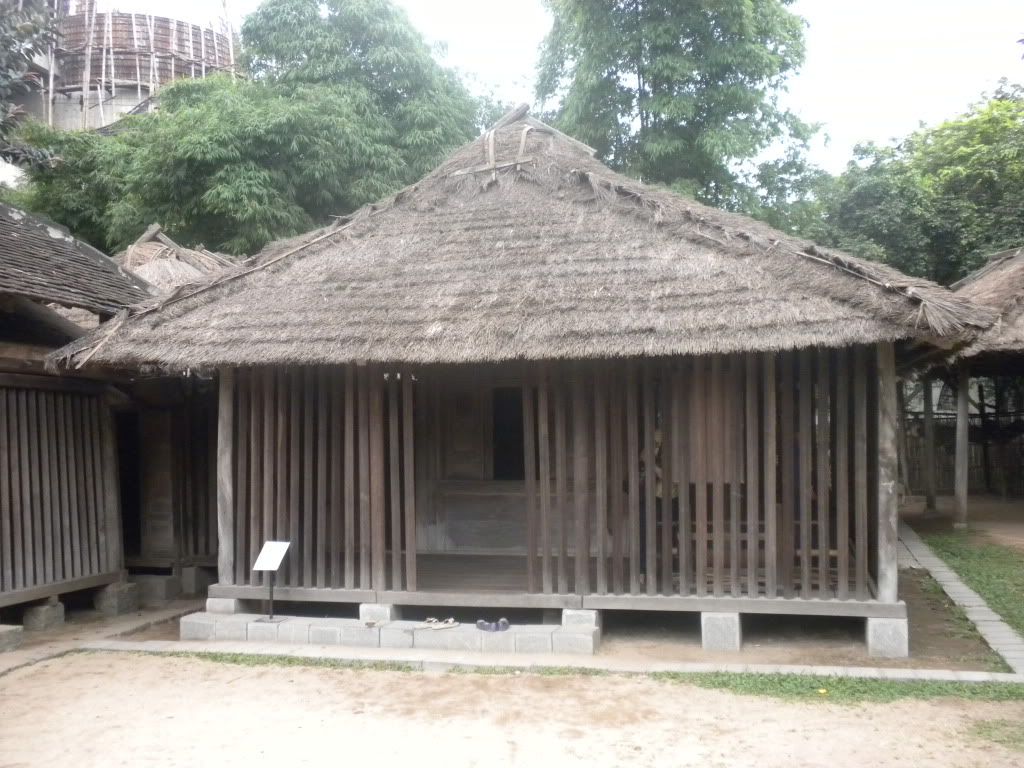
We followed the path to the next house, passing a ridiculously long (over 25 meters!) Cham junk which was once used for warfare. The next house was 50 meter high Bahnar Communal House. We entered via the tree-staircase, thoroughly impressed by the craftsmanship of the builders. The Bahnar Communal House traditionally functioned as a meeting hall for rituals, celebrations, and preparations for war or defense were made. This Communal House had been built by 29 Bahnar people in just 7 days. Traditionally it would take the villagers several years to prepare the materials and the location.
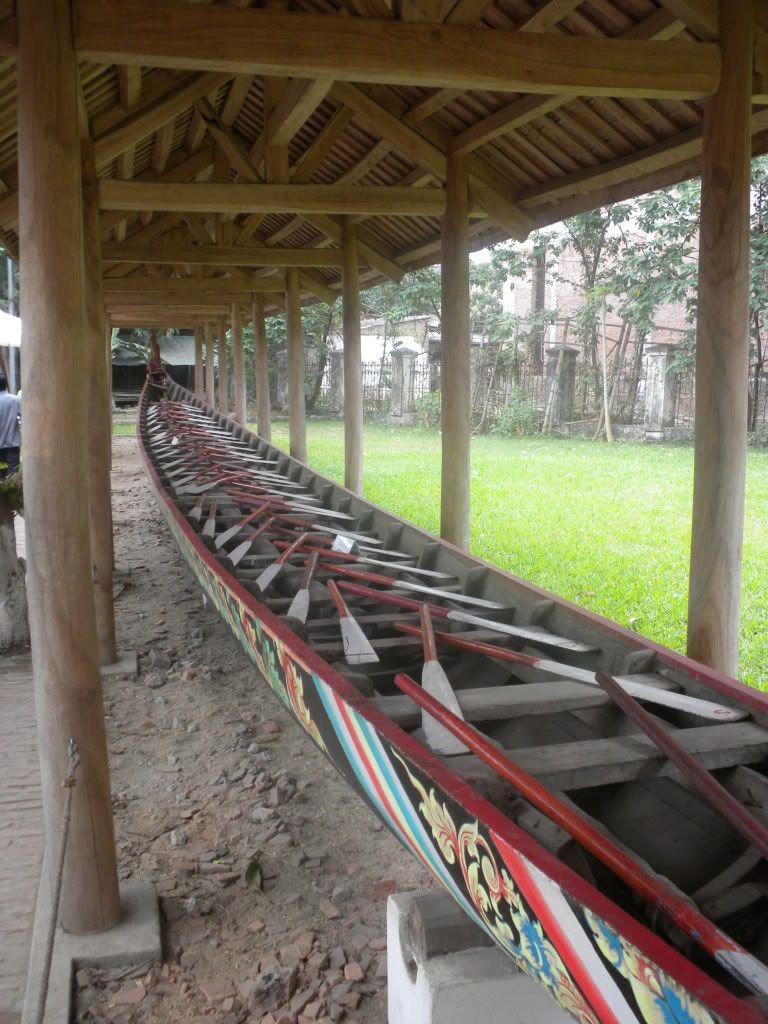
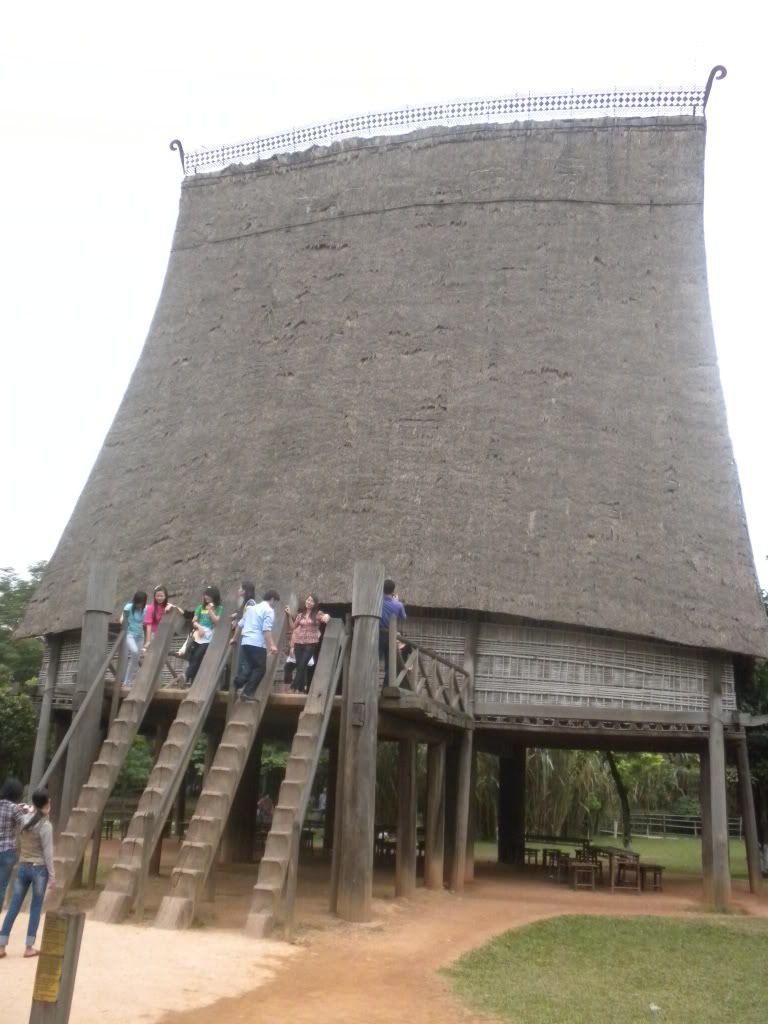
The Ede House was not quite as high as the Bahnar’s House, but what it lacked in height it certainly made up for in length. The whole thing was over 40 meters in length, standing on 1 meter high poles. We read that some of these houses can be over 200 meters long. Just imagine what a work-out you’d get cleaning your house! Unfortunately, nowadays the houses are rarely constructed anymore, exactly because they take up so much space. We headed up the staircase, which had carved images of the new moon and female breasts. Francesca and I inspected the living room, where the family shows off its wealth to visitors. We spotted beautifully carved beams and large wooden furniture around us. The longhouse was the residence of the matrilineal family, meaning daughters and granddaughters of one mother lived with their spouse in one house.
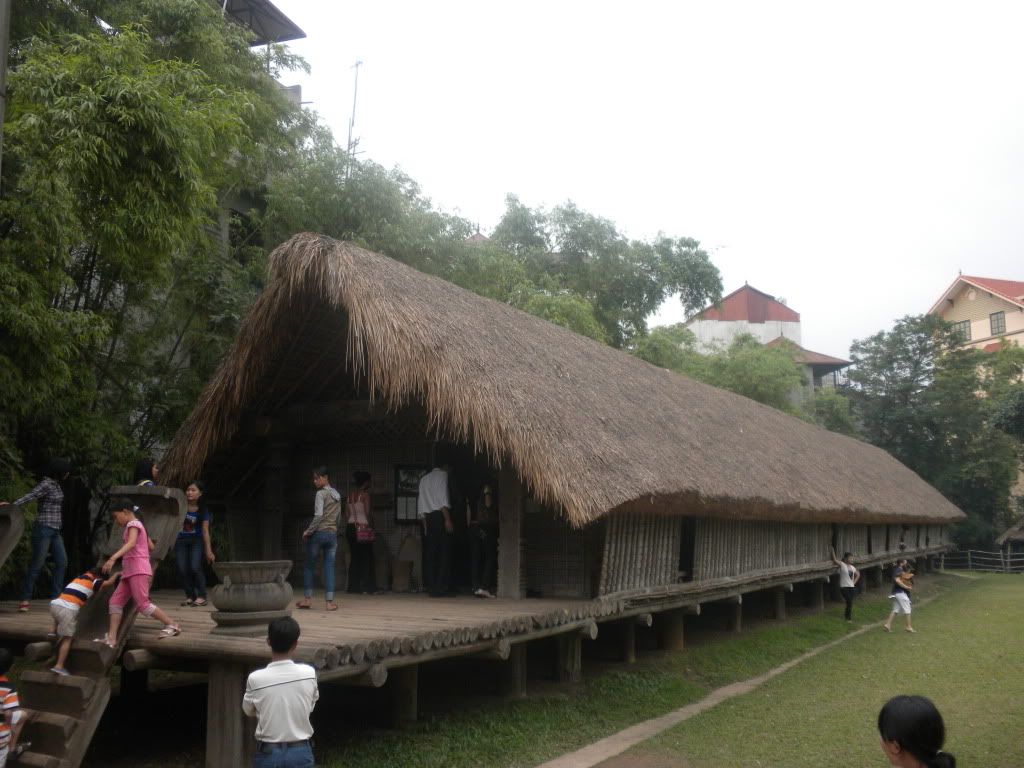
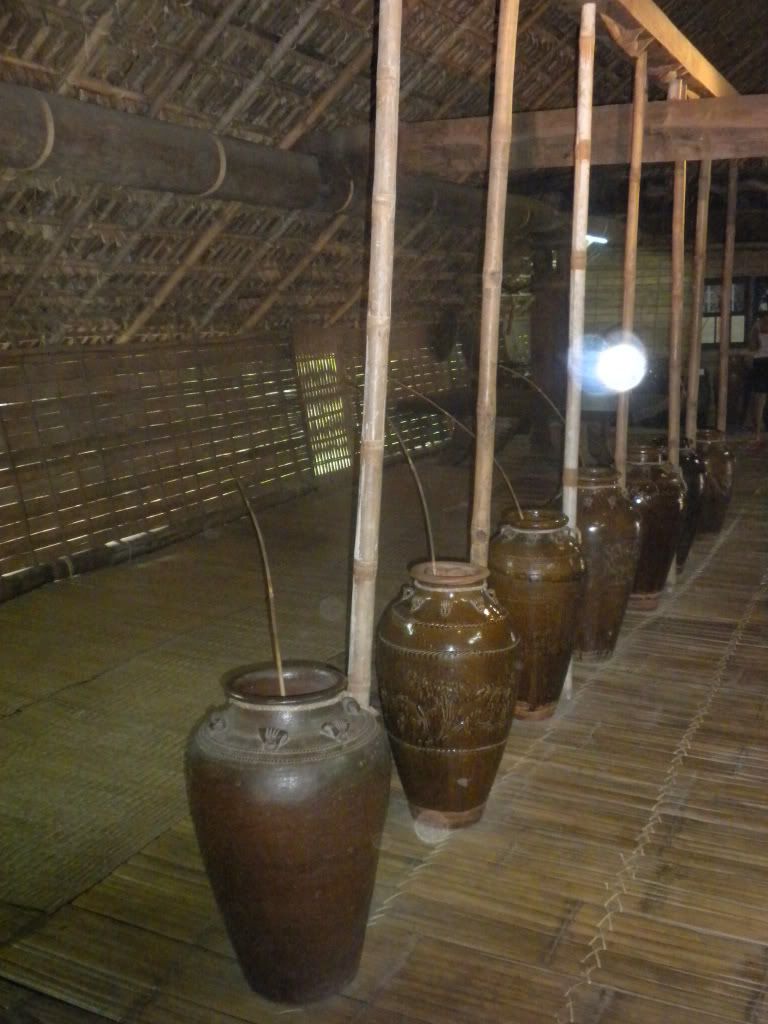
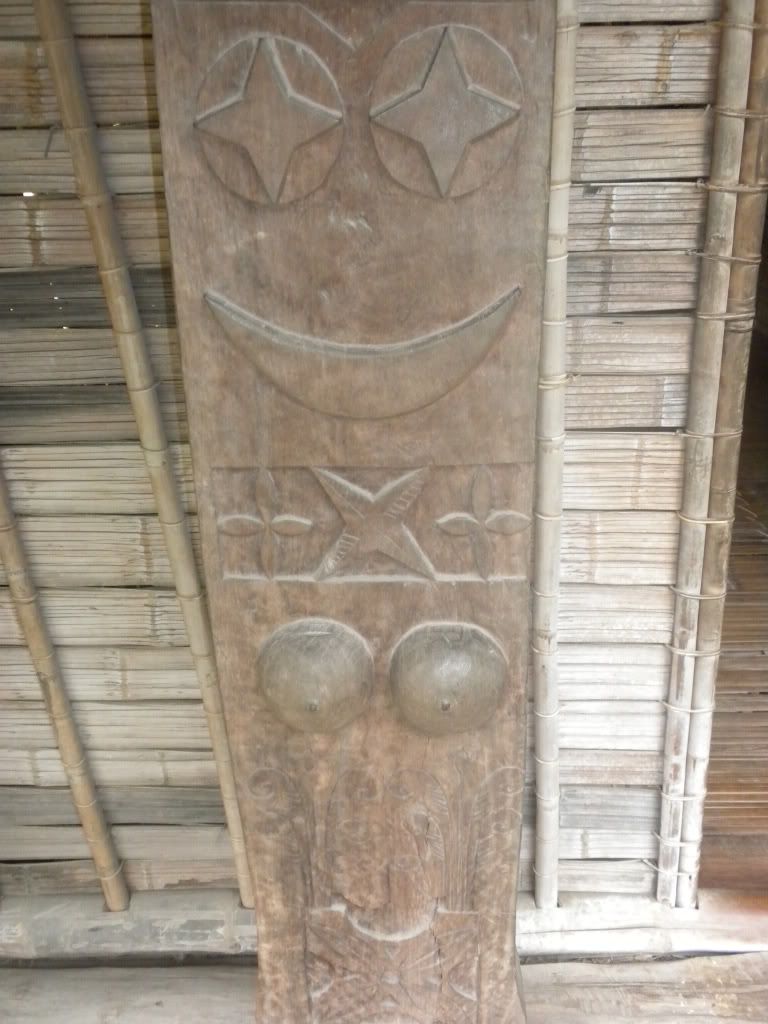
Next up was not a house, but a tomb. And not just any tomb: the Giarai Tomb was surrounded by large wooden sculptures of naked men and women during the act, pregnant women and even some animals. Apparently the Giarai (think they) are quite well-endowed, just look at the pictures! The inside of the tomb was not as impressive. The Cotu Tomb across the grass was altogether different from its Giarai counterpart. The whole thing was beautifully carved, with a little roof overhanging the little coffin.

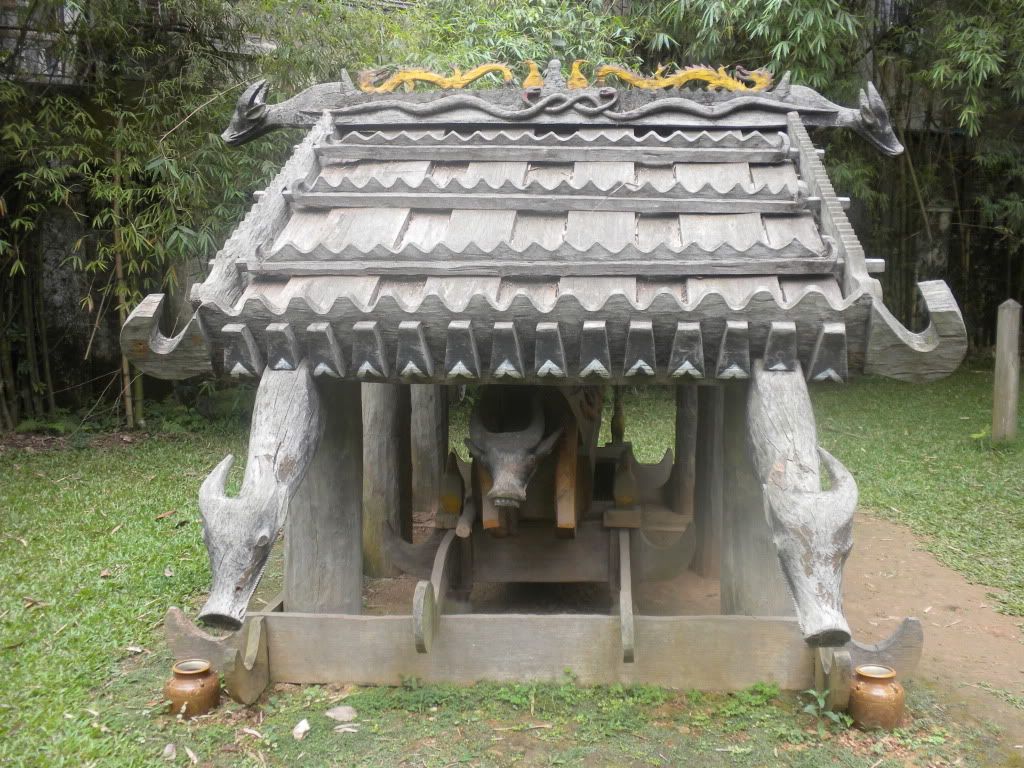
The Tay House was again very different from the other houses we had seen so far. One half touched the ground, whilst the other half of it stood on much higher stilts. The whole thing was made mostly of bamboo. A very basic ancestral altar dominated the main room, whereas the section on stilts was reserved for the sleeping quarters. It all looked a bit dusty and dark, so we left the Tay House a little less impressed than the other ones.
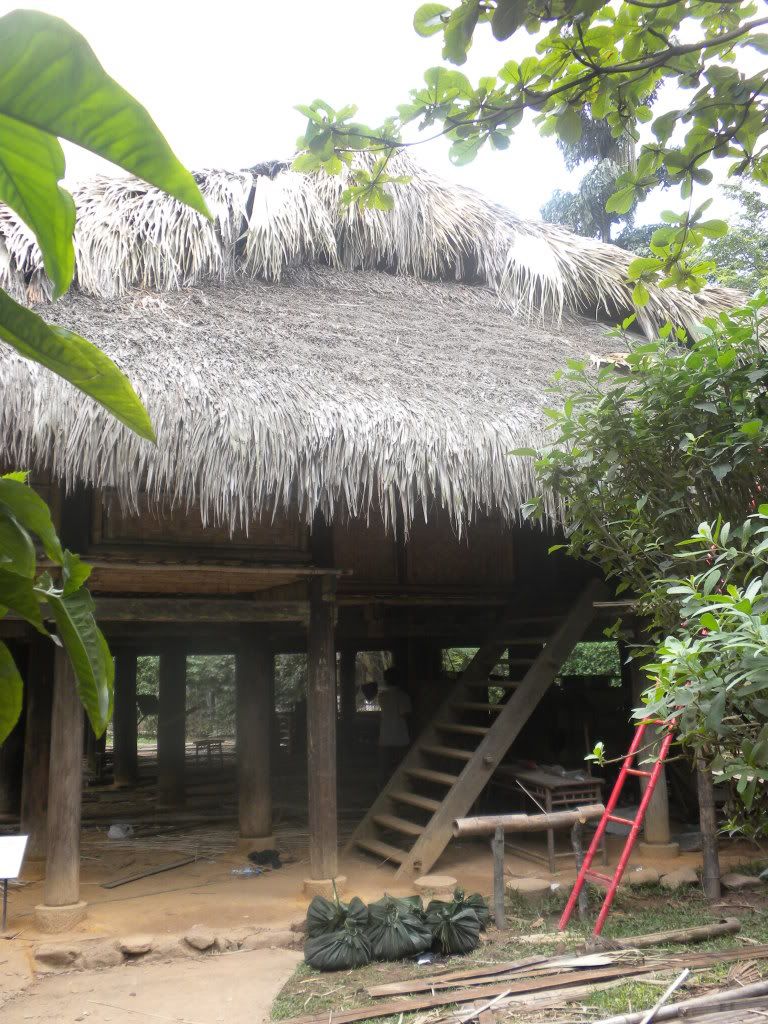
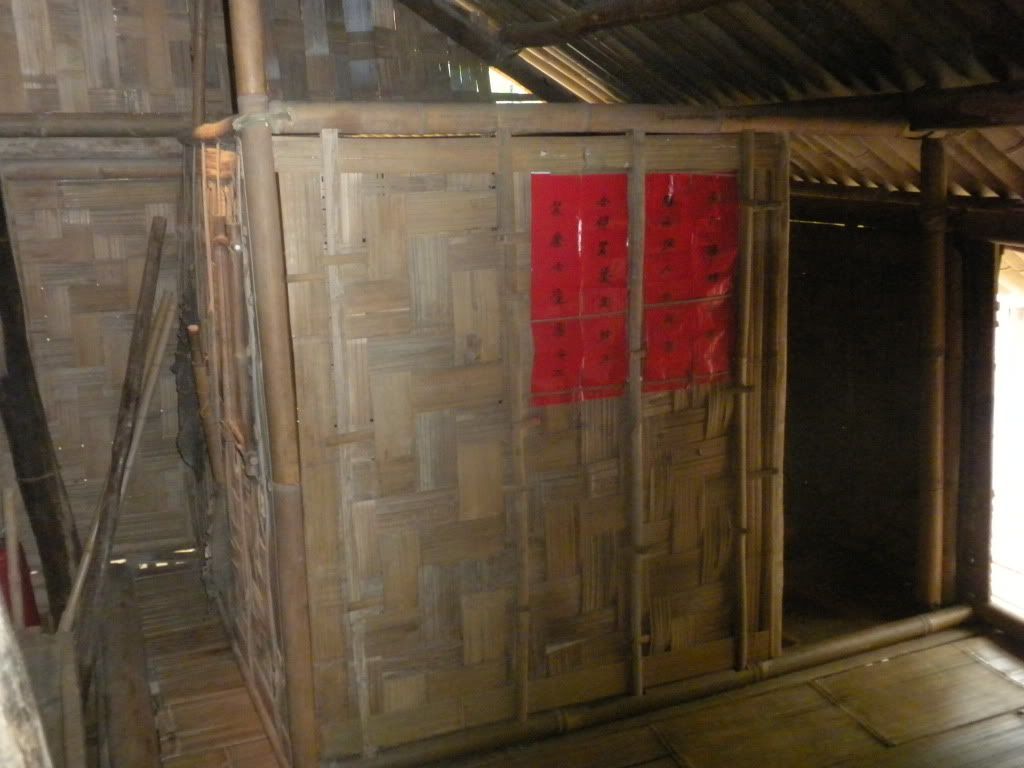
The Hmong House that came next was much cooler. Outside we spotted a stable and a smithy, as Hmong men are famous for their forging skills. Hmong houses are built directly on the ground and made mostly out of wood. Even though the roof is tiled, the wooden tiles can be moved easily to let in sun when needed, and keep out rain when closed. Francesca was reading some information about the house when a volunteer came to her and started talking to her about the house. At first she was confused as she had no idea these people were around, but when she realized she was being given a short introduction she quickly turned around, called me and listened to the story. We learned how the Flower Hmong venerate three generations of ancestors. They do this with just 3 simple sheets of paper, which are replaced once a year during a ceremony.
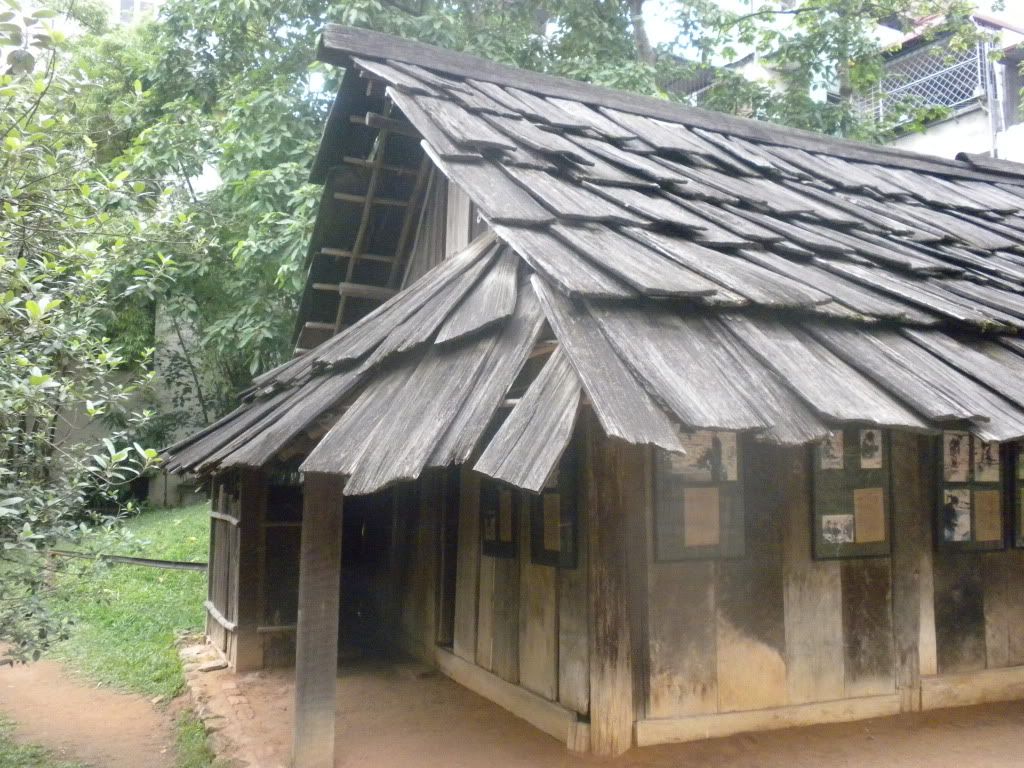
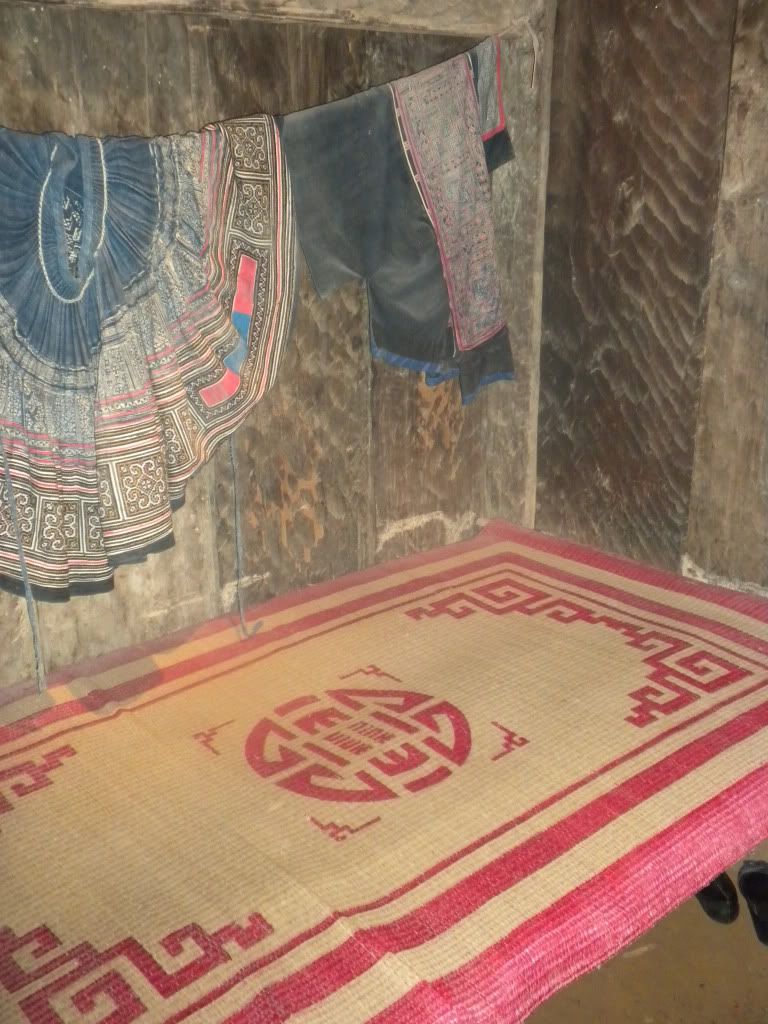
The column of the house spirit is the most sacred place of the Hmong house, as it is this spirit’s dwelling. It symbolizes the family’s prosperity and good or bad fortune. Touching it is considered bad luck by the Hmong. In the little bedroom we saw a traditional Flower Hmong dress and another basic bed which I would’ve never fit in. On our way to the next house Francesca and I passed the pottery workshop, which had some cool works of art, but nothing to rave about.
Thus we entered the Hanhi House, made mostly of wood, but with walls covered in thick earth. Not only did it give the building a distinctly orange look, it also made it very unique and impressive. The Hanhi only build one door in their house and try to avoid adding too many windows, since they are afraid of cold winter winds. The house itself is divided into several sections, each with sleeping quarters for different family members. The central room consists of the kitchen, the family altar and the dinner table.
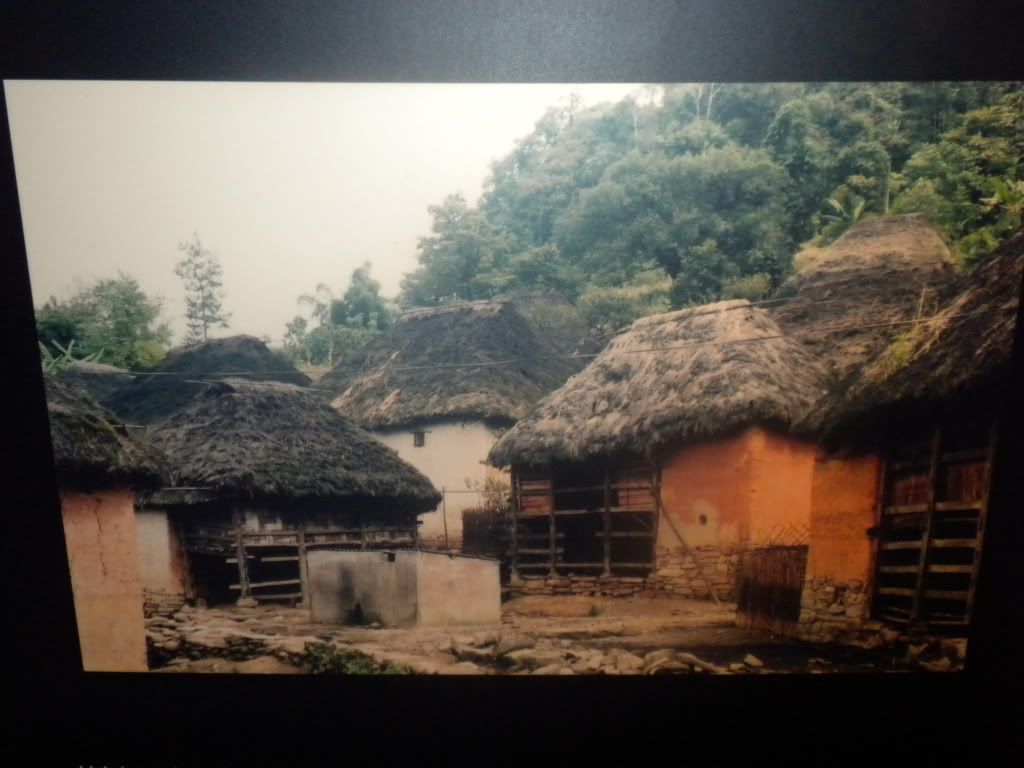
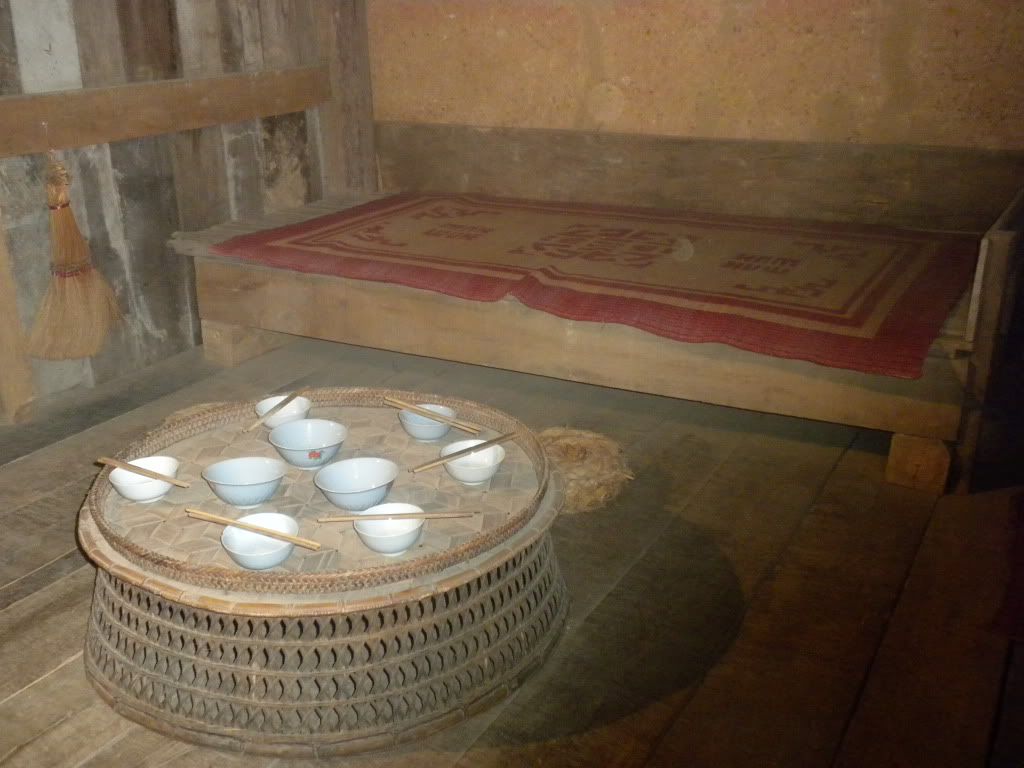
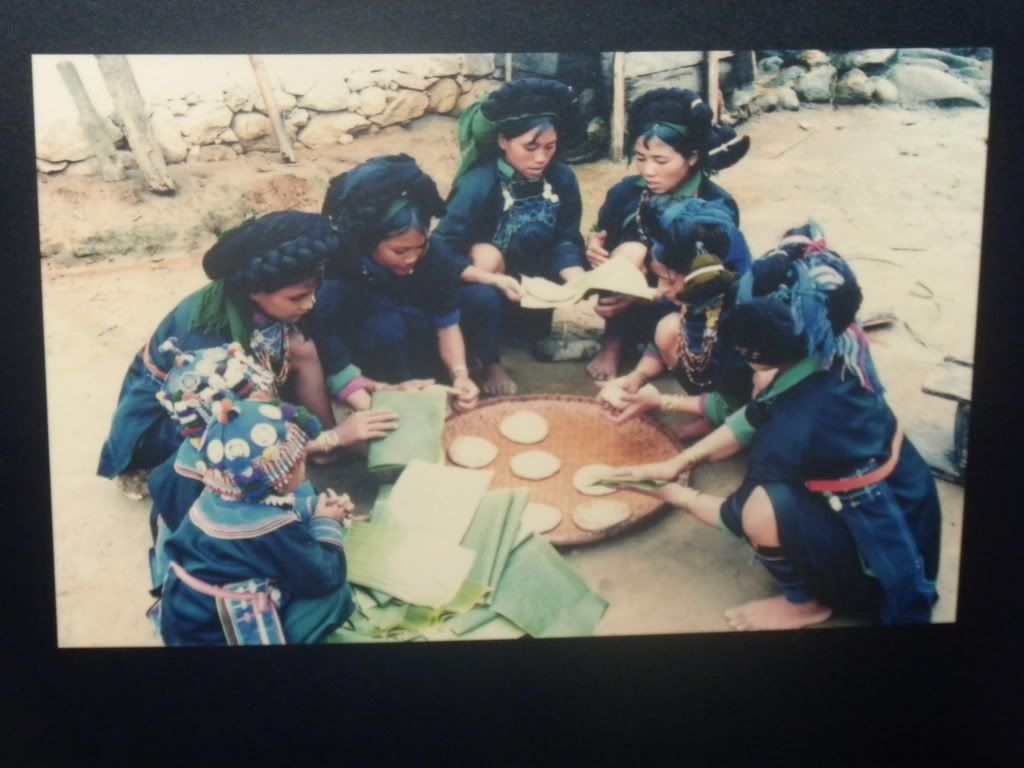
The Kinh (or Viet) House Complex was our final outdoor stop. One of the houses was dedicated to Water Puppetry, while another showcased old farming tools. Two others told the history of embroidery and weaving. Not terribly interesting, so we examined the main house of the Viet people. The family altar looked a little more advanced and decorated, the furniture a little more developed and the kitchen a tad more versatile. The little rock garden outside illustrates the harmony between ‘yin’ and ‘yang’ represented in the two elements of ‘rock’ and ‘water.’
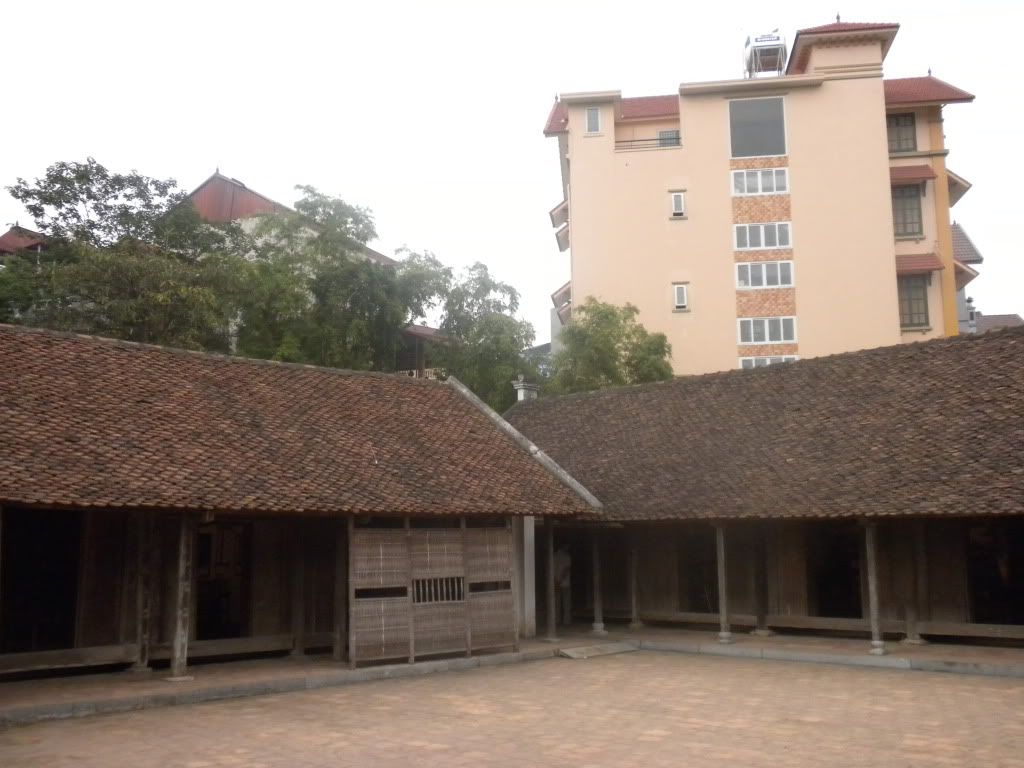
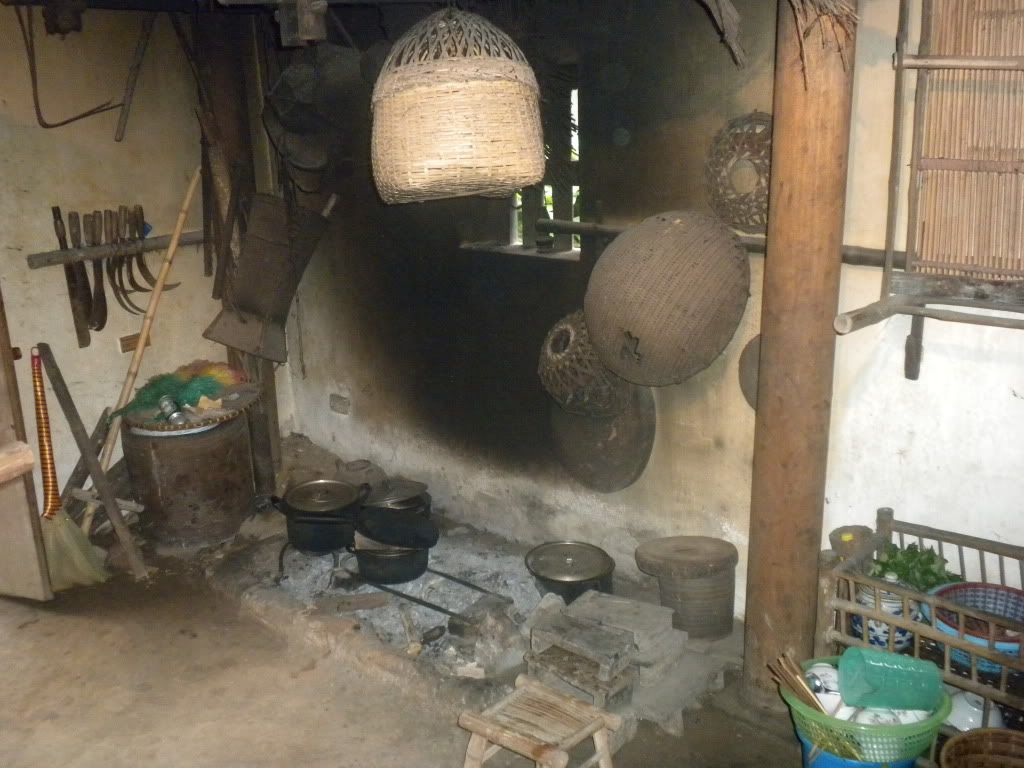
Francesca and I had gotten quite hungry by now, so I made us some make-shift hotdogs, which we ate whilst we entered the museum. We learned there is a total of 54 ethnic groups in Vietnam that speak languages from 5 different linguistic families. We investigated the pictures and saw similarities between many groups that we’d encountered before on our trip. The next part of the museum was devoted to some of the larger ethnic groups, explaining some of their customs and traditions.
There was a display with a lady making conical hats, a tradition practiced by the Viet people, amongst others. A bike absolutely stuffed with bamboo fishing traps made Francesca wonder if I could bike that around. I think I could! Similar to other ethnological museums we’d seen there was also a large collection of pictures here. Most of the pictures showed the local people in their own villages, near traditional houses, wearing traditional clothes. Francesca and I saw how the Tho make their own clothes from hemp.
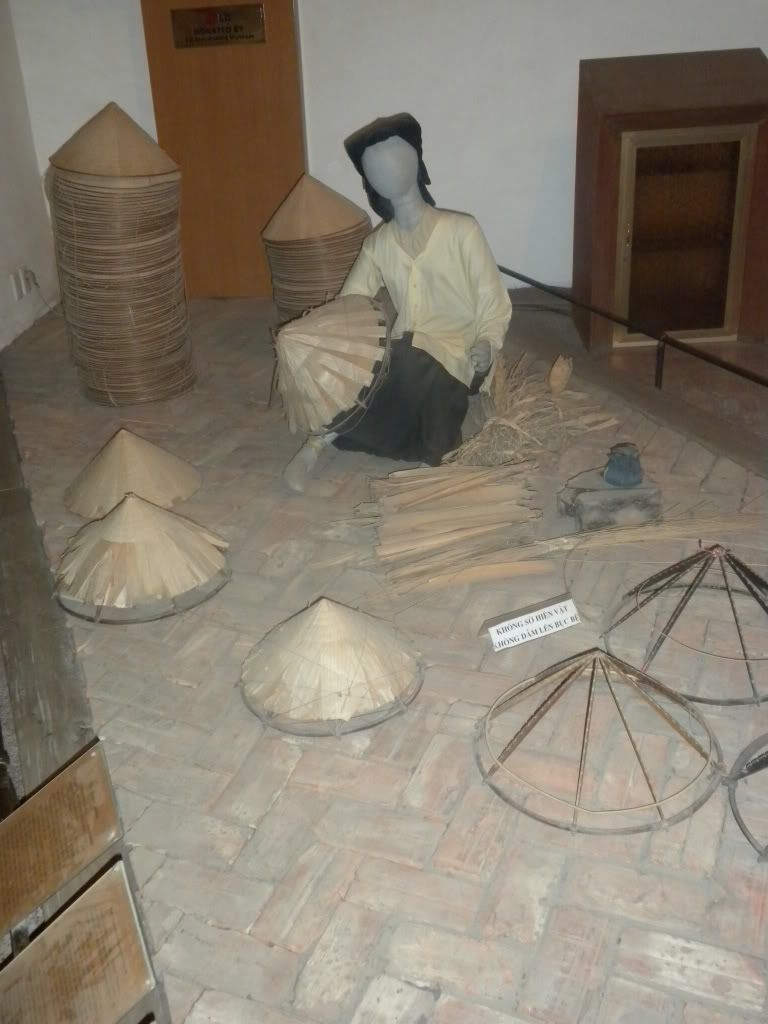
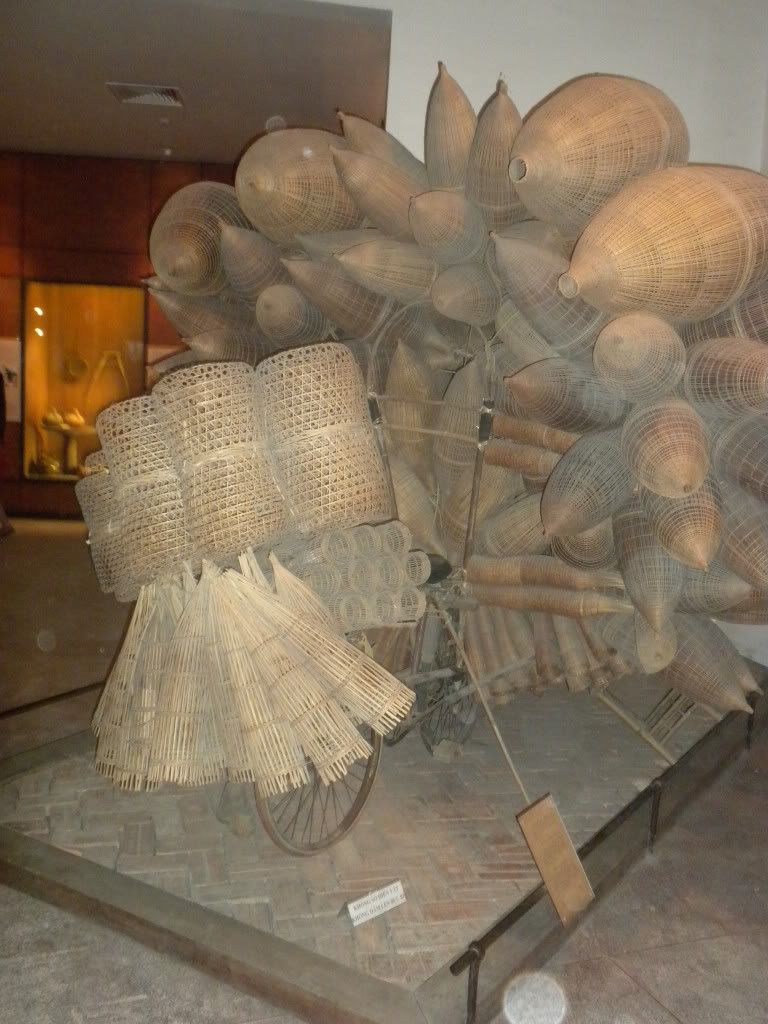
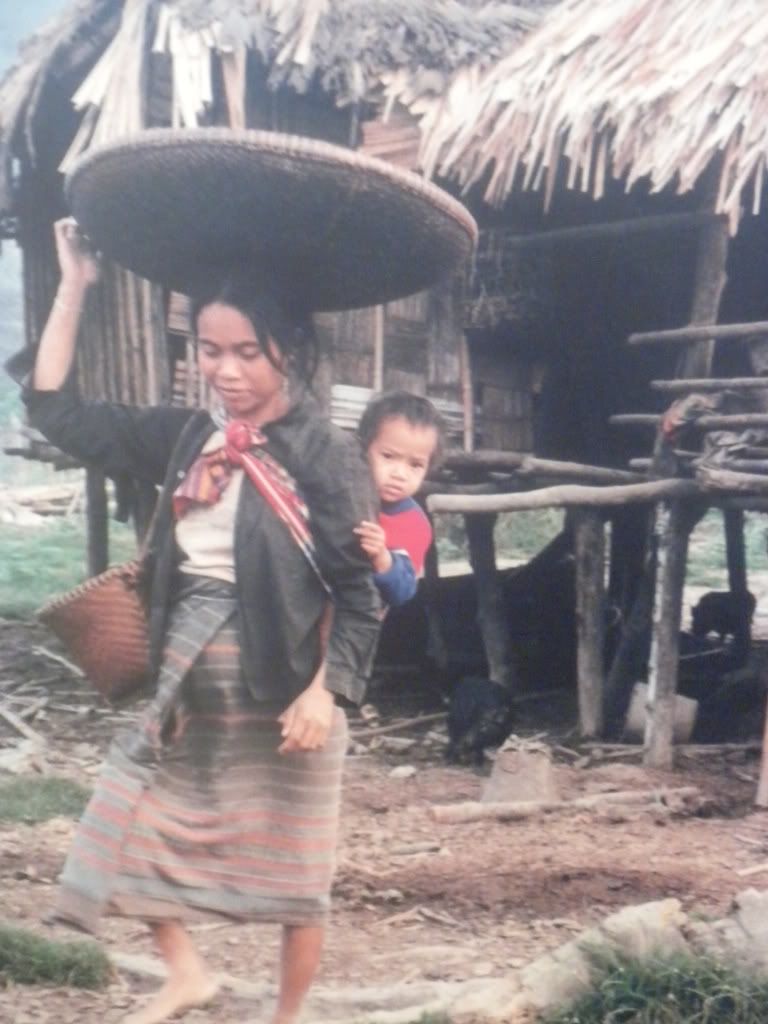
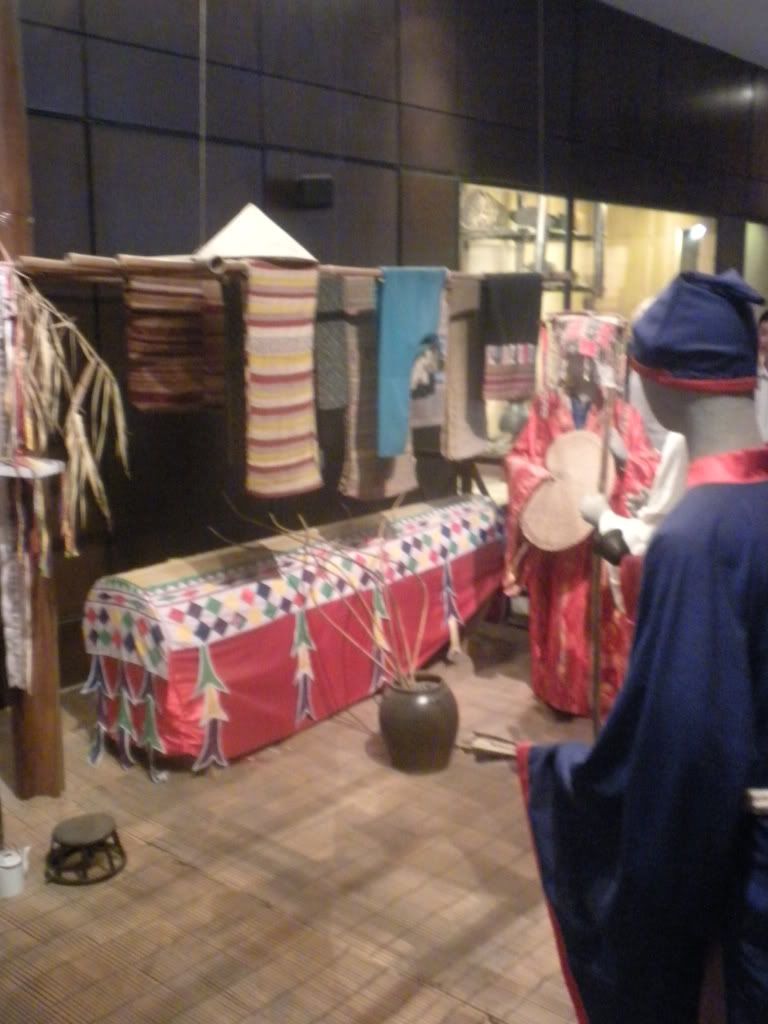
After this first section of the museum we wandered into a somewhat random section of contemporary Aboriginal art. We checked the temporary exhibition out and quickly went upstairs to see more Vietnamese culture. The room we entered had a colorful Thai ancestral altar. We entered a Black Thai house displaying a traditional scene in the lives of the inhabitants. Francesca and I were both intrigued by the Thai ritual tree outside, which are built in honor of protective spirits and made of bamboo, decorated with dyed paper animals. The walls behind the tree had examples of intricately carved windows from a Thai stilt house. Use of these wooden windows indicated wealth, as the poor just had bamboo windows. ‘Khau cut’ serve as damage reduction during heavy storms, as well as signals for social status.
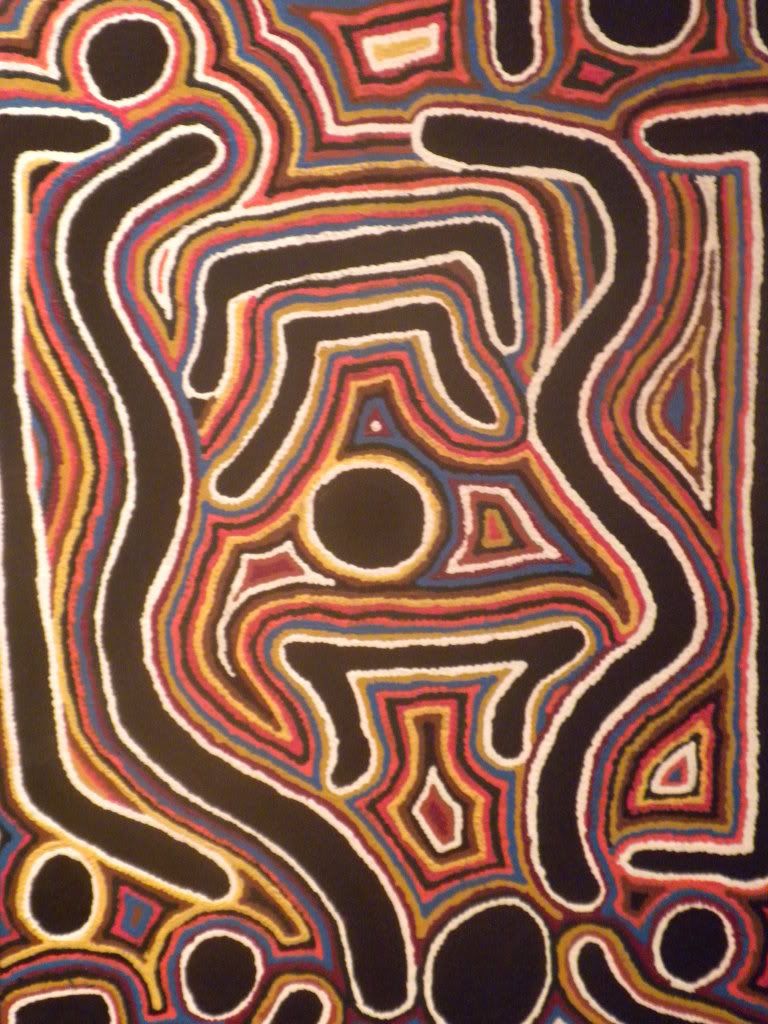
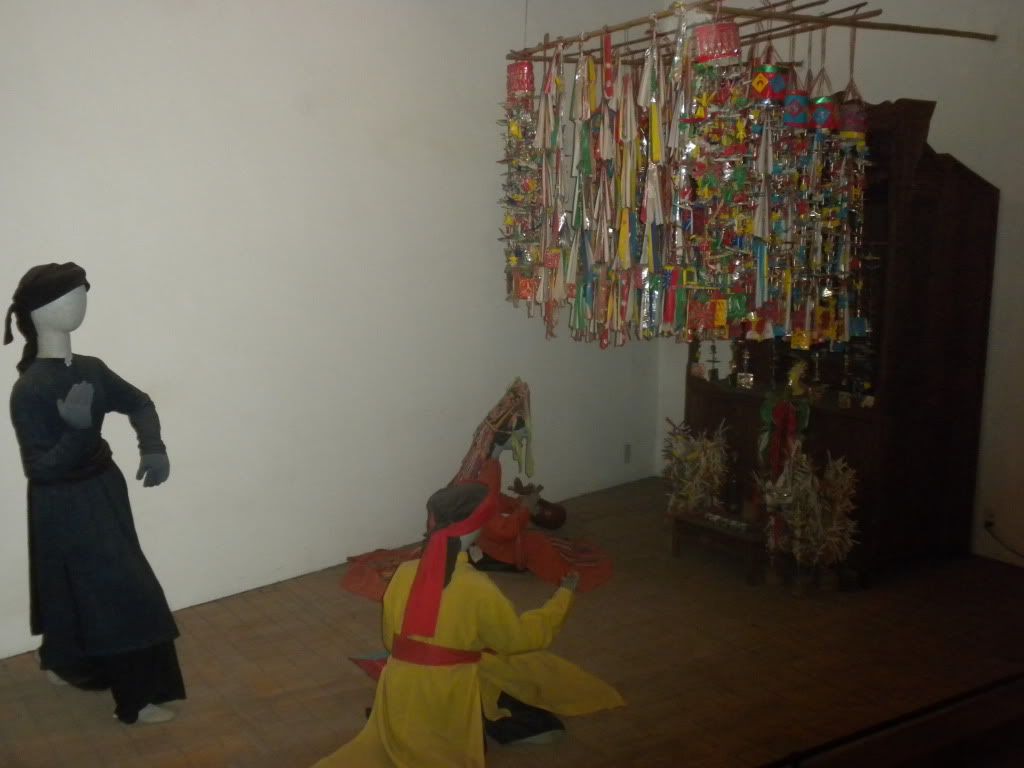
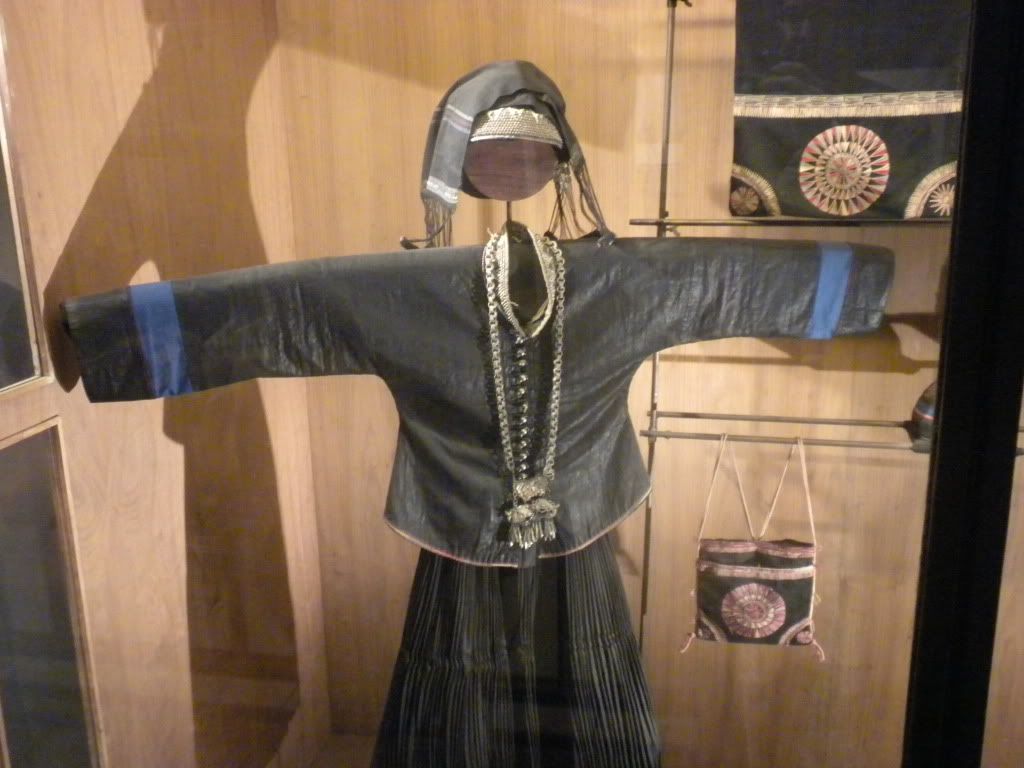
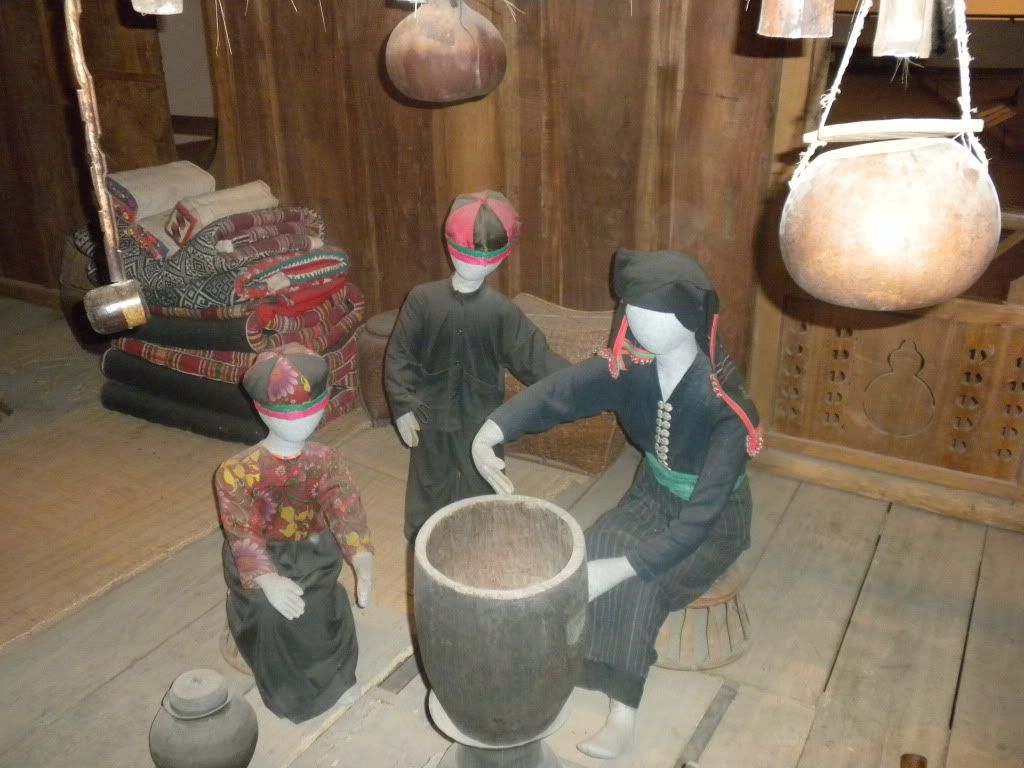
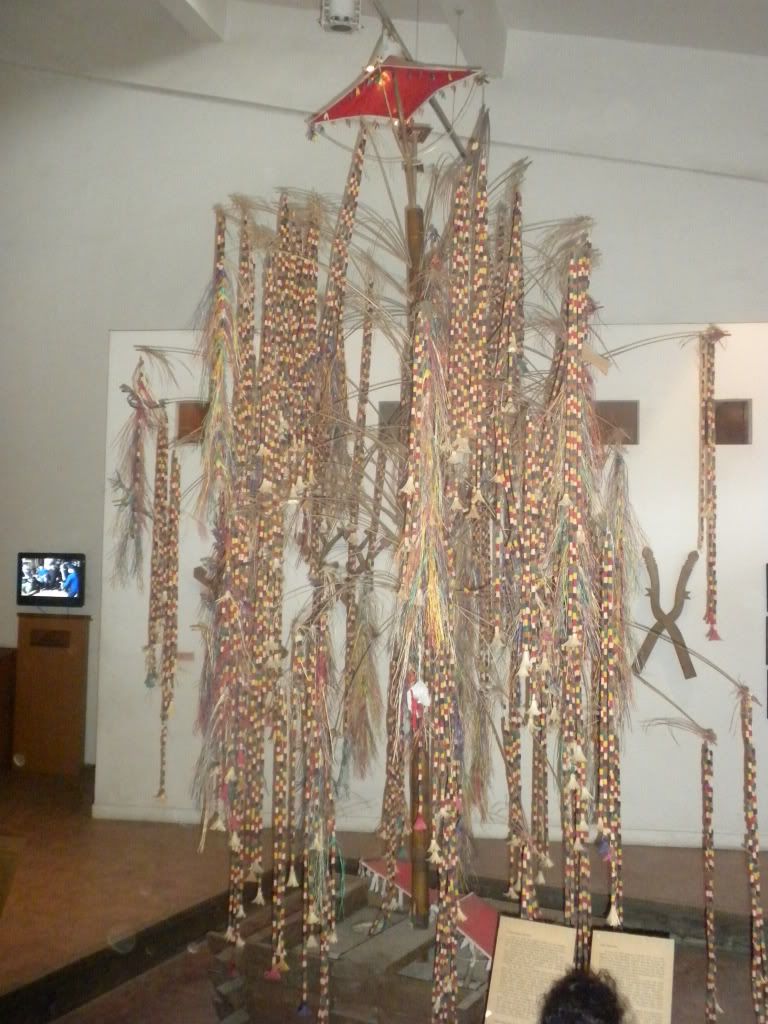
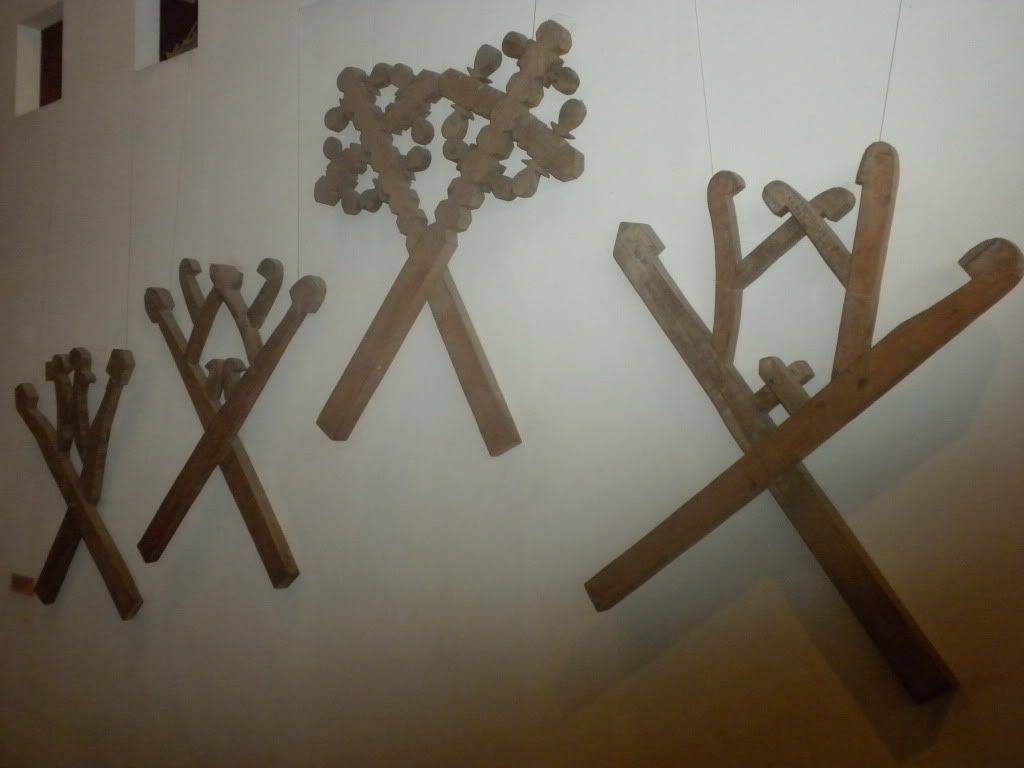
The next room covered another language group of ethnic people, starting with the Dao. Francesca and I both admired the Dao’s mask for a shaman’s initiation ritual. We also crossed paths with the Hmong again. The Red Dzao are a group I’ll talk a little more about when we got to meet them in a coming post. We followed the halls to the next room and found ourselves looking at rice cultivators from the mountains north of Vietnam. The Red Yao’s (yes, the names get confusing!) initiation rite into manhood taught us the Yao greatly value their Chinese heritage as the boys are forced to learn to write and read Chinese characters before they can become men.
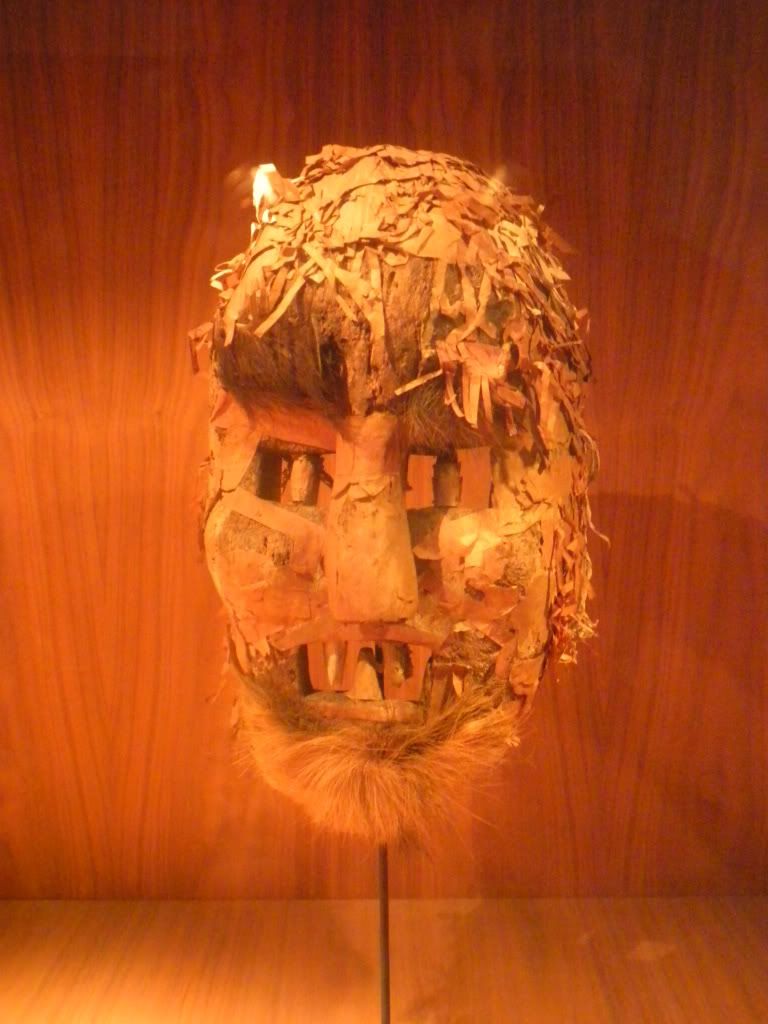
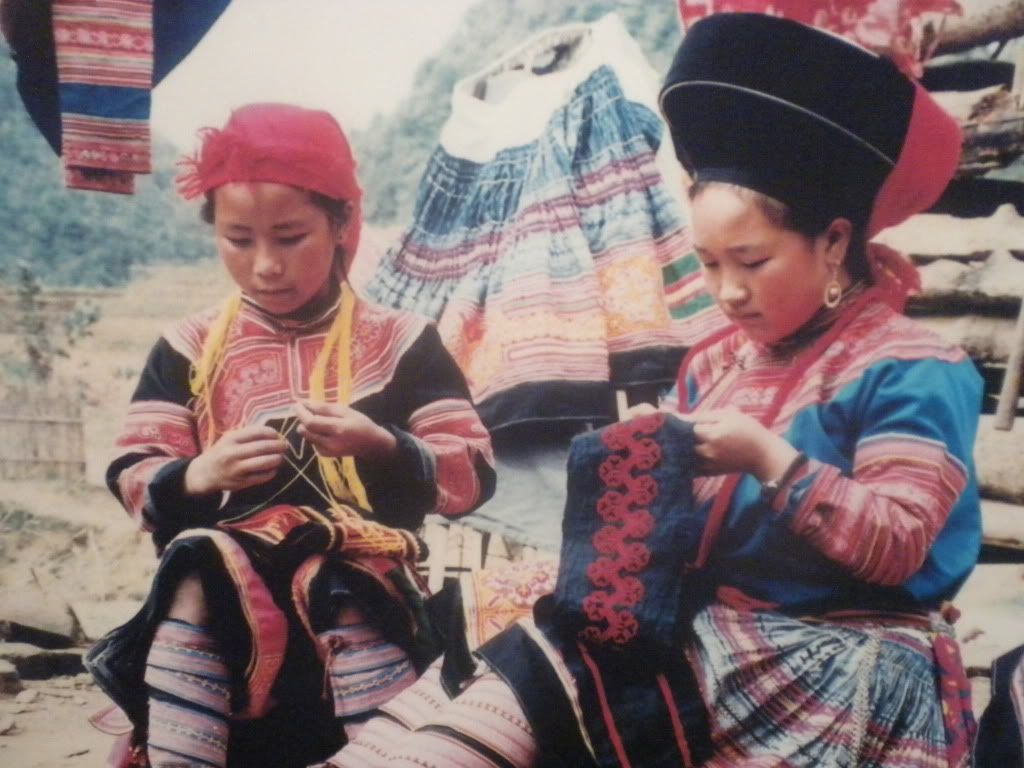
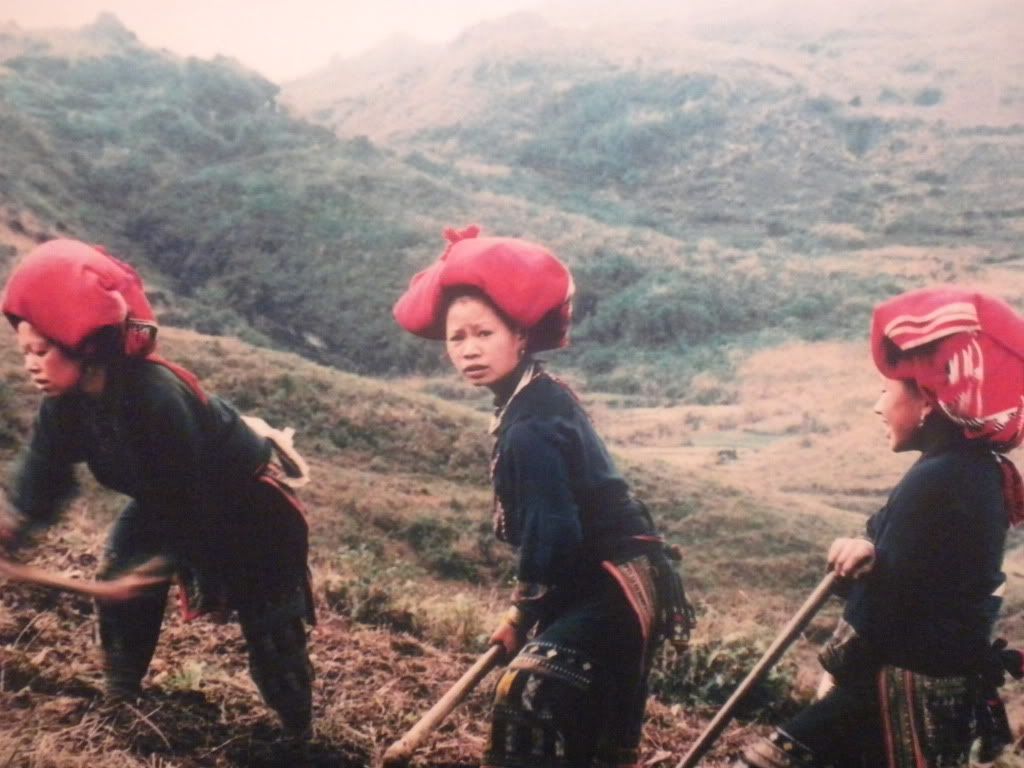
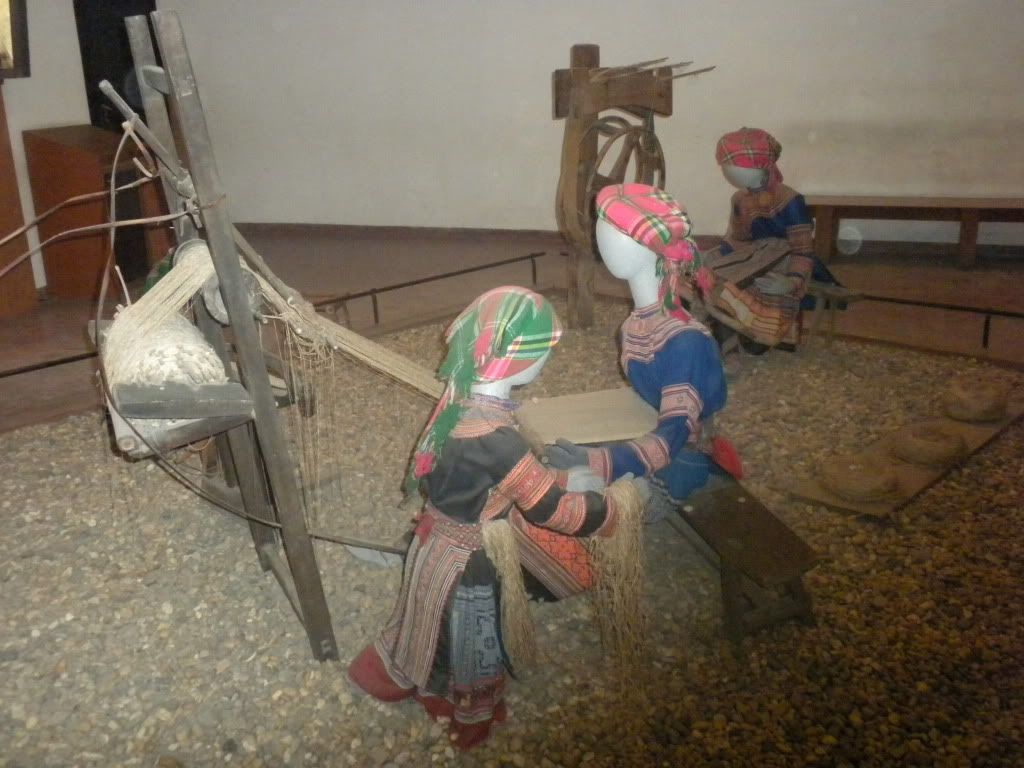
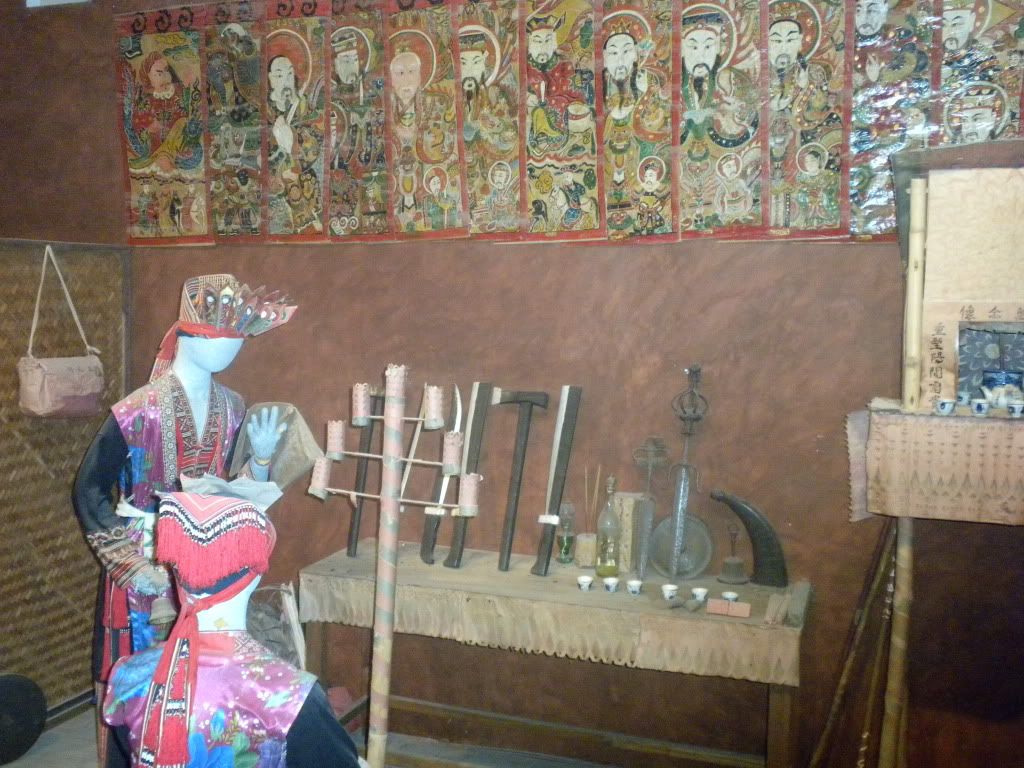
The Mon-Khmer people from the north practice shifting agriculture, returning periodically to the same field. The men also hunt as a hunter’s animal fur-bag proved. The Mon-Khmer also valued their art, as a bamboo monkey made us both laugh. Finally, a tiny Austronesian man from the Raglai ethnic group looked down on us from a picture showing him in his full (bare-naked) attire.
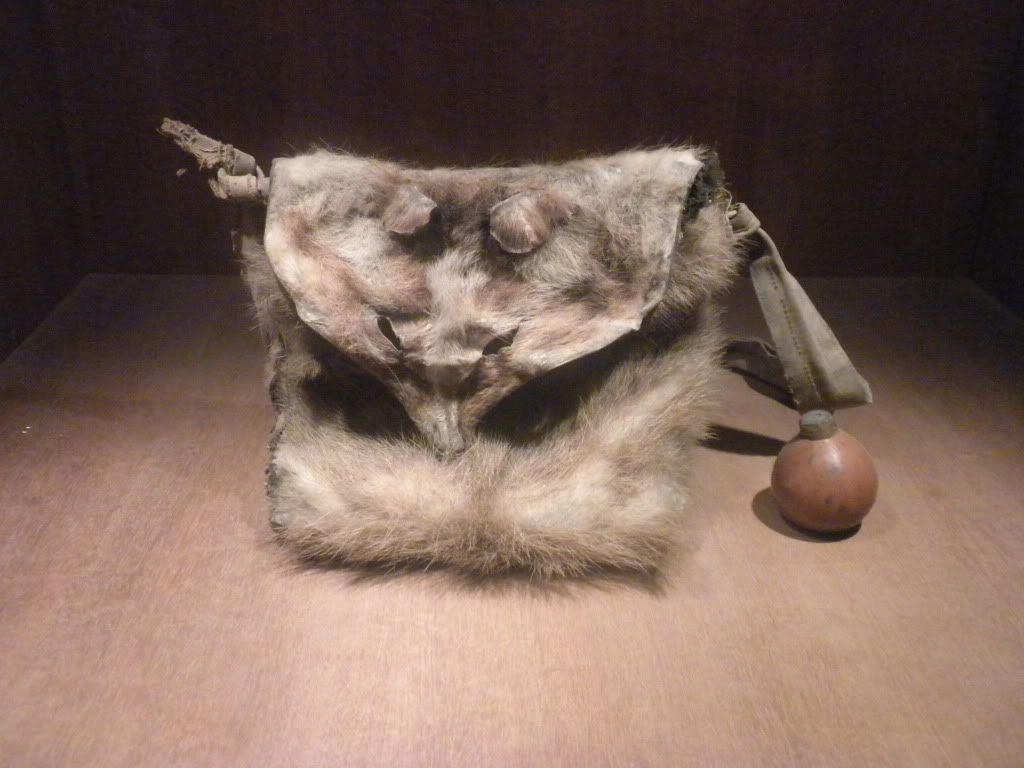
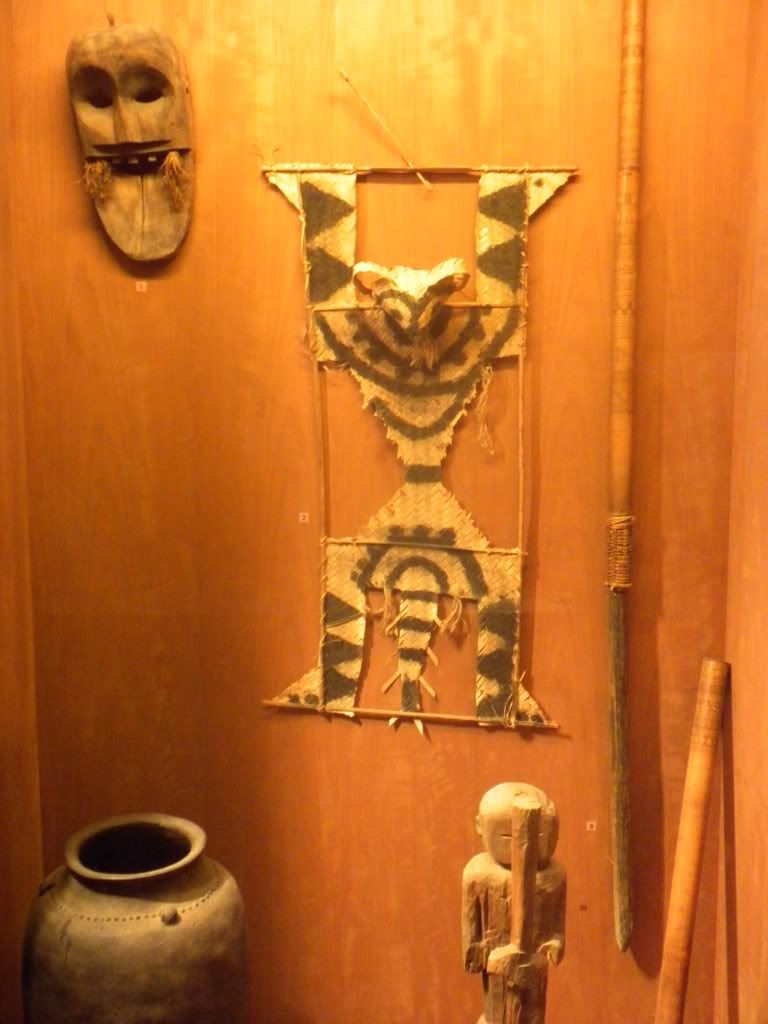

We were done with the exhibitions, and closing time was coming fast. However, there was a photo gallery that we still needed to see and we tried to walk through as fast as we could. I took a few pictures of some memorable pieces before we were kindly ushered to the exit. Once outside Francesca and I contemplated going to ‘dog street,’ a street with restaurants serving all sorts of dog dishes, but in the end we headed back to the hostel instead. An unpleasant surprise awaited us there… Apparently our bathroom had been leaking and we had to move out of the room so the owner could get it fixed. He offered to take us to his friend’s hotel, but we weren’t too pleased with the service so we tried to find something else. In the end, the long day had caught up with us and we went with the man’s friend. It turned out to be a good gamble because we got a spacious room with nice big beds for a good price. Unfortunately we couldn’t enjoy the new-found bliss for too long: we had a long journey the next day.
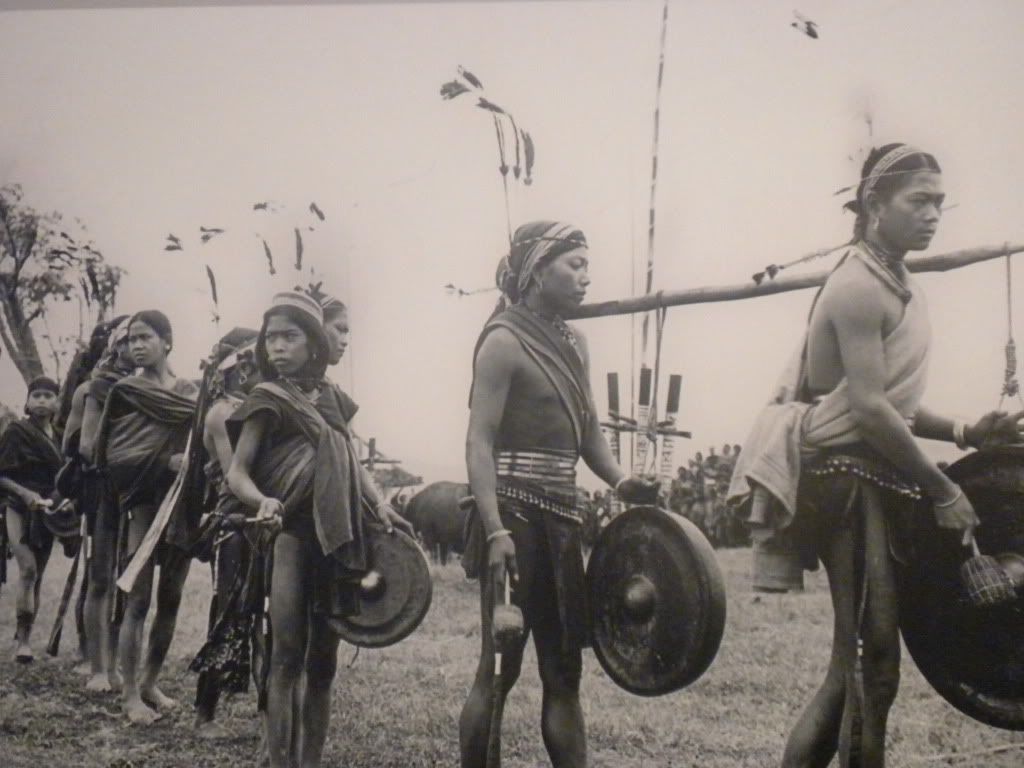



After walking through his ‘tomb’ we passed by the Presidential Palace. We couldn’t go inside, but we did get a few pictures of the building. Next we headed towards the Stilt House of Ho Chi Minh, passing through the cases which contained his old cars on our left hand side. The stilt house was actually pretty simple with just a writing desk, a small bed and some basic furniture standing around. We followed the crowds and ended up at the Ho Chi Minh Museum. The name gives the impression it’s all about Ho Chi Minh, but in fact that’s only partially true. A large bronze Uncle Ho greeted us when we entered. We saw some pictures of him and his family life, but then ended up in an artsy glass maze with paintings and drawings from all different eras. Another section was dedicated to Guernica. It definitely gave us an eerie feel. Perhaps this is the aim of the museum as it doesn’t so much as tell the story of Ho Chi Minh’s life per se; instead it tries to mimic the feeling of the time. A final section was reserved for the Communist Party and told its story.



Since the Museum only broadly covered Ho Chi Minh, here’s a little excerpt from the Wiki on the man:
“Ho Chi Minh was born Nguyen Sinh Cung and also known as Nguyen Ai Quoc (19 May 1890 – 3 September 1969) was a Vietnamese Communist revolutionary and statesman who was prime minister (1946–1955) and president (1945–1969) of the Democratic Republic of Vietnam (North Vietnam). Ho led the Viet Minh independence movement from 1941 onward, establishing the communist-governed Democratic Republic of Vietnam in 1945 and defeating the French Union in 1954 at Dien Bien Phu. He lost political power inside North Vietnam in the late 1950s, but remained as the highly visible figurehead president until his death. The former capital of South Vietnam, Saigon, after the Fall of Saigon, was renamed Ho Chi Minh City in his honor.”




We exited the Museum after having a hot dog and a drink and headed for the One-Pillar Pagoda. Or rather, a miniature replica of said pagoda. The original was first built in 1049 under the Ly dynasty in the likeness of a blooming lotus on its stem. I took a few pictures before leading Francesca on to our next destination.


The Van Mieu-Quoc Tu Giam (Temple of Literature of the National University) was built in 1070 by King Ly Nhan Nong for the training of educated men of his kingdom. After nearly 1000 years it still stands and we got to enter the grounds. We learned how the students had to spend 3 to 7 years at the university, with tests each month. They all studied Confucius’ texts, as well as specializations. For graduation they were examined by the King himself. Sounds like a good way to up the stress levels! The inner courtyard was home to the Doctor’s Stelae: large stone pedestals which recorded the names and native places of the graduates at the university. A total of 1307 graduates and 82 Royal exams are listed on the stelae. The stelae were held up by the ancient Vietnamese and Confucian symbol for longevity and education, the turtle.


More walking was to be had after we realized the rest of the compound had been sealed off for renovation. Luckily the Vietnam Fine Arts Museum wasn’t too far away. We weren’t sure what to expect of this museum exactly, but gave it a go anyway. It turned out we had to follow a little map which led us from fine arts from prehistoric times to the 21st century. We weren’t allowed to take any pictures, but I snuck a few in to give you an impression of the pieces we encountered. It took us well over an hour to make it back to present-day art, but we were fairly impressed by the museum.


Museum-day was far from over, and Uncle Ho greeted us once again at the Vietnam Military History Museum. A relatively compact white building loomed ahead as we walked past an old T54B Tank to go inside. The museum quickly covered a few ancient battles before serving the main dish: cool dioramas of Vietnam War scenes, pictures of the war, guns used during the war, helmets with many bullet holes, and even a crossbow used to kill enemies (to prove the Vietnamese inventiveness!).


Since the museum was pretty small we continued with the Hanoi Flag Tribune right next to the museum. The large stone watchtower had been built from 1805 to 1812 under King Gia Long of the Nguyen Dynasty, but in 1954 the Communist Party decided to use it for propaganda purposes, planting a national flag on top. We climbed all the way to the top via the tiny spiral staircase; once there we realized the view was not that fantastic. A piece of art made of scrap from fallen planes and tanks, surrounded by more planes and tanks (still in one piece) was the highlight. We also saw that the museum stretched out for a few more buildings. More to explore!


Even though the other 2 buildings were filled to the brim with pictures and artifacts we could make our way through pretty quickly. Translations were missing for most of the museum, so all we could do is take in the things we observed. The pictures did speak for themselves, as we saw more images of valiant VC and cowardly Americans, more VC heroics and American war crimes. We acknowledged the obvious one-sidedness, but were still left impressed.



We stumbled across a random temple on a busy street, found the Hanoi Towers and finally the Hoa Lo Prison. Hoa Lo Prison, or the Hanoi Hilton as the Americans mockingly called it, was the home of most of the Americans Prisoners of War during the Vietnam War. Its most famous inhabitant was John McCain, who lost the American presidential election to Obama not too long ago.


However, before McCain made his way to Hoa Lo the building had been taken over by the French in 1896. Formerly used for ceramics-making the French turned it into a prison for wayward Communists and Government members. Therefore the first section of the museum was dedicated to the hardships these Vietnamese endured. Malnutrition, torture and diseases were the leading causes of death during the following 40 years. We saw the cells where the real bad boys (and girls, as Francesca shows) were kept. Outside we learned the prison didn’t isolate the inmates all that well. An almond tree was the meeting place for the prisoners to discuss measures on fighting their captors. We learned that there were at least 2 successful escapes: 2 sewer doors with sawed-out stiles were proof of the escape route taken over half a century ago.



In the next section the prison female inmates were locked up. We saw torture materials in the form of bottles, barbed wire and sharpened bamboo; we could only imagine how they were used. Eeek! Right past the women’s cells were smaller cells, some of which had contained American PoWs. From French occupation we went to Vietnamese rule, checking out a memorial for the fallen during the French period.

The texts on the wall claimed that the “national economy was difficult but the Vietnamese government had created the best living conditions to U.S. pilots for they had a stable life during the temporary detention period.” There were pictures of rescued American pilots, amongst which we found a shot of McCain being dragged from his plane in a lake. There were happy Americans playing basketball and chess, receiving presents and letters from back home, and enjoying a filling Christmas dinner. Of course, the reality was a little different as we watched ‘Hanoi Hilton’ and read some stories by survivors of Hoa Lo. The truth is never black or white.



Closing time for the museums had come and Francesca and I were tired of walking. We hadn’t made use of the tricycle drivers in the city yet, but decided to do the tourist-thing and jumped in one to bike us back to our guesthouse. The poor old man looked like he was having a hard time biking us around, but he made it there eventually and he was happy with the tip I gave him.

The next morning we got up early once again to visit more educational and historical sites. Francesca got very excited to see the Vietnamese Women Museum, which focused solely on (surprise, surprise) Vietnamese women. However, it was closed. And was going to be closed for a few more months. Saddened by this news went on our way to the National Museum of Vietnamese History, passing by the Hanoi Opera House and the actual Hilton in Hanoi. We got our tickets and entered to look at the prehistoric period in Vietnam. There were some artistic impressions of what the area might have looked like at the time. There were sculptures of Neanderthals and other steps of the human evolution. We jumped forward in time to about 500 B.C. when the locals had entered the Bronze Age and were making giant bronze drums with intricate decorations. The drums reflected life at the time, pictures of houses, people dancing or making rice, the nature around them have all been preserved through the skill of these artists.


We followed the timeline and learned that around the same time people buried their dead in large stone jars. (Remember the Plain of Jars!) Several jars with bones and other artifacts had been found, supporting the theory that the Plain of Jars was in fact a burial site. We don’t know anymore… Next up were cool ancient earrings, old-school currency and little clay faces. We exited the Bronze Age, learning that the Viet people reached the height of their Bronze Age civilization with advanced agriculture, animal husbandry, fishing, pottery and weaving.

Francesca and I skipped a few centuries of Chinese rule and ended up checking out the several Dynasties that controlled the country. Here’s a short rundown of their progress from the Vietnam Wiki: “In 938 CE, a Vietnamese lord named Ngo Quyen defeated Chinese forces at the Bach Dang River and regained independence after a millennium under Chinese control. Renamed as Dai Viet (Great Viet), the nation went through a golden era during the Ly and Tran Dynasties. During the rule of the Tran Dynasty, Dai Viet repelled three Mongol invasions. Buddhism flourished and became the state religion.” We saw some examples of fine Buddhist art.

“Between the 11th and 18th centuries, Vietnam expanded southward in a process known as nam tien (southward expansion), and it eventually conquered the kingdom of Champa and part of the Khmer Empire. From the 1500s onwards, civil strife and frequent infighting engulfed much of Vietnam. First, the Chinese-supported Mac Dynasty challenged the Le Dynasty's power. After the Mac Dynasty was defeated, the Le Dynasty was reinstalled, but with no actual power. Power was divided between the Trinh Lords in the North and the Nguyen Lords in the South, who engaged in a civil war for more than four decades before a truce was called in the 1670s. During this time, the Nguyen expanded southern Vietnam into the Mekong Delta, annexing the Champa in the central highlands and the Khmer land in the Mekong.”

“The division of the country ended a century later when the Tay Son brothers defeated both and established their new dynasty. However, their rule did not last long and they were defeated by the remnants of the Nguyen Lords led by Nguyen Anh with the help of the French. Nguyen Anh unified Vietnam, and established the Nguyen Dynasty, ruling under the name Gia Long.”
History lessons now over, Francesca and I exited the museum and looked for the Geology Museum as well as the Vietnam Revolution Museum. Both appeared closed until 1:00 PM, so we had some time to kill. We walked around for an hour trying to find an old house that our map said should be nearby. The problem was that we couldn’t locate it and had to ask in a tour office if they could help us. When even the locals had no idea and we asked them if we could check Google we finally figured out it wasn’t where our map had shown us at all… Hour wasted, but time killed.
We headed back to the slick Vietnam Revolution Museum. This museum had a mildly interesting collection of paintings with the Vietnamese revolution from the early 30s as its backbone. Most pictures glorified Ho Chi Minh in one way or another. There were more pictures of French and American atrocities during the periods of oppression. By now we’d seen so much of this material that it started to leave far less of an impression. The paintings and the sculptures were a little more interesting. It still took us about an hour to go through the whole building.



The Geology Museum was a bit of a mystery on our list. Entrance was free, which, in a city where museums cost less than a dollar to enter seemed a sure sign of disappointment ahead. And indeed, for inside we found a large collection of rocks. Rocks, rocks, rocks, whole cabinets filled with rocks. Paintings of dinosaurs lined the walls and were much more spectacular than the contents of the glass cages. We did take the trouble to walk through all 3 (!!!) floors, but it didn’t take long and wasn’t worth it. Skip it unless you love rocks!

It was now almost 3:00 PM and we headed to the heart of the old city: the Hoan Kiem Lake. In the lake lies a small islet with the so-called Ngoc Son Temple, which is dedicated to Confucian and Taoist philosophers. Researchers are not sure when it was built exactly, but they found it was expanded in 1865 to its present state. We crossed the small bridge to the islet and learned about the legend of the lake. A King of old, King Le returned a magical sword to the tortoise genius that resided in the lake. People still believe the sword is there and from time to time tortoises are found in the water.


Francesca and I continued our walk in the Old Quarter of Hanoi and continued our search of the old house. We passed all the street vendors, made some inquiries about the water puppetry in Hanoi and discovered the traditional Viet house at 88 Ma May Street. We got some brochures and walked around the impressive two-story building. A bridal photo shoot was taking place and Francesca and I had a quick look at that scene as well. The little inner courtyard was a nice escape from all the hustle-bustle of ever-moving Hanoi. The family altar or altar of ancestors was something we’d seen before in the South.


Our final stop before heading back to the guesthouse was Bach Ma Temple. The map had listed this as a must-see as well, but to us it looked similar to any other temple we’d seen in Vietnam. In fact, in Hanoi alone there are over 600 temples and pagodas. Since they’d just scrubbed the floors we made our way across the slip-and-slide floor, where we had a quick look around before finally being able to rest our legs for the a while.
Our night wasn’t entirely over, since we’d bought tickets for the Water Puppetry, a famous tourist attraction in Hanoi. The tickets were cheap, so we ended up with some pretty good seats. As the little theatre filled up with foreigners Francesca and I read a little about this fine art:
“Water puppetry is a unique performing art created by the Viet people around the 10th century and is continued until today. The puppets are carved from light-weight, durable wood like the fig tree and painted with appropriate colors. The puppets portray lively and humorous characters. The performing stage is a roofed manipulation room called Thuy Dinh, which is built on the surface of the water and conceals the puppet artists. Standing in the water, the puppeteers manipulate the puppets using either an ensemble of supports or a system of strings to control a group of characters attached to a common support.
The presentation of the performance by the character Chu Teu is followed by scenes illustrating agricultural work, fishing, catching frogs, fox chasing a duck, fire-spitting snakes, wrestling, boxing, buffalo fighting, dragon and lion dancing, and old stories such as Thach Sanh and Tam Cam.”
And indeed, for an hour the puppeteers played out about 15 different scenes, whilst accompanied by a little orchestra and some voice-actors that only spoke Vietnamese. Not that we needed that; the brochure along with the pretty straightforward scenes didn’t make it very hard to understand what was being acted out. Francesca and I watched the show intently as the hour flew past and before we knew it it was all over again. We contemplated buying a puppet as a souvenir but realized it’d probably get squashed along the way so we kept the money in the pocket. Tired after a long day of walking we headed back to the guesthouse and slept soundly.









On the 30th we finally managed to treat ourselves to a little rest. We got up little later, ordered sandwiches a little later, and grabbed a taxi to the Vietnam Museum of Ethnology in the afternoon. The Museum of Ethnology consisted of two sections: an outdoor section with remakes of traditional tribes’ houses and huts, and an indoor section with further information about these tribes and others. We decided to spend our time outside first. The first house we came across was the Cham House. The Cham construct their dwellings out of wood, straw and mud. Depending on the wealth of the occupying family the house can consist of up to 5 different semi-detached buildings. Inside the house we found a lot of animist symbolism: fans representing the 4 seasons, turtles for longevity and the wish of many children, and representations of the 5 elements. We walked through the very basic sleeping quarters, wondering how comfortable it is to sleep without a mattress under your behind.

We followed the path to the next house, passing a ridiculously long (over 25 meters!) Cham junk which was once used for warfare. The next house was 50 meter high Bahnar Communal House. We entered via the tree-staircase, thoroughly impressed by the craftsmanship of the builders. The Bahnar Communal House traditionally functioned as a meeting hall for rituals, celebrations, and preparations for war or defense were made. This Communal House had been built by 29 Bahnar people in just 7 days. Traditionally it would take the villagers several years to prepare the materials and the location.


The Ede House was not quite as high as the Bahnar’s House, but what it lacked in height it certainly made up for in length. The whole thing was over 40 meters in length, standing on 1 meter high poles. We read that some of these houses can be over 200 meters long. Just imagine what a work-out you’d get cleaning your house! Unfortunately, nowadays the houses are rarely constructed anymore, exactly because they take up so much space. We headed up the staircase, which had carved images of the new moon and female breasts. Francesca and I inspected the living room, where the family shows off its wealth to visitors. We spotted beautifully carved beams and large wooden furniture around us. The longhouse was the residence of the matrilineal family, meaning daughters and granddaughters of one mother lived with their spouse in one house.



Next up was not a house, but a tomb. And not just any tomb: the Giarai Tomb was surrounded by large wooden sculptures of naked men and women during the act, pregnant women and even some animals. Apparently the Giarai (think they) are quite well-endowed, just look at the pictures! The inside of the tomb was not as impressive. The Cotu Tomb across the grass was altogether different from its Giarai counterpart. The whole thing was beautifully carved, with a little roof overhanging the little coffin.


The Tay House was again very different from the other houses we had seen so far. One half touched the ground, whilst the other half of it stood on much higher stilts. The whole thing was made mostly of bamboo. A very basic ancestral altar dominated the main room, whereas the section on stilts was reserved for the sleeping quarters. It all looked a bit dusty and dark, so we left the Tay House a little less impressed than the other ones.


The Hmong House that came next was much cooler. Outside we spotted a stable and a smithy, as Hmong men are famous for their forging skills. Hmong houses are built directly on the ground and made mostly out of wood. Even though the roof is tiled, the wooden tiles can be moved easily to let in sun when needed, and keep out rain when closed. Francesca was reading some information about the house when a volunteer came to her and started talking to her about the house. At first she was confused as she had no idea these people were around, but when she realized she was being given a short introduction she quickly turned around, called me and listened to the story. We learned how the Flower Hmong venerate three generations of ancestors. They do this with just 3 simple sheets of paper, which are replaced once a year during a ceremony.


The column of the house spirit is the most sacred place of the Hmong house, as it is this spirit’s dwelling. It symbolizes the family’s prosperity and good or bad fortune. Touching it is considered bad luck by the Hmong. In the little bedroom we saw a traditional Flower Hmong dress and another basic bed which I would’ve never fit in. On our way to the next house Francesca and I passed the pottery workshop, which had some cool works of art, but nothing to rave about.
Thus we entered the Hanhi House, made mostly of wood, but with walls covered in thick earth. Not only did it give the building a distinctly orange look, it also made it very unique and impressive. The Hanhi only build one door in their house and try to avoid adding too many windows, since they are afraid of cold winter winds. The house itself is divided into several sections, each with sleeping quarters for different family members. The central room consists of the kitchen, the family altar and the dinner table.



The Kinh (or Viet) House Complex was our final outdoor stop. One of the houses was dedicated to Water Puppetry, while another showcased old farming tools. Two others told the history of embroidery and weaving. Not terribly interesting, so we examined the main house of the Viet people. The family altar looked a little more advanced and decorated, the furniture a little more developed and the kitchen a tad more versatile. The little rock garden outside illustrates the harmony between ‘yin’ and ‘yang’ represented in the two elements of ‘rock’ and ‘water.’


Francesca and I had gotten quite hungry by now, so I made us some make-shift hotdogs, which we ate whilst we entered the museum. We learned there is a total of 54 ethnic groups in Vietnam that speak languages from 5 different linguistic families. We investigated the pictures and saw similarities between many groups that we’d encountered before on our trip. The next part of the museum was devoted to some of the larger ethnic groups, explaining some of their customs and traditions.
There was a display with a lady making conical hats, a tradition practiced by the Viet people, amongst others. A bike absolutely stuffed with bamboo fishing traps made Francesca wonder if I could bike that around. I think I could! Similar to other ethnological museums we’d seen there was also a large collection of pictures here. Most of the pictures showed the local people in their own villages, near traditional houses, wearing traditional clothes. Francesca and I saw how the Tho make their own clothes from hemp.




After this first section of the museum we wandered into a somewhat random section of contemporary Aboriginal art. We checked the temporary exhibition out and quickly went upstairs to see more Vietnamese culture. The room we entered had a colorful Thai ancestral altar. We entered a Black Thai house displaying a traditional scene in the lives of the inhabitants. Francesca and I were both intrigued by the Thai ritual tree outside, which are built in honor of protective spirits and made of bamboo, decorated with dyed paper animals. The walls behind the tree had examples of intricately carved windows from a Thai stilt house. Use of these wooden windows indicated wealth, as the poor just had bamboo windows. ‘Khau cut’ serve as damage reduction during heavy storms, as well as signals for social status.






The next room covered another language group of ethnic people, starting with the Dao. Francesca and I both admired the Dao’s mask for a shaman’s initiation ritual. We also crossed paths with the Hmong again. The Red Dzao are a group I’ll talk a little more about when we got to meet them in a coming post. We followed the halls to the next room and found ourselves looking at rice cultivators from the mountains north of Vietnam. The Red Yao’s (yes, the names get confusing!) initiation rite into manhood taught us the Yao greatly value their Chinese heritage as the boys are forced to learn to write and read Chinese characters before they can become men.





The Mon-Khmer people from the north practice shifting agriculture, returning periodically to the same field. The men also hunt as a hunter’s animal fur-bag proved. The Mon-Khmer also valued their art, as a bamboo monkey made us both laugh. Finally, a tiny Austronesian man from the Raglai ethnic group looked down on us from a picture showing him in his full (bare-naked) attire.



We were done with the exhibitions, and closing time was coming fast. However, there was a photo gallery that we still needed to see and we tried to walk through as fast as we could. I took a few pictures of some memorable pieces before we were kindly ushered to the exit. Once outside Francesca and I contemplated going to ‘dog street,’ a street with restaurants serving all sorts of dog dishes, but in the end we headed back to the hostel instead. An unpleasant surprise awaited us there… Apparently our bathroom had been leaking and we had to move out of the room so the owner could get it fixed. He offered to take us to his friend’s hotel, but we weren’t too pleased with the service so we tried to find something else. In the end, the long day had caught up with us and we went with the man’s friend. It turned out to be a good gamble because we got a spacious room with nice big beds for a good price. Unfortunately we couldn’t enjoy the new-found bliss for too long: we had a long journey the next day.


0 Comments:
Post a Comment
<< Home